Brazilian wandering spiders: Bites & other facts
The spider's name means "murderess" in Greek, which is appropriate for the deadly arachnid.


Classification/taxonomy
Size & characteristics, bites and venom, additional resources.
The Brazilian wandering spider, also called armed spiders or banana spiders, belongs to the genus Phoneutria , which means "murderess" in Greek. And it's no wonder why — it's one of the most venomous spiders on Earth . Its bite, which delivers neurotoxic venom, can be deadly to humans, especially children, although antivenom makes death unlikely.
Guinness World Records has previously named the Brazilian wandering spider the world's most venomous spider multiple times (though the current record-holder is the Sydney funnel-web spider, Atrax robustus , according to Guinness ). But, as the late Jo-Anne Sewlal, who was an arachnologist at the University of the West Indies in Trinidad and Tobago, told Live Science, "classifying an animal as deadly is controversial," as the amount of damage depends on the amount of venom injected.
Jo-Anne Sewlal was a noted arachnologist from Trinidad and Tobago. While completing her PhD, she received the National Institute of Higher Education, Research, Science and Technology (NIHERST) 2012 Award for Excellence in Science and Technology for Junior Scientist. In 2013, She received a doctorate in zoology from the University of the West Indies. She discovered several species of spiders in her home country, surveyed the arachnids across several countries the Caribbean and appeared as an expert on the topic on The Science Channel. She died of an allergic reaction in January 2020.
There are nine species of Brazilian wandering spider, all of which are nocturnal and can be found in Brazil. Some species also can be found throughout Central and South America, from Costa Rica to Argentina, according to a 2008 article in the journal American Entomologist . Study author Richard S. Vetter, a research associate in the department of entomology at the University of California, Agriculture and Natural Resources, wrote that specimens of these powerful arachnids have been mistakenly exported to North America and Europe in banana shipments. However, Vetter noted, in many cases of cargo infestation, the spider in question is a harmless banana spider (genus Cupiennius ) that is misidentified as a Phoneutria . The two types of spiders look similar.
The taxonomy of Brazilian wandering spiders, according to the Integrated Taxonomic Information System (ITIS) , is:
Kingdom : Animalia Subkingdom : Bilateria Infrakingdom : Protostomia Superphylum : Ecdysozoa Phylum : Arthropoda Subphylum : Chelicerata Class : Arachnida Order : Araneae Family : Ctenidae Genus : Phoneutria
- Phoneutria bahiensis
- Phoneutria boliviensis
- Phoneutria eickstedtae
- Phoneutria fera
- Phoneutria keyserlingi
- Phoneutria nigriventer
- Phoneutria pertyi
- Phoneutria reidyi
- Phoneutria depilata , according to a 2021 study published in the journal ZooKeys , which found that Phoneutria boliviensis actually included two separate species from different habitats.
Brazilian wandering spiders are large, with bodies reaching up to 2 inches (5 centimeters) and a leg span of up to 7 inches (18 cm), according to the Natural History Museum in Karlsruhe, Germany. The species vary in color, though all are hairy and mostly brown and gray, although some species have lightly colored spots on their abdomen. Many species have bands of black and yellow or white on the underside of the two front legs, according to the University of Florida .
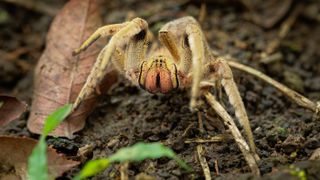
These arachnids "are called wandering spiders because they do not build webs but wander on the forest floor at night, actively hunting prey," Sewlal told Live Science in an interview conducted in 2014, before her death. They kill by both ambush and direct attack.
They spend most of their day hiding under logs or in crevices, and come out to hunt at night. They eat insects, other spiders and sometimes, small amphibians, reptiles and mice.
Research into one species of Brazilian wandering spider, Phoneutria boliviensis , revealed that these spiders eat a mix of arthropods and reptiles. DNA metabarcoding, a technique that examines the DNA and RNA in a sample, of the guts of 57 spiders identified 96 prey species, including flies, beetles, butterflies, moths, grasshoppers, locusts and crickets, according to research from the University of Tolima and the University of Ibagué in Colombia . Some of the female spiders also ate lizards and snakes.
While their bites are powerful and painful, "their bites are a means of self-defense and only done if they are provoked intentionally or by accident," Sewlal said.

In the Brazilian wandering spider, just as in most spider species, the female is larger than the male. Males approach females cautiously when attempting to mate, according to the biology department at the University of Wisconsin-La Crosse . Males perform a dance to get females' attention, and males often fight each other over the female. The female can be picky, and she often turns down many males before choosing a mating partner. Once she does pick one, the male needs to watch out; females often attack the males once copulation is finished.
The female then can store the sperm in a separate chamber from the eggs until she is ready to fertilize them. She will lay up to 1,000 eggs at a time, which are kept safe in a spun-silk egg sac.
Brazilian wandering spiders typically live for one or two years.
Brazilian wandering spiders' venom is a complex cocktail of toxins, proteins and peptides, according to the Natural History Museum in Karlsruhe, Germany. The venom affects ion channels and chemical receptors in victims' neuromuscular systems.
After a human is bitten by one of these spiders, he or she may experience initial symptoms such as severe burning pain at the site of the bite, sweating and goosebumps, Sewlal said. Within 30 minutes, symptoms become systemic and include high or low blood pressure , fast or a slow heart rate , nausea, abdominal cramping, hypothermia, vertigo, blurred vision, convulsions and excessive sweating associated with shock. People who are bitten by a Brazilian wandering spider should seek medical attention immediately.
Their venom is perhaps most famous for triggering painful and long-lasting erections . For that reason, in a 2023 study, scientists reported that they were testing the venom in humans as a potential treatment for erectile dysfunction in those for whom Viagra didn't work.
However, these bites are rare, and envenomations, or exposure to these toxins from a spider bite, are usually mild, Vetter said. For instance, a 2000 study in the journal Revista do Instituto de Medicina Tropical de São Paulo found that only 2.3% of people with bites who came to a Brazilian hospital over a 13-year period were treated with antivenom. (The other bites did not contain enough venom to require it.) Most of the bites were from the species P. nigriventer and P. keyserlingi in eastern coastal Brazil. About 4,000 bites reportedly happen each year in Brazil, but only 0.5% of those cases are severe, according to a 2018 study in the journal Clinical Toxinology in Australia, Europe, and Americas . Meanwhile, 15 deaths have been attributed to Phoneutria in Brazil since 1903, the 2018 study reported.
"It is unlikely that the spider would inject all of its venom into you, as this venom is not only needed as a means of defense but to immobilize prey," Sewlal said. "So if it did inject all of its venom, it [would] have to wait until its body manufactured more before it could hunt." That would also leave the spider vulnerable to being attacked by predators.
Furthermore, Sewlal pointed out that venom production requires a lot of a spider's resources and time. "So if the spider were to attack frequently and use up all of its venom, it [would] be safe to assume that it has a ready food supply to replace the energy and resources used. This situation does not exist in the wild."
- Learn more about Brazilian wandering spiders from the University of Wisconsin-La Crosse .
- Read about several species of Brazilian wandering spiders, including several images of the arachnids at the University of Florida .
- Find a spider in your bananas? It may or may not be a deadly species, according to the University of California, Riverside .
This article was originally published on Nov. 20, 2014.
Sign up for the Live Science daily newsletter now
Get the world’s most fascinating discoveries delivered straight to your inbox.
Jessie Szalay is a contributing writer to FSR Magazine. Prior to writing for Live Science, she was an editor at Living Social. She holds an MFA in nonfiction writing from George Mason University and a bachelor's degree in sociology from Kenyon College.
- Laura Geggel Editor
Giant, invasive Joro spiders with 6-foot webs could be poised to take over US cities, scientists warn
Diving bell spider: The only aquatic arachnid that creates a web underwater to live in
Uranus and Neptune aren't made of what we thought, new study hints
Most Popular
By Anna Gora December 27, 2023
By Anna Gora December 26, 2023
By Anna Gora December 25, 2023
By Emily Cooke December 23, 2023
By Victoria Atkinson December 22, 2023
By Anna Gora December 16, 2023
By Anna Gora December 15, 2023
By Anna Gora November 09, 2023
By Donavyn Coffey November 06, 2023
By Anna Gora October 31, 2023
By Anna Gora October 26, 2023
- 2 Watch live! The total solar eclipse has begun over North America.
- 3 Eclipse from space: See the moon's shadow race across North America at 1,500 mph in epic satellite footage
- 4 Superfast drone fitted with new 'rotating detonation rocket engine' approaches the speed of sound
- 5 Neolithic women in Europe were tied up and buried alive in ritual sacrifices, study suggests
- 2 Superfast drone fitted with new 'rotating detonation rocket engine' approaches the speed of sound
- 3 Neolithic women in Europe were tied up and buried alive in ritual sacrifices, study suggests
- 4 Pet fox with 'deep relationship with the hunter-gatherer society' buried 1,500 years ago in Argentina
- 5 No, you didn't see a solar flare during the total eclipse — but you may have seen something just as special
Can a Bite From a Brazilian Wandering Spider Cause a Four-Hour Erection?
In many cases, the erection is merely an early warning before the complete shutdown of multiple organ systems., alex kasprak, published aug. 16, 2023.

About this rating
On Aug. 14, 2023, the account First Doctor posted what it asserted to be an "exclusive" finding on the social media platform X, formerly known as Twitter:
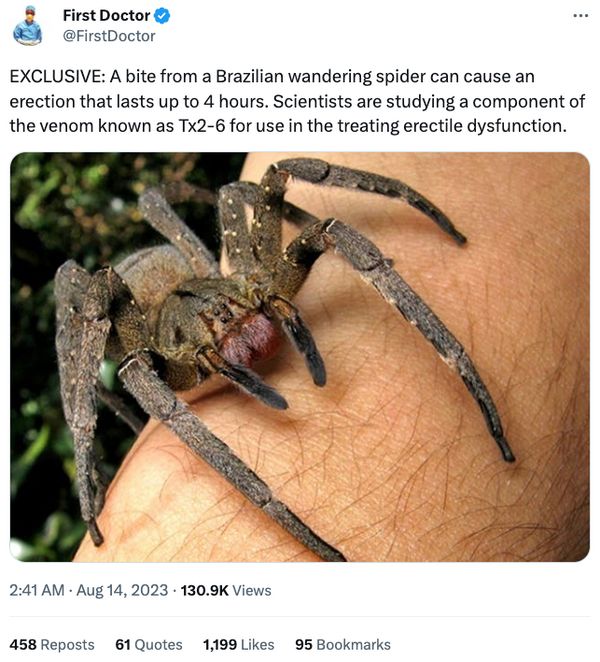
While far from an exclusive — or even a remotely new — finding, the two claims in the tweet were factual. A bite from Phoneutria nigriventer , commonly known as the Brazilian wandering spider, can indeed result in a long-lasting and painful erection, a condition known as priapism when it lasts more than four hours .
While the toxicity and high risk of death posed by the chemical thought to be responsible for the erections makes its use as a potential erectile dysfunction (ED) therapy challenging, if not literally impossible , it has been used to develop similar chemicals that may have therapeutic potential.
Phoneutria nigriventer 's erection-causing effects have been known to science since the 1970s. The 1971 book "Venemous Animals and Their Venom" described priapistic effects of this spider's bite on mice and dogs. The authors also included anecdotal reports from humans who had been bitten:
A pattern which resembles that of dog envenomation is also noticed in humans bitten by Phoneutria nigriventer: local unbearable pain, salivation, visual disturbances, sweating, prostration, priapism, and death.
Research published in 2008 identified the chemical within the venom likely responsible for the erections — a peptide now named PnTx2-6. "[Pn]Tx2-6 enhanced erectile function in [...] rats, via the [Nitrous Oxide] NO pathway," the study reported. "Our studies suggest that [Pn]Tx2-6 could be important for development of new pharmacological agents for treatment of erectile dysfunction."
The interest in this toxin as a treatment for ED stems, in part, because it operates in a completely different way than common ED treatments like Viagra, as reported in 2011 by NBC News:
Viagra, Levitra and other ED drugs on the market work by inhibiting an enzyme called PDE5. To get an erection, a man's body must release nitric oxide, which relaxes the smooth muscle around the arteries of the penis, allowing for his blood vessels to dilate. The nitric oxide is a first step in a series of chemical reactions that allow this muscle relaxation to take place. One step in the series is cGMP, a signaling molecule that acts to keep the muscles relaxed. PDE5 degrades cGMP. That's a good thing for ensuring that erections don't last forever, but too much PDE5 can mean an erection doesn't happen at all. By blocking the enzyme, PDE5 inhibitors solve the problem. The spider toxin works differently. Instead of affecting PDE5, the compound seems to trigger nitric oxide release, acting directly to relax the smooth muscles. Because about 30 percent of patients don't respond to PDE5 inhibitors, the toxin could provide an alternative to ED treatments currently on the market, [Study author Kenia] Nunes said."
In 2022, the same research group responsible for identifying PnTx2-6 published a paper arguing, in part, that due to the extreme pain and high toxicity of the chemical, its "therapeutic use is impossible," but that it is "an excellent pharmacological tool for studying erectile function." That study synthesized a new peptide, PnPP-19, based on the toxic original.
Based on studies performed on laboratory mice, PnPP-19 appears to have the potential to cause erections without the pain or toxicity of the spider venom:
This synthetic peptide also potentiates erectile function via NO/cGMP, but it [...] displays nontoxic properties in animals even at high doses. PnPP-19 effectively potentiates erectile function not only after subcutaneous or intravenous administration but also following topical application.
The assertions in First Doctor's post were factual because the priapism caused by Phoneutria nigriventer's bites have been well-documented and well-studied for decades and because the active ingredients in that venom have been used to investigate new ED therapies. As such, we rate the claim as "True."
Bücherl, Wolfgang, and Eleanor E. Buckley. Venomous Animals and Their Venoms: Venomous Invertebrates. Elsevier, 2013.
Nunes, K. P., et al. "Tx2-6 Toxin of the Phoneutria Nigriventer Spider Potentiates Rat Erectile Function." Toxicon : Official Journal of the International Society on Toxinology, vol. 51, no. 7, June 2008, pp. 1197–206. PubMed Central, https://doi.org/10.1016/j.toxicon.2008.02.010.
Silberman, Michael, et al. "Priapism." StatPearls, StatPearls Publishing, 2023. PubMed, http://www.ncbi.nlm.nih.gov/books/NBK459178/.
Silva, Carolina Nunes da, et al. "From the PnTx2-6 Toxin to the PnPP-19 Engineered Peptide: Therapeutic Potential in Erectile Dysfunction, Nociception, and Glaucoma." Frontiers in Molecular Biosciences, vol. 9, 2022. Frontiers, https://www.frontiersin.org/articles/10.3389/fmolb.2022.831823.
"Spider Venom Shows Promise for Treating Erectile Dysfunction." NBC News, 7 Sept. 2012, http://www.nbcnews.com/health/health-news/spider-venom-shows-promise-treating-erectile-dysfunction-flna1B5794477.
By Alex Kasprak
Alex Kasprak is an investigative journalist and science writer reporting on scientific misinformation, online fraud, and financial crime.
Article Tags

Wellcome to SpiderZoon
- Spider Facts
Brazilian Wandering Spider: Size, Bite, Diet and Other Facts
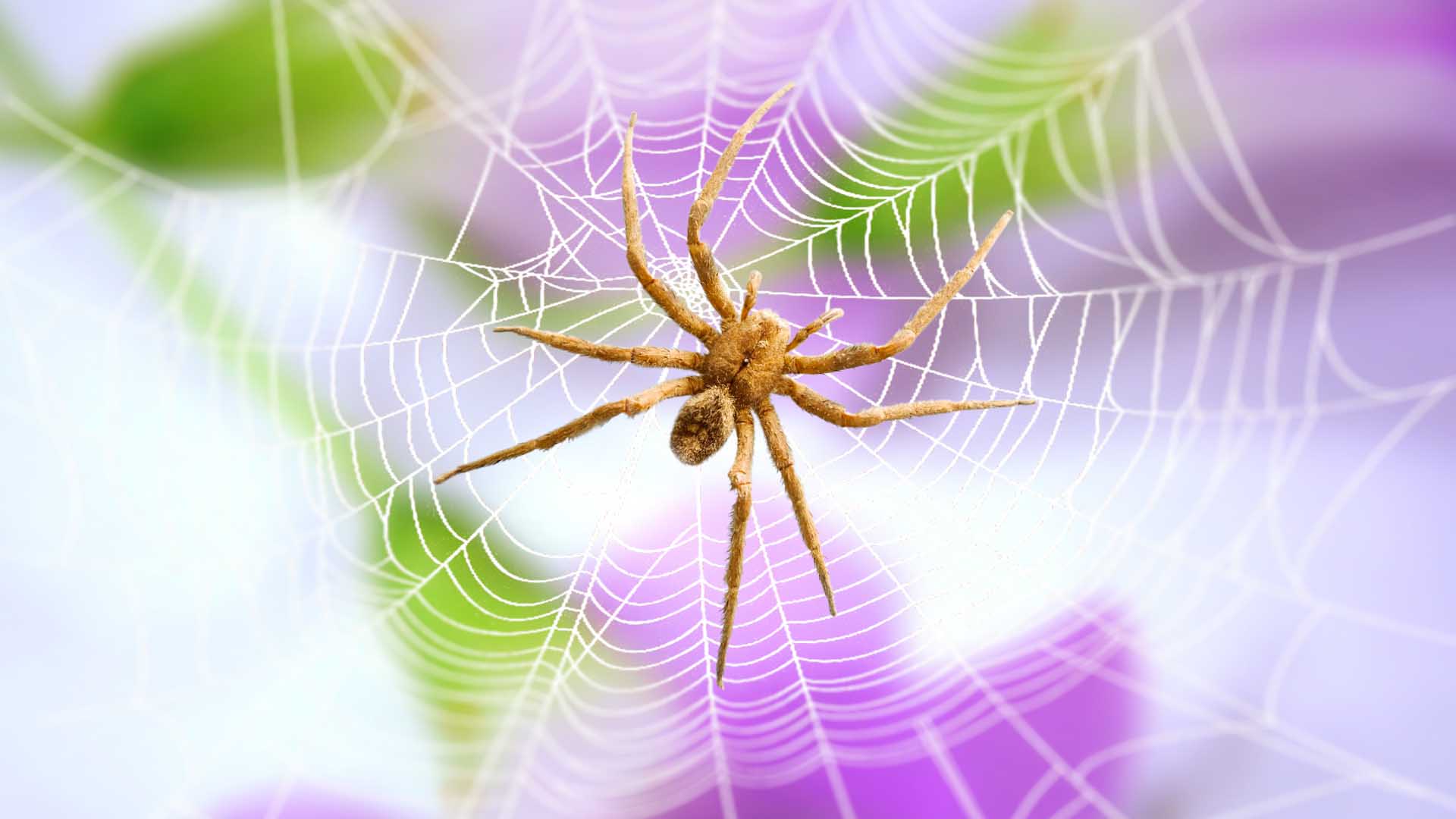
The Brazilian Wandering Spider is a venomous arachnid with a fearsome reputation. This South American rainforest dweller packs a powerful punch, but don’t let its nickname “banana spider” fool you – they’re active hunters, not web-spinners. Despite their size and venom, bites are uncommon as they’re typically shy.
The Brazilian Wandering Spider has garnered significant attention due to its potent venom, which makes it one of the world’s most venomous spiders. Understanding its biology and behavior is crucial for both scientific research and public safety.
Table of Contents
Scientific classification
The Brazilian Wandering Spider belongs to the family Ctenidae within the order Araneae. Its scientific classification is as follows:
- Kingdom: Animalia
- Phylum: Arthropoda
- Class: Arachnida
- Order: Araneae
- Family: Ctenidae
- Genus: Phoneutria
The Brazilian Wandering Spider goes by various common names, including “armed spider,” “banana spider,” and “wandering spider.” Synonyms for this species may include Ctenus , which was formerly used for some Phoneutria species.
Distribution and habitat
Distribution:
- South American: Found throughout most of South America east of the Andes mountains, including countries like Brazil (their namesake), Argentina, Paraguay, and up into northern regions.
- Central American Touch: A few species even reach southern Central America.
- Rainforest Dwellers: Primarily found in the lush rainforests of South America.
- Not Picky Places: They can also adapt to other habitats like the Atlantic Forest and even some urban areas.
- Daytime Hideouts: While they wander at night, they seek shelter during the day in places like termite mounds, under rocks, or even (unintentionally) in bananas!
Physical Characteristics
size and weight.
The Brazilian wandering spider is a creepy crawly giant. Their bodies can grow up to 2 inches (5 centimeters) long, but that’s not the scary part. Their legs can span a whopping 7 inches (18 cm), making them look even bigger. They are one of the biggest true spiders by body weight and size.
Despite their impressive leg span, Brazilian wandering spiders are relatively light. They only weigh around 6 grams, which is about the same as two pennies. While they might look imposing, they’re not the heaviest arachnids around.
Coloration and markings
These spiders exhibit a range of colors, including brown, black, and sometimes reddish hues. They often have distinctive markings on their bodies, which can vary between species. These markings may include stripes or patterns that serve as a key identification feature.
Notable features
One of the most notable features of the Brazilian Wandering Spider is its elongated, robust body and long, agile legs. They have sharp fangs, which they use to inject venom into their prey or in self-defense.
Sexual dimorphism
Sexual dimorphism is evident in this species. Females are larger and bulkier than males, while males have longer, more slender legs. Additionally, males possess specialized structures known as pedipalps, which are used during mating.
In the following sections of this article, we will delve deeper into the behavior, venom, and ecological role of the Brazilian Wandering Spider, shedding light on why this species has both fascinated and instilled fear in those who encounter it.
Behavior and Ecology
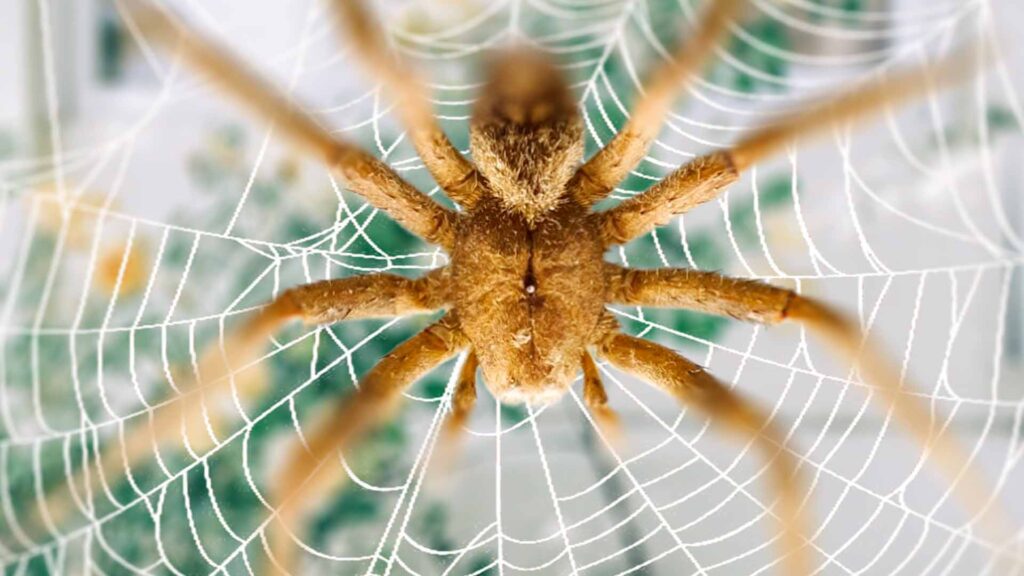
Nocturnal habits
Brazilian Wandering Spiders are primarily nocturnal creatures. They are most active during the night, venturing out of their daytime hiding places to hunt for prey and engage in mating activities. Their nighttime activity allows them to avoid predators and reduce the risk of desiccation in the hot tropical sun.
Hunting and feeding behavior
These spiders are agile hunters and primarily feed on insects, small vertebrates, and other arachnids. They do not build webs to capture prey but instead rely on their excellent senses, including acute vision and touch, to locate and stalk their victims. They often wander in search of food and are known for their swift and lethal strikes. Once they subdue their prey, they inject venom to immobilize it before feeding.
Brazilian Wandering Spiders (Phoneutria) are active hunters and have distinctive feeding behaviors. Here’s an overview of their feeding habits:
- Active Predators: Brazilian Wandering Spiders are not web-builders like many other spider species. Instead, they are active predators. They actively roam their environment in search of prey rather than waiting for insects to stumble into a web.
- Hunting Strategy: When hunting, these spiders use their excellent senses, including acute vision and touch, to locate potential prey. They are known for their agility and speed, which they use to stalk and capture their victims. They have sharp fangs, which they use to deliver a venomous bite to immobilize their prey.
- Diet: Their diet consists primarily of insects and other arthropods, but they are opportunistic feeders and may consume a variety of small creatures, including small vertebrates such as frogs and lizards when the opportunity arises.
- Venom Use: Brazilian Wandering Spiders inject venom into their prey to immobilize and partially digest it. Their venom contains neurotoxins that affect the nervous system of their victims. Once the prey is incapacitated, the spider can feed on it at its leisure.
- Feeding Process: After subduing their prey with a venomous bite, the spider uses its chelicerae (fangs) to break down the prey’s tissues. The venom also helps in predigestion, turning the prey’s insides into a semi-liquid form that the spider can ingest. They can consume both the internal fluids and solid parts of their prey.
- Frequency of Feeding: The frequency of feeding can vary depending on factors such as the availability of prey and the spider’s size. Generally, they need to feed periodically to sustain their energy and growth. Spiderlings may require more frequent meals to support their rapid growth, while adults can go longer periods between meals.
Overall, the Brazilian Wandering Spider’s feeding strategy is well-suited for their active and wandering lifestyle, allowing them to efficiently capture and consume a variety of prey in their natural habitat.
Role in the ecosystem
The Brazilian Wandering Spider plays a vital role in controlling insect populations within its habitat. By preying on a variety of insects and other small creatures, they help maintain ecological balance. Additionally, their presence in the rainforest ecosystem contributes to the overall biodiversity and food web.
Mating and reproduction
Mating in Brazilian Wandering Spiders is a complex and potentially dangerous process. Male spiders must carefully approach and court a receptive female to avoid being mistaken for prey. They use specialized pedipalps to transfer sperm to the female’s reproductive organs. After successful mating, females lay egg sacs containing hundreds of eggs. They guard these sacs and ensure the survival of their offspring until they hatch.
Lifespan and growth
The lifespan of Brazilian Wandering Spiders varies between males and females. Males generally have a shorter lifespan, typically living for a few months to a year after reaching maturity. Females, on the other hand, can live for several years. The growth of these spiders involves a series of molts, during which they shed their exoskeletons to accommodate their increasing size. Molting is a vulnerable period in their lives as their new exoskeleton is initially soft and requires time to harden.
Venom and Envenomation
Composition of venom.
The venom of Brazilian Wandering Spiders is a complex mixture of neurotoxins, cytotoxins, and other enzymes. One of the most significant components is a neurotoxin called PhTx3, which targets the nervous system of their prey.
Toxicity and effects on humans
The venom of these spiders is highly potent and can be lethal to their prey. In humans, envenomation can cause a range of symptoms, including intense pain, muscle cramps, fever, nausea, and in severe cases, paralysis and death. It’s important to note that while their venom is potent, actual fatalities from Brazilian Wandering Spider bites are rare due to the availability of medical treatment.
First aid and medical treatment
In the event of a Brazilian Wandering Spider bite, immediate medical attention is crucial. First aid measures may include cleaning the wound and applying ice to reduce pain and swelling. However, the primary treatment involves antivenom, which can counteract the effects of the spider’s venom.
Cases of envenomation and fatalities
Although fatalities from Brazilian Wandering Spider bites are uncommon, there have been documented cases of severe envenomation, especially in regions where medical treatment is not readily available. These spiders are generally non-aggressive and will bite humans only in self-defense when provoked, or if they feel cornered.
Understanding the behavior, ecology, and venomous nature of the Brazilian Wandering Spider is crucial for both scientific research and public awareness, helping to minimize the risk of envenomation and promote coexistence with this remarkable but potentially dangerous arachnid.
Brazilian wandering spider life cycle
The Brazilian wandering spider has a fascinating life cycle that revolves around hunting and motherhood. Here’s a breakdown:
- Egg Haven: After mating, the female lays hundreds, sometimes even a thousand, eggs in a silken sac. This becomes their protected nursery.
- Tiny Terrors: Hatching from the eggs emerge translucent spiderlings called larvae.
- Nymph Stage: The larvae molt a few times, transforming into nymphs. Think of them as mini-adults but without the ability to reproduce yet.
- Shedding for Size: As nymphs grow, they undergo multiple molts, shedding their outer shell to accommodate their larger bodies.
- Ready to Roam: After the final molt, the spider emerges as a full-fledged adult, complete with reproductive organs. Now, they can join the wandering lifestyle and continue the cycle.
The life cycle begins when a female Brazilian Wandering Spider lays her eggs. She typically creates an egg sac made of silk and deposits it in a concealed location, such as a tree hollow or leaf litter. Inside the sac, she may lay hundreds of eggs. The female guards the egg sac and ensures its protection until the spiderlings hatch. The duration of the egg stage varies depending on environmental conditions but generally lasts for a few weeks.
Spiderling Stage
After the incubation period, spiderlings (young spiders) emerge from the egg sac. They are extremely vulnerable at this stage and rely on their mother’s protection and guidance. Spiderlings are miniature versions of adult spiders but lack the full coloration and size. They disperse from the nest once they have molted and are capable of hunting on their own. During this stage, they grow rapidly by molting, shedding their exoskeletons to accommodate their increasing size.
Juvenile Stage
As spiderlings continue to molt and grow, they progress into the juvenile stage. During this phase, their coloration becomes more distinct, and they start to develop the characteristic features of adult Brazilian Wandering Spiders. They become increasingly independent and begin to exhibit hunting behaviors. The duration of the juvenile stage can vary but often lasts several months.
Sub-Adult Stage
The sub-adult stage is an intermediate phase between juvenile and adult. At this point, the spiders are closer in size and appearance to adults but have not yet reached sexual maturity. They continue to molt, with the frequency of molting gradually decreasing as they approach adulthood. Sub-adult spiders may exhibit more territorial behaviors as they compete for resources and prepare for eventual mating.
Adult Stage
Upon reaching sexual maturity, Brazilian Wandering Spiders enter the adult stage. This is when they are fully developed and capable of reproduction. Females are larger and bulkier than males, and males possess specialized structures called pedipalps, which they use during mating. Adult spiders engage in mating activities, and females lay eggs to continue the life cycle. Adult Brazilian Wandering Spiders can live for several years, with females typically having longer lifespans than males.
Understanding the life cycle of these spiders is essential for studying their behavior, reproductive biology, and population dynamics. It also provides insights into their adaptation strategies in the complex ecosystems of South and Central America.
Brazilian Wandering Spider Bite
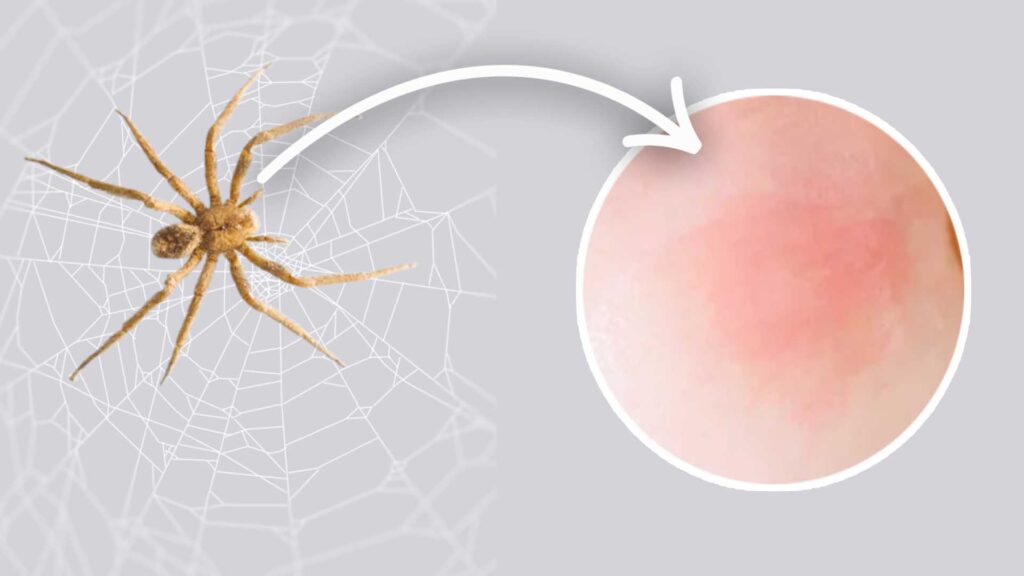
Brazilian Wandering Spiders are known for their potent venom and, occasionally, their bites on humans. While bites are relatively rare due to the spider’s non-aggressive nature, understanding the consequences of a bite is crucial for public safety.
Studying Brazilian Wandering Spider bites is of great interest for several reasons. It helps healthcare professionals provide appropriate medical treatment, raises awareness among communities in spider habitats, and contributes to our understanding of venomous arachnid envenomations.
The venom of Brazilian Wandering Spiders is a complex mixture of neurotoxins, cytotoxins, and enzymes. It contains various components, including PhTx3, which is a potent neurotoxin affecting the nervous system.
Brazilian Wandering Spider bites can have a range of effects on the human body, including intense pain, muscle cramps, fever, nausea, and in severe cases, paralysis. The severity of the symptoms depends on factors such as the amount of venom injected and the individual’s sensitivity to the venom. There are several types of spider bites .
Symptoms of a Brazilian Wandering Spider Bite
Local symptoms
- Intense pain
- Itching or burning sensation
- Formation of blisters or lesions
Systemic symptoms
- Muscle cramps and spasms
- Abdominal pain
- Nausea and vomiting
- Elevated heart rate
- Hypertension (high blood pressure)
- Respiratory distress
Severity and variations
The severity of Brazilian Wandering Spider bite symptoms can vary widely. In some cases, symptoms may be mild and resolve on their own, while in severe envenomations, life-threatening complications can occur. Individual reactions to the venom can also vary, making it challenging to predict the exact outcome of a bite.
First Aid and Immediate Response
Steps to take after a bite
Immediate response to a Brazilian Wandering Spider bite should include:
- – Washing the bite area with soap and water.
- – Applying a clean, cool compress to reduce pain and swelling.
- – Immobilizing the affected limb or area.
- – Keeping the bite victim calm to prevent an elevated heart rate.
Do’s and don’ts in case of a bite
- – Seek medical attention promptly.
- – Take note of the spider’s appearance (if possible) to aid identification.
- – Keep the bite victim still and calm to reduce the spread of venom.
- – Do not try to suck out venom or make incisions at the bite site.
- – Avoid applying tourniquets.
- – Don’t use ice directly on the skin as it can worsen tissue damage.
Seeking medical attention
Medical attention is essential after a Brazilian Wandering Spider bite, even if symptoms appear mild initially. Antivenom is available and can be administered to counteract the effects of the venom. Medical professionals can also manage symptoms and monitor for potential complications.
Complications and Long-Term Effects
Potential complications
Complications from Brazilian Wandering Spider bites can include:
- – Severe muscle spasms
- – Respiratory distress
- – Cardiovascular issues
- – Kidney failure (rare)
- – Allergic reactions to antivenom
Long-term consequences
Long-term consequences of a bite can vary depending on the severity and medical treatment received. Some individuals may experience lingering pain, muscle weakness, or psychological trauma following a severe envenomation.
Recovery and rehabilitation
Recovery from a Brazilian Wandering Spider bite typically involves medical treatment, rehabilitation for muscle and nerve damage, and psychological support for individuals affected by the experience. Rehabilitation may include physical therapy to regain muscle strength and function. Prompt medical attention and appropriate care are crucial for minimizing long-term effects and complications.
Facts of Brazilian Wanding Spider
Here are 10 creepy crawly facts about the Brazilian Wandering Spider:
- Big and Hairy: These spiders are giants! Their bodies can grow up to 2 inches (5 centimeters) long, with a leg span of up to 7 inches (18 cm). They are covered in hairs, making them appear even bigger.
- Wanderlust: They are aptly named – Brazilian wandering spiders don’t spin webs. Instead, they wander the forest floor at night in search of prey.
- Venomous Bite: Their venom is considered one of the most potent among spiders. A bite can cause severe pain, swelling, sweating, nausea, and even priapism in males. Thankfully, bites are rare as they are typically shy and defensive.
- Not So Fond of Bananas: While sometimes called ‘banana spiders,’ they are not typically found in bananas. They might, however, take shelter in them during transport, which is how they might end up in a faraway land.
- Rainforest Resident: These spiders are native to the rainforests of South America, particularly in Brazil.
- Fearsome Feasters: They’re active hunters and will eat almost anything they can overpower, including insects, lizards, frogs, and even small rodents.
- Mom’s the Word: Female Brazilian wandering spiders are dedicated mothers. They lay hundreds of eggs in a silken sac and fiercely guard them until they hatch.
- Multiple Molts: Like all spiders, Brazilian wandering spiders grow through molting. They shed their exoskeleton multiple times as they grow into adults.
- Mating Dance: Male Brazilian wandering spiders perform a elaborate mating dance to attract a female.
- Medicinal Potential: Despite their scary reputation, the venom of the Brazilian wandering spider is being studied for its potential use in treating erectile dysfunction.
What happens if a Brazilian Wandering Spider bites a man?
A Brazilian Wandering Spider bite on a man can cause a range of symptoms, some severe:
- Pain: The bite is known for causing intense, localized pain at the site.
- Autonomic effects: Sweating, nausea, and increased heart rate are common.
- Priapism: In some cases, males may experience a prolonged and painful erection (priapism). This is due to a component in the venom.
- Muscle paralysis: Severe bites can lead to muscle paralysis, which can affect breathing in rare cases.
However, it’s important to remember:
- Bites are uncommon as these spiders are typically shy and defensive.
- Antivenom is available and effective in treating bites.
If bitten, seek medical attention immediately. Early treatment can help prevent complications and ensure a full recovery.
How poisonous is a Brazilian Wandering Spider?
Brazilian Wandering Spider packs a nasty venomous punch, considered one of the strongest among spiders. Bites are rare though, as they’re shy and prefer to escape trouble.
What is the world’s deadliest spider?
The term “deadliest” can be subjective and depends on how one defines it (e.g., based on venom potency or human fatalities). However, the Brazilian Wandering Spider (Phoneutria) is often considered one of the most venomous spiders in the world. Another spider often mentioned in discussions of venom toxicity is the Sydney Funnel-web Spider (Atrax robustus and Atrax formosus), found in Australia. These spiders are known for their potent venom and have caused fatalities in the past.
Leave a Reply Cancel reply
Your email address will not be published. Required fields are marked *
Save my name, email, and website in this browser for the next time I comment.
Related Article
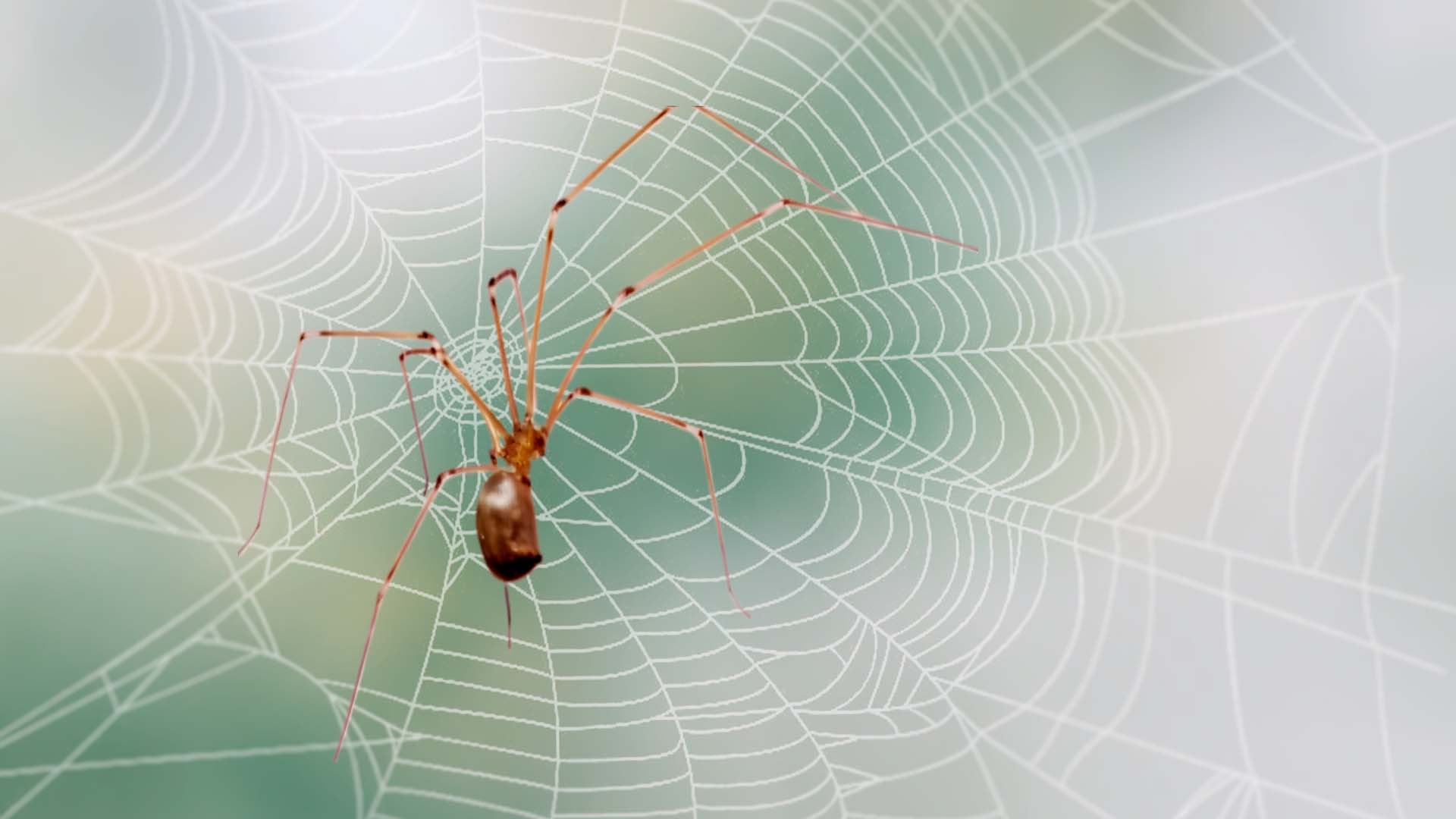
Can a Daddy Long Legs Bite Kill You (You Need to Know)
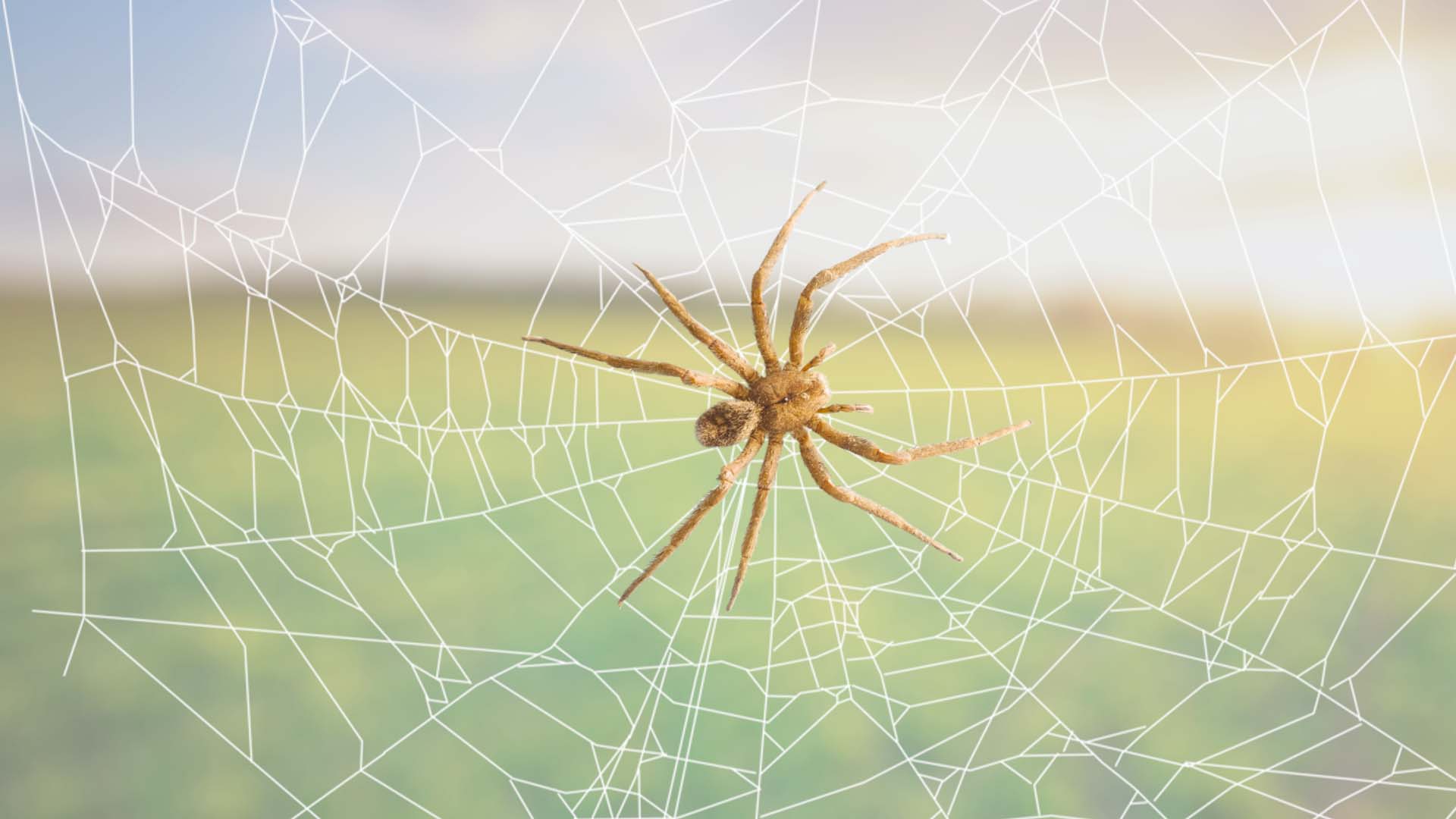
7 Facts About The Brazilian Wandering Spider
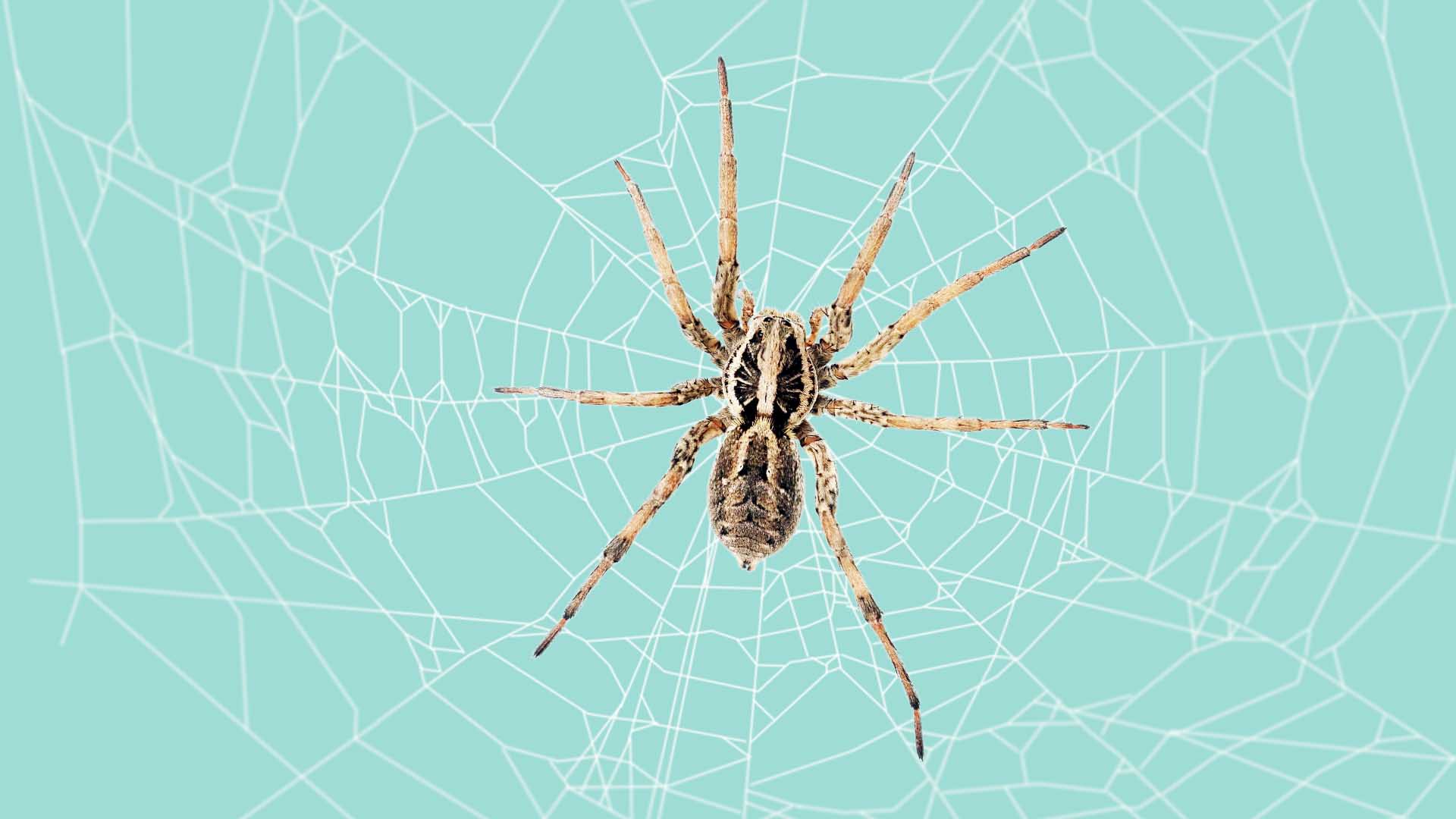
Are Wolf Spiders Poisonous for Humans, Cats or Dogs? (Explained)
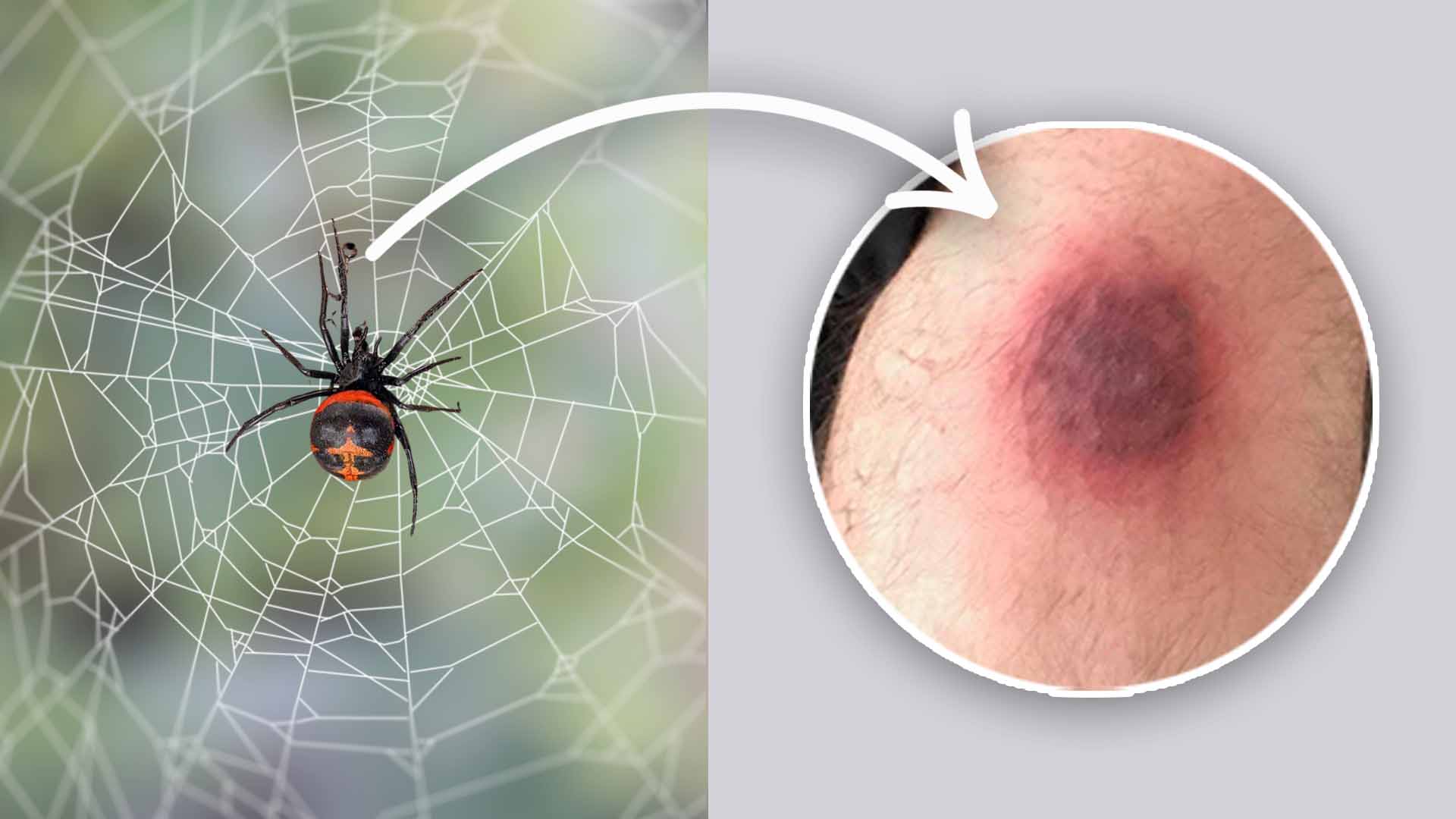
When To Worry About A Spider Bite? (Need to Know)
Brazilian Wandering Spider Facts: What Happens If It Bites You?
Brazilian wandering spiders belong to the genus Phoneutria and are represented by eight spider species that are native to Central America and South America. This spider group is also collectively known as armed spiders and banana spiders. In Brazil, they are locally known as "aranha armadeira" which means armed spider. With these, some people often wonder if a person can survive after being by a member or species of this group.
What is a Brazilian Wandering Spider?
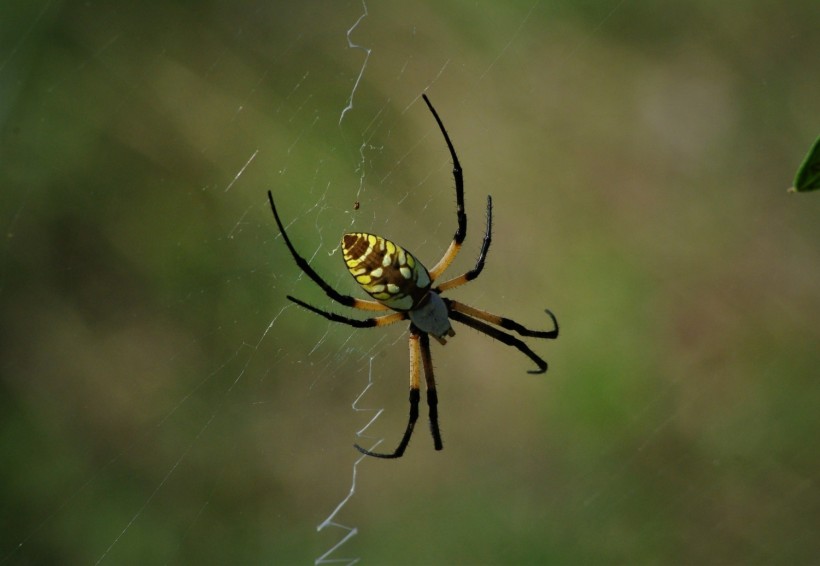
The genus Phoneutria , which the Brazilian wandering spider and related spider species belong to, was first described in 1833 when two species was included on it. The following century saw various scientists to move the Phoneutria species between genera Phoneutria and Ctenus . In 1936, Mello-Leitao restored Phoneutria and currently contains eight species, as reported by the University of Florida.
Banana spiders, a name given to the arachnid group due to their frequent presence on banana leaves, are large and robust arachnids in the family Ctenidae . They resemble the morphological appearance of wolf spiders. In addition, their body length can grow ranging from 17 and 48 millimeters and their leg span can reach 180 millimeters. Their distinct color ranges from light brown, brown, or grey. Furthermore, the natural habitats of armed spiders are forests.
Also Read: Deadly Erection-Giving Spider Crawls Out of Banana In Bristol
What Happens If It Bites You?
The natural prey of Brazilian wandering spiders includes small animals like crickets, mantids, and katydids, and larger ones like bats, frogs, and lizards. However, they can still bite humans and other animals not native in their habitats. In the past, scientists have identified that the bite of banana spiders living in Central and South American rain forests can lead to shortness of breath and excessive salivation.
According to wildlife experts, a Brazilian wandering spider bite can also lead to other serious symptoms, including increased blood pressure, above-normal pulse, and unusual respiratory rate, as well as extreme pain, hours-long penile erection, and death, in some cases. These spiders inject neurotoxin venom to its bitten victim and can be deadly to humans, particularly for children. However, it is not the world's deadliest spider.
Venomous Spider
In a study published in the journal Frontiers in February 2023, researchers stated that the Brazilian wandering spider is amongst the world's most dangerous venomous spiders in the world. In Brazil, there have been an estimated 4,000 envenomation accidents of Phoneutria nigriventer spider species each year in Brazil. Additional symptoms were also observed, including blurred vision, priapism, and vomiting.
The armed spider only follows the world's most venomous spider, which according to the Guinness World Records , is the Sydney funnel-web spider ( Atrax robustus ).
Like the Brazilian wandering spider, the venom of A. robustus can be neutralized by anti-venoms but some cases still lead to deaths when these arachnids bite a human, who did not receive any medical attention. Experts also weigh that the mortality of venom depends on the amount that enters a human body.
Related Article: Arachnophobia Nightmare: Giant Spider Found Inside Banana Box at Grocery Store in Germany
Tags Brazilian wandering spider , banana spider , Spider , spider bite , animals , Wild Animals
© 2024 NatureWorldNews.com All rights reserved. Do not reproduce without permission.

Midwest Weather Forecast: 75 Million People At Risk of Severe Weather Threat This Week
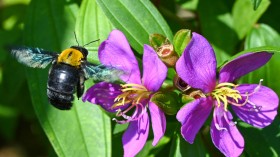
Orchid Bees Face Extinction Risk: Study Warns of Habitat Loss in Amazonian Ecosystem

NWS Weather Forecast in Eastern US: Powerful Storm System to Bring Strong Winds, Heavy Rain
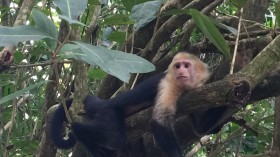
Wild Monkeys Bite Hong Kong Man, Giving Him the Rare 'Monkey B Virus' Herpesvirus Simiae
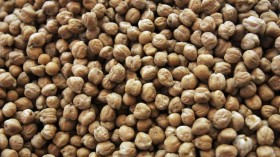
Researchers Identified a Genetic Factor That Contributes to a Longer Production Season in Pea Crops
An official website of the United States government
The .gov means it’s official. Federal government websites often end in .gov or .mil. Before sharing sensitive information, make sure you’re on a federal government site.
The site is secure. The https:// ensures that you are connecting to the official website and that any information you provide is encrypted and transmitted securely.
- Publications
- Account settings
Preview improvements coming to the PMC website in October 2024. Learn More or Try it out now .
- Advanced Search
- Journal List
- Emerg (Tehran)
- v.2(2); Spring 2014

Poisonous Spiders: Bites, Symptoms, and Treatment; an Educational Review
Farzad rahmani.
1 Department of Emergency medicine, Tabriz University of Medical Sciences, Tabriz, Iran
Seyed Mahdi Banan Khojasteh
2 Department of Animal Biology, Faculty of Natural Sciences, University of Tabriz, Tabriz, Iran
Hanieh Ebrahimi Bakhtavar
3 Department of Emergency Medicine, Ardabil University of Medical Sciences, Ardabil, Iran
Farnaz Rahmani
4 Department of Psychiatric Nursing, School of Nursing and Midwifery, Tabriz University of Medical Sciences, Tabriz, Iran
Kavous Shahsavari Nia
5 Road Traffic Injury Research Center, Tabriz University of Medical Sciences, Tabriz, Iran
Gholamreza Faridaalaee
6 Department of Emergency Medicine, Urmia University of Medical Sciences, Urmia, Iran
More than 40,000 species of spiders have been identified in the world. Spider bites is a common problem among people, however few of them are harmful but delay in treatment can cause death. Since the spider bites are risk full to human, they should be taken seriously, especially in endemic areas. Our objective in this review was to study about poisonous spiders and find out treatments of them. Therefore, we collected related articles from PubMed database and Google Scholar. Three important syndromes caused by spider bites are loxoscelism, latrodectism and funnel web spider syndrome. Many treatments are used but much more studies should have done to decrease the mortality. In this review, we describes different venomous spiders according to their appearance, symptoms after their bites and available treatments.
Introduction:
Spiders belong to a branch of invertebrate animals called arthropods. Arthropods have the largest number of species. Along with ticks, mites and scorpions, spiders fall into the subphylum chelicerata and class of arachnids ( 1 , 2 ). The arachnid class has very diverse members in a way that more than 80,000 species belonging to that class have been identified to date. Spiders are a large group of arachnids belonging to the araneae order ( 1 ). More than 40,000 species of spider have been identified to date but the real number is estimated at 4 times more than that number ( 3 ). Except for two small groups in the arachnid family, all spiders have poison glands and release their secretions into their venom sacs near their chelicerae. However, the majority of spiders do not bite humans and except for a few cases, they are not harmful to the human being or other mammals ( 2 ).Spider bites are common but the majority of species create little clinical presentations ( 3 ). There is only one aggressive spider named funnel-web in Australia, which attacks the human being without provocation. The majority of venomous spiders are found in Latin America. These large spiders are quite aggressive and their venom is pharmacologically highly toxic. Their bite results in severe pain, neurotoxic effects, diaphoresis, severe allergic reaction and priapism ( 1 ). Other spiders normally exhibit aggressive behavior after being trapped, injured or provoked. The severity of reactions to spider venom depends on factors such as its amount, site of biting and its duration and age and health condition. Mortality due to spider bite is rare ( 2 ). Spider venom includes different peptides and substances affecting sodium, calcium and potassium channels in neurons and also glutamate and acetylcholine receptors ( 4 ).Spider bite victims develop symptoms such as pain and swelling in the site of biting, necrosis, pyrexia, pulmonary edema, respiratory distress, hypertension, kidney dysfunction and death. Treatment protocol in the case of critically ill patients includes supportive measures and antivenom injection. Respiratory support and monitoring the hemodynamic status of these patients are of fundamental importance ( 5 ). Highly venomous spiders, funnel-web in Australia and armadeiras (armed spiders) in South America require antivenom and intensive therapeutic interventions ( 6 ). Three important syndromes are caused by spider bites: latrodectism, loxoscelism, and funnel-web spider syndrome ( 7 ). Here, we discuss about poisonous spiders and find out treatments of them.
Introduction of venomous spiders
This section describes different venomous spiders according to their appearance, symptoms after their bites and available treatments. Therefore, we collected related articles from PubMed and Google scholar ( Figure 1 ).

Flowchart of study
a) The brown recluse spider
The brown recluse spider is recognized by the violin-shaped marking on its back ( Figure 2 ). This spider takes rest during the day and is not aggressive but it will attack in the case of provocation. Patients are usually bitten by wearing clothes and shoes with spiders in them ( 2 ).

Brown Recluse Spider. Photograph by Richard S.Vetter.Reproduced with permission from:australianmuseum.net.au
Loxoscelism syndrome is the symptoms caused by the bite of the brown recluse spider. This spider's bite is usually painless but it later becomes an inflammatory, hemorrhagic and painful lesion ( 8 ). Necrosis spreads a few days following the bite and loxoscelism syndrome results in dermatitis necrosis in the site of biting, around which becomes red, white and blue, respectively ( 9 ). The venom of this spider contains hyaluronidase and sphingomyelinase D enzymes and results in necrosis. Moreover, neutrophil activity and platelet aggregation and thrombosis exacerbate necrosis ( 8 ). Local manifestations of the bite of this spider include edema, inflammation, hemorrhage, damage to the vessel wall, thrombosis, and necrosis ( 10 ) but systematic symptoms including acute renal failure, rhabdomyolysis and intravascular hemolysis have also been reported ( 11 ). In some cases, severe coagulopathy can result in stroke ( 7 ).Considering extensive differential diagnosis for skin necrosis, the standard criteria for the diagnosis of loxoscelism syndrome is capturing the spider during biting or capturing it in the place where biting occurred and its confirmation by a reliable arachnologist( 12 ).
Dapsone, antihistamines, colchicine, corticosteroids and hyperbaric oxygen have been used for treatment. Treatment with dapsone can alleviate bite marks and symptoms ( 8 , 13 ). Antivenom reduces the size of the necrotic area. The faster the antivenom is administered, the less the manifestations. It has been proven useful during the first 4 hours after the bite but according to an investigation, it was useful even after 12 hours ( 14 ).
The bite-induced necrosis spreads in a few days and completes in a few weeks. Treatments include initial debridement and in later stages, after improvement of the inflammation, graft is used in case of severity ( 9 ).
b) Hobo spider
Hobo spider is a brown-colored spider with gray marks along its body ( Figure 3 ). The reason for its name is its aggressive behavior following slight provocation. Symptoms induced by its bite are similar to those of the brown recluse spider but necrosis is rare and permanent scar is probable on the site of biting ( 12 ). The cause of necrosis is the hemolytic property of the venom or transmission of pathogenic bacteria inside the site of biting ( 15 ). The systemic symptoms of biting are reportedly cephalalgia and in some, rare cases anaphylaxis and death. The treatment is similar to that of the brown recluse spider. Moreover, resection should not be conducted before the completion of the necrosis process ( 8 ).

Eratigena-Agrestis (Hobo) Spider. Reproduced with permission from:www.spiders.us
c) Black widow spider
Black widow spiders have a black hairless body. Males are smaller than females. Its major characteristic is a red marking on its abdomen similar to an hourglass ( Figure 4 ). It is not aggressive under normal circumstances but attacks if disturbed, especially while protecting its egg sacs. Moreover, it is the most important venomous spider in North America and Australia ( 2 , 3 ). Its venom is alpha-latrotoxin (neurotoxic venom) which results in the exocytosis of synaptic vesicles from parasympathetic terminals due to the stimulation of calcium-dependent mechanisms, releasing catecholamines and acetylcholine ( 8 ).

Black Widow Spider (Photograph by Eric R. Eaton. Reproduced with permission from bugeric.blogspot.com
The symptoms induced by the bite of this spider are called latrodectism. The pain from its bite is similar to that of a pinprick. A lesion similar to the target lesion can be observed in the site of biting ( 16 ).Latrodectism starts in a few minutes with the development of pain through the whole body and symptoms such as emesis, respiratory failure, delirium, partial paralysis of limbs, abdominal muscle cramps, hypertension, pyrexia, fasciculation and muscle spasm are developed within a few hours ( 17 ). Symptoms may be mistaken with acute abdomen. Mortality following biting is less than 1 % and the risk of death following biting is high in two age spectrums. Bites usually occur during warm months ( 7 ). The chelicerae of this spider rarely leave a mark. Following the bite, erythema, diaphoresis and piloerection are observed around the site of bite in 25 % of the cases ( 3 ). Diagnosis is based on the patient's history. While it can be difficult in children, hypertension, distress, diaphoresis and irritability can suggest diagnosis in these cases ( 18 ).
The treatment of these patients consists of using muscle relaxants, narcotics, analgesics, intravenous calcium and antivenom. Narcotics and benzodiazepines relieve muscle spasms. Antivenom treatment is recommended for children, pregnant women the elderly and also patients with severe local symptoms, severe pains necessitating repeated administration of narcotics and systematic symptoms ( 3 ). In the case of IV administration, the antivenom should be diluted and injected slowly ( 17 ). However, some centers have recommended IM administration in order to reduce its complications. In the case of IM administration, the effect is delayed and symptoms take longer to improve ( 3 ) (within 1-5 days). Some may suffer from chronic pains even after proper antivenom treatment ( 18 ).
d) Armadeiras (armed spiders)
Armed spiders have long arms. Since they often hide in banana boxes, they are known as banana bunch spiders by locals ( Figure 5 ).The symptom of its bite is severe pain which is observed in 96 % of patients ( 18 ). The bite of this spider can cause respiratory failure and death at both ends of the age spectrum ( 8 ). Its venom is neurotoxic thus stimulates the autonomic nervous system (tachycardia, hypertension, diaphoresis and salivation), priapism, dizziness and visual disturbances ( 19 ). This venom is recommended to be used for controlling permanent pathological pains due to its different compounds and its effect on pain neurons ( 20 ).

Phoneutria, commonly known as Brazilian wandering spider or armed spider. Image source:wikipedia.org
Patients receive supportive treatment including pain and symptom control. There is antivenom for the treatment of these patients but it is used in few cases ( 21 ). With regard to the probability of respiratory failure in these patients, it is contradictory to use narcotics for pain control. Therefore, local nerve block anesthesia is recommended ( 8 ).
e) Funnel-web spider
Funnel-web spider, the most dangerous spider in the world, is aggressive in the absence of provocation ( Figure 6 ) ( 3 ). The structure of this spider’s web is funnel-shaped, hence the name ( 8 ).The venom of this spider is neurotoxin and contains a large amount of peptides ( 22 , 23 ). Delta atracotoxin, one of the peptides in the venom, delay the activation of voltage-dependent sodium channels resulting in repeated stimulation and release of massive neurotransmitters in nerve endings ( 24 ). Robustoxin is another toxin in the venom of this spider which is a fatal peptide and can be used for immunization ( 25 ).

Funnel Web Spider (Reproduced with permission from australianmuseum.net.au
Local symptoms include pain, diaphoresis, hives and piloerection. Systemic symptoms include stimulation of the parasympathetic system (nausea, emesis, salivation, sialorrhea and tearing), cardiovascular system (hypertension, mostly tachycardia and in some rare cases bradycardia and hypotension), nervous system (fasciculation and perioral paresthesia), non-cardiac pulmonary edema (more prevalent in children), agitation, and cephalalgia( 3 ).
Treatment includes supportive measures, elastic bandage for blocking lymph flow, limb immobilization and rapid transportation to the hospital. Antivenom is the definite cure and should be administered up to 15 minutes after opening the bandage. In the case of uncertainty about the bite and exhibition of the first systemic symptoms, 2 vials of antivenom are administered and in the case of severe symptoms 4 vials are administered. Other therapeutic measures include hemodynamic support, ventilatory support and the administration of tetanus vaccine. These measures reduce the risk of neurological complications and mortality and improve the performance of patients after being discharged ( 7 ).
f) Tarantula
Tarantula is recognized by its hairy 3-inch brown or black colored body ( Figure 7 ). This type of spider is kept as pet ( 8 ). Its venom is not dangerous for the human being and merely creates lesions without any specific systemic reaction except for pyrexia. Tarantula’s defense mechanism is the hair on its body which stands out and moves when alarmed ( 2 ). If these hairs enter the eye, they can result in the inflammation of all of the layers of the eye. Eye wash and topical corticosteroids are recommended in the case of uveitis ( 8 ).

Tarantula Spider (Mexican Red Legged Tarantula) Photograph byRicBolzan. Reproduced with permission fromaustralianmuseum.net.au
Recommendations for future
The human being has always been frightened of spiders but few of them are venomous and thus real threat to human health. However, since venomous spiders are sometimes fatal, bites should be taken care of. Moreover, it is recommended to be adequately familiar with necessary treatments. With regard to the identification of venomous spiders in our country including widow spider, which exists in the majority of provinces, healthcare personnel must be familiar with the symptoms of the bites of venomous spiders and it is essential to prepare antivenoms in the country for the treatment of spider bites. Finally, further domestic investigations are necessary on the distribution of venomous spiders and suspected cases of spider bite should be reported to related centers to reduce the damages caused by biting.
Acknowledgments:
We acknowledge Managers of www.spiders.us ; www.australianmuseum.net.au ; www.bugeric.blogspot.com ; and www.wikipedia.org sites for let us to use their own images.
Conflict of interest:
Funding support:, authors’ contributions:.
All authors passed four criteria for authorship contribution based on recommendations of the International Committee of Medical Journal Editors.
Animal Corner
Discover the many amazing animals that live on our planet.
Brazilian Wandering Spider
The Brazilian Wandering Spider (Phoneutria fera) is an aggressive and highly venomous spider . It was first discovered in Brazil hence its name. However, this genus is known to exist elsewhere in South and Central America .
The Brazilian Wandering spider is a member of the Ctenidae family of wandering spiders.
The Brazilian Wandering spider appeared in the Guinness Book of World Records 2007 for being the most venomous animal .
In this particular genus, there are five known similar species whose members are also highly venomous. They include some of the relatively few species of spiders that present a threat to human beings.
Brazilian Wandering Spider Characteristics
The Brazilian wandering spider can grow to have a leg span of up to 4 – 5 inches. They are large hairy spindly-looking spiders who have eight eyes, two of which are large. Brazilian wandering spiders are fast-moving spiders, their legs are strong and spiny and they have distinctive red jaws which they display when angered.
The Brazilian wandering spider is not a Tarantula . Brazilian wandering spiders are not even in the same family group. Tarantulas are harmless to humans and are mostly ambush killers who wait for prey to come to them. Brazilian wandering spiders are active hunters. Brazilian wandering spiders and Tarantulas do have one thing in common, however, they do not eat bananas.
Brazilian Wandering Spider Habitat and Spider Webs
The Brazilian Wandering spider is so-called because it wanders the jungle floor, rather than residing in a lair or maintaining a web. This is another reason it is considered so dangerous. In densely populated areas, the Brazilian Wandering spider will usually search for cover and dark places to hide during daytime, leading it to hide within houses, clothes, cars, boots, boxes and log piles. This usually causes accidents when people disturb them.
The Brazilian Wandering spider is also called the ‘banana spider’ as it is occasionally found within shipments of bananas. As a result, any large spider appearing in a bunch of bananas should be treated with due care.
Brazilian Wandering Spider Diet
Adult Brazilian Wandering spiders eat crickets, other large insects, small lizards and mice. Spiderlings of this species eat flightless fruit flies and pinhead crickets.
Brazilian Wandering Spider Reproduction
All spiders produce silk, a thin, strong protein strand extruded by the spider from spinnerets most commonly found on the end of the abdomen. Many species use it to trap insects in webs, although there are many species that hunt freely such as the Brazilian Wandering spider. Silk can be used to aid in climbing, form smooth walls for burrows, build egg sacs, wrap prey and temporarily hold sperm, among other applications.
Brazilian Wandering spiders reproduce by means of eggs, which are packed into silk bundles called egg sacs. The male spider must (in most cases) make a timely departure after mating to escape before the females normal predatory instincts return.
Mature male spiders have swollen bulbs on the end of their palps for this purpose and this is a useful way to identify whether the spider is male or female. Once the sperm is inside the female spider, she stores it in a chamber and only uses it during the egg-laying process, when the eggs come into contact with the male sperm for the first time and are fertilized. The Brazilian Wandering spiders life cycle is 1 – 2 years.
Brazilian Wandering Spider Venom
Bites from the Brazilian Wandering spider may result in only a couple of painful pinpricks to full-blown envenomed. In either case, people bitten by this spider or any Ctenid should seek immediate emergency treatment as the venom is possibly life threatening.
The Phoneutria fera and Phoneutria nigriventer (two species of wandering spider) are the two most commonly implicated as the most vicious and deadly of the Phoneutria spiders.
The Phoneutria not only has a potent neurotoxin, but is reported to have one of the most excruciatingly painful envenoms of all spiders due to its high concentration of serotonin. They have the most active venom of any living spiders.
One of their members, the Brazilian Huntsman, is thought to be the most venomous spider in the world. Brazilian wandering spiders are certainly dangerous and bite more people than any other spiders.
Check out more animals that begin with the letter B
More Fascinating Animals to Learn About
About joanne spencer.
I've always been passionate about animals which led me to a career in training and behaviour. As an animal professional I'm committed to improving relationships between people and animals to bring them more happiness.
Press ESC to close
The brazilian wandering spider: threats and treatments.
Imagine being bitten by a spider that not only causes excruciating pain, but also induces a painful and prolonged erection. This peculiar arachnid is no other than the Brazilian Wandering Spider, a creature that strikes fear into the hearts of many. This article explores the threats posed by this venomous spider and examines the treatments available for its bite. Prepare to discover the terrifying world of the Brazilian Wandering Spider and the measures taken to combat its deadly effects.
Table of Contents
Overview of the Brazilian Wandering Spider
Introduction to the Brazilian Wandering Spider
The Brazilian Wandering Spider, scientifically known as Phoneutria, is a species of venomous spider found primarily in South and Central America, with Brazil being its native habitat. These spiders are known for their distinct hunting techniques, potent venom, and the ability to wander, hence their name. With its aggressive nature and potentially lethal bite, the Brazilian Wandering Spider poses a significant threat to humans and animals alike.
Preferred Habitat and Distribution
Brazilian Wandering Spiders are adaptable creatures that can thrive in various habitats, ranging from tropical rainforests to urban areas. They prefer dark and secluded areas like tree stumps, piles of leaves, and crevices, typically found in the wilderness. However, due to deforestation and human encroachment, these spiders have also adapted to urban environments, often found hiding in woodpiles, sheds, and even inside homes.
Physical Characteristics
The Brazilian Wandering Spider is a large arachnid, with a leg span that can reach up to 6 inches. They have a brownish appearance with darker markings, aiding in their camouflage amidst bark and leaves. These spiders possess strong legs, enabling them to move quickly and gracefully. The most distinguishing feature of the Brazilian Wandering Spider is their characteristic defensive posture, where they raise their front legs to display their fangs.
Behavior and Hunting Techniques
Unlike most spiders that build webs for hunting, Brazilian Wandering Spiders are active hunters. They spend their nights on the move, searching for prey and avoiding potential predators. These spiders have excellent eyesight and rely on their acute senses to detect movements and vibrations. When hunting, they employ a unique technique known as “lurking,” where they stay hidden, waiting for their prey to approach before quickly pouncing on it.
Diet of Brazilian Wandering Spiders
Brazilian Wandering Spiders have a varied diet, which includes insects, small rodents, and even lizards. Their venomous bite immobilizes their prey, making it easier for the spider to handle and consume. While they primarily feed on live prey, these versatile spiders can also scavenge for food when necessary, increasing their chances of survival in harsh environments.
Venomous Threats Posed by Brazilian Wandering Spiders
Potency of brazilian wandering spider venom.
The venom of the Brazilian Wandering Spider is considered one of the most potent among spider species. It contains a neurotoxin called PhTx3, which affects the nervous system, causing severe pain, muscle spasms, and potentially life-threatening reactions. Due to its toxicity, the venom of this spider is not only harmful to humans but can also be lethal to animals, including pets.
Signs and Symptoms of Spider Bites
When bitten by a Brazilian Wandering Spider, the symptoms can vary depending on the individual’s sensitivity and the amount of venom injected. Common signs of spider bites include intense pain, redness, swelling, and local tissue damage. In severe cases, individuals may experience systemic effects like muscle cramps, increased heart rate, sweating, and even difficulty breathing. It is crucial to seek medical attention immediately if bitten by this spider.

Health Risks and Potential Complications
Being bitten by a Brazilian Wandering Spider can lead to various health risks and potential complications. The neurotoxic effects of the venom can cause paralysis, respiratory failure, and in extreme cases, death. Additionally, some individuals may develop allergic reactions to the venom, further exacerbating the severity of the bite. Prompt medical treatment is essential to minimize the risks and complications associated with these spider bites.
Comparison to other Venomous Spiders
Compared to other venomous spiders, such as the Black Widow or Brown Recluse, the Brazilian Wandering Spider’s bite is known to be more lethal due to its potent venom. While the Black Widow and Brown Recluse spiders are found in different regions, their venom can cause severe local tissue damage and systemic symptoms as well. Each spider species presents unique risks, and understanding their differences is crucial in providing appropriate medical treatment.
Fatalities and Incidents Reported
Fatalities related to Brazilian Wandering Spider bites are rare, thanks to the availability of antivenom and timely medical interventions. However, incidents of spider bites resulting in immediate hospitalization and severe complications have been documented. Particularly vulnerable to these bites are children, the elderly, and those with underlying health conditions. Prompt reporting and proper management of spider bites are crucial to prevent tragic outcomes.
Medical Treatments for Brazilian Wandering Spider Bites
Emergency response and first aid measures.
In the event of a Brazilian Wandering Spider bite, immediate action is necessary. First and foremost, it is essential to stay calm and seek medical help without delay. While waiting for medical professionals to arrive, follow basic first aid measures, including cleaning the wound with mild soap and water, applying a cold compress to reduce swelling, and keeping the affected limb immobilized to minimize venom spread.
Antivenom Administration for Spider Bites
Antivenom is the primary treatment for Brazilian Wandering Spider bites. It contains antibodies that neutralize the venom’s effects, reducing pain and preventing further complications. Medical professionals will carefully administer the antivenom, closely monitoring the patient’s vital signs and ensuring appropriate dosage. Antivenom therapy is vital in counteracting the potent neurotoxin and providing the best chance for a successful recovery.
Management of Pain and Swelling
To alleviate pain and reduce swelling associated with spider bites, various medications can be prescribed. Nonsteroidal anti-inflammatory drugs (NSAIDs) are commonly used to decrease inflammation and relieve discomfort. In some cases, opioids may be necessary to manage severe pain. Applying ice packs to the bite site and elevating the affected limb can also help reduce swelling.
Treatment Approaches for Systemic Effects
When systemic effects occur due to a Brazilian Wandering Spider bite, additional treatment approaches are required. Muscle relaxants and anticonvulsant medications may be administered to control muscle spasms and reduce the risk of convulsions. Supportive care, such as intravenous fluids and oxygen therapy, may also be provided to maintain hydration and ensure respiratory stability.

Long-Term Effects and Follow-Up Care
Even after the initial treatment of a Brazilian Wandering Spider bite, long-term effects may persist. Some individuals may experience residual pain, muscle weakness, or psychological trauma. Follow-up care is vital to monitor and manage any lingering symptoms. Physical therapy and counseling may be recommended to aid in rehabilitation and promote psychological well-being.
Prevention and Control Measures
Understanding spider behavior and habitats.
Understanding the behavior and habitats of Brazilian Wandering Spiders is crucial for effective prevention and control. Being aware of their preference for dark, secluded areas allows individuals to take proactive measures to minimize encounters. Regularly inspecting and cleaning potential hiding spots and sealing any gaps or cracks in homes and buildings can significantly reduce the chances of a spider infestation.
Spider Bite Prevention Tips
To prevent spider bites, adopting certain preventive measures is advisable. Avoid reaching into dark spaces without proper visibility, especially when gardening or working with woodpiles. Shake out clothing and shoes before wearing them, as spiders may seek refuge in these items. Using gloves when handling items in potential spider habitats can also provide a line of defense against accidental bites.
Safety Measures for Homes and Buildings
Creating a spider-free environment within homes and buildings can be achieved through implementing safety measures. Regularly clean and declutter living spaces, as spiders are attracted to dark and undisturbed areas. Installing screens on windows and doorways can prevent spiders from entering, and using weatherstripping to seal gaps will minimize entry points. Additionally, keeping outdoor lights off or changing the color to be less attractive to insects can also deter spiders.
Protective Clothing and Gear
When venturing into areas known for spider activity, wearing protective clothing and gear is essential to minimize the risk of bites. Long-sleeved shirts, long pants, and closed-toe shoes can provide a physical barrier between the spider and the skin. Additionally, using gloves, hats, and face shields can further protect vulnerable areas, reducing the chances of accidental bites.
Insecticides and Pest Control Methods
In cases where spider infestations become significant and pose a threat, the use of insecticides and professional pest control methods may be necessary. It is important to follow local regulations and recommendations when applying insecticides, as some may be harmful to humans and pets. Seeking the assistance of licensed pest control experts ensures effective treatment while prioritizing safety.
Research and Studies on Brazilian Wandering Spiders
Scientific studies and species classification.
Scientific studies play a crucial role in expanding our knowledge of Brazilian Wandering Spiders. Researchers conduct studies to better understand their taxonomy, behavior, and venom composition. Species classification helps identify specific variations within the Phoneutria genus, allowing for more targeted research and providing a foundation for conservation efforts.

Venom Extraction and Composition
Extracting and analyzing the venom of Brazilian Wandering Spiders is essential for developing effective antivenom and understanding the biochemical properties of the venom. Researchers aim to identify the specific toxins present, their mechanisms of action, and potential therapeutic applications. Studying venom composition can uncover valuable insights into the spider’s hunting strategies and aid in the development of novel pharmaceuticals.
Antivenom Development and Efficacy
Research on antivenom development focuses on improving the efficacy and safety of existing treatments. Scientists work to refine antivenom formulations, ensuring they neutralize the spider’s venom effectively. Testing the antivenom’s efficacy against various species of Brazilian Wandering Spiders is crucial to provide broad coverage and maximize the chances of successful treatment.
Environmental Impact and Conservation
Understanding the environmental impact of Brazilian Wandering Spiders is essential for effective conservation strategies. Research delves into the spider’s role in the ecosystem, its interactions with other species, and the potential consequences of population decline. By assessing their conservation status and identifying threats, scientists and policymakers can develop measures to protect this species and preserve its natural habitats.
Future Research Directions
As scientific advancements continue, future research on Brazilian Wandering Spiders will focus on areas such as genetic studies, venom evolution, and behavior analysis. Deepening our understanding of their genetics can provide insights into their adaptability and evolutionary history, aiding in conservation efforts. Additionally, studying behavioral patterns can enhance our ability to predict their movements and prevent human encounters.
Emerging Concerns and Cases of Brazilian Wandering Spider
Global spread and entry into new regions.
The global spread of the Brazilian Wandering Spider is a growing concern. Due to international trade and transportation, these spiders have been inadvertently introduced to regions outside their native habitat. Their ability to adapt to new environments increases the risk of establishing invasive populations, impacting local ecosystems and potentially posing a threat to human health.
Importance of Surveillance and Reporting
Surveillance and reporting systems are vital in monitoring and preventing the spread of Brazilian Wandering Spiders. Prompt and accurate reporting of potential sightings ensures swift action can be taken to mitigate the risks associated with these spiders. Encouraging public involvement and providing education on spider identification can help improve surveillance efforts and enable effective measures to be implemented.
Documented Cases Outside Brazil
While the Brazilian Wandering Spider is primarily found in Brazil, documented cases of encounters and bites have been reported in other countries. This highlights the potential for these spiders to establish populations beyond their native range and emphasizes the need for international cooperation in addressing this emerging concern. Sharing knowledge and experiences across borders is crucial in managing and preventing spider-related incidents.

Impact on Tourism and International Trade
The presence of Brazilian Wandering Spiders in areas heavily reliant on tourism and international trade can have significant economic implications. Fear of spider encounters and bites may deter tourists and affect the tourism industry. Moreover, the risk of transporting spiders through international trade, particularly in goods such as fruits or plants, poses a biosecurity concern that requires strict monitoring and prevention measures.
Legal and Regulatory Measures
To address the emerging concerns associated with the Brazilian Wandering Spider, legal and regulatory measures are necessary. Countries need to establish and enforce regulations on the import and export of potentially infested goods, ensuring adequate inspection protocols are in place. Collaboration between governments, organizations, and industries is crucial in establishing effective policies to minimize the risks posed by these spiders.
Interactions and Reactions from Local Communities
Fear and anxiety-related reactions.
The presence of Brazilian Wandering Spiders often elicits fear and anxiety among local communities. The aggressive behavior and potential dangers associated with these spiders contribute to a negative perception. Understanding the psychological impact of these fears is essential to develop educational programs and support services that address community concerns and promote emotional well-being.
Education and Awareness Programs
Educational initiatives and awareness programs play a vital role in mitigating the fears surrounding Brazilian Wandering Spiders. Providing accurate information about the spiders, their behavior, and the appropriate actions to take in case of encounters or bites can help alleviate anxiety and empower individuals to respond effectively. School programs, community workshops, and online resources are valuable tools to disseminate information and promote awareness.
Myths, Folklore, and Cultural Beliefs
Brazilian Wandering Spiders often find themselves entwined in myths, folklore, and cultural beliefs. Some local communities associate these spiders with superstitions and consider them to be omens or symbols of danger. Understanding these cultural beliefs and engaging in respectful dialogue is crucial to dispel myths, foster a better understanding of the spiders, and promote a harmonious coexistence.
Spider as a Symbol in Art and Media
The intriguing nature of the Brazilian Wandering Spider makes it a subject of fascination in art, literature, and media. Artists incorporate the spider’s image into various forms of expression, creating artwork that captures its mystique and intricate details. It serves as a reminder of the spider’s significance in both natural and cultural contexts, sparking conversations and encouraging further exploration.
Local Efforts for Spider Conservation
Communities residing in areas populated by Brazilian Wandering Spiders often play a crucial role in their conservation. Local conservation efforts may involve initiatives such as promoting sustainable land use, raising awareness about the importance of biodiversity, and establishing protected areas or nature reserves. Engaging local communities in spider conservation fosters a sense of ownership and shared responsibility for safeguarding these fascinating creatures.
Comparison with Other Dangerous Spider Species

Brown Recluse Spider
The Brazilian Wandering Spider and the Brown Recluse Spider both pose threats to humans, but they have distinct characteristics. While the Brazilian Wandering Spider is known for its wandering nature and highly potent neurotoxic venom, the Brown Recluse Spider is recognized for its reclusive behavior and venom that can cause necrotic skin lesions. Understanding the differences between these species is crucial in providing appropriate medical treatment for bites.
Black Widow Spider
Both the Brazilian Wandering Spider and the Black Widow Spider are venomous, but their venom composition and effects differ. While the Brazilian Wandering Spider’s venom primarily affects the nervous system, the Black Widow Spider’s venom contains neurotoxins that target the neuromuscular junctions. Recognizing the symptoms and seeking appropriate medical treatment are essential in managing bites from these spiders.
Sydney Funnel-Web Spider
The Brazilian Wandering Spider and the Sydney Funnel-Web Spider are both known for their potent venom and aggressive behavior. However, the Sydney Funnel-Web Spider is native to Australia, while the Brazilian Wandering Spider is found in South and Central America. Despite their geographical differences, both spiders require urgent medical attention in the case of bites due to the potential severity of their venom.
Redback Spider
The Redback Spider, native to Australia, is similar to the Brazilian Wandering Spider in terms of venom potency and potentially lethal bites. They both belong to the family of spiders known for their neurotoxic venom. While the Brazilian Wandering Spider is more active and known for its wandering behavior, the Redback Spider tends to build webs and wait for their prey. Understanding their distinct characteristics is essential in providing targeted medical treatment.
Taipan Spider
The Taipan Spider, also known as the Coastal Taipan or Australian Tarantula, is another venomous spider species found in Australia. Its unique venom composition makes it distinct from the Brazilian Wandering Spider. The Taipan Spider is known for its highly potent neurotoxic venom, but its behavior and physical characteristics differ significantly from those of the Brazilian Wandering Spider. Recognizing the differences helps in accurately identifying and managing spider encounters.
Misidentification and Popular Misconceptions
Confusion with harmless spider species.
Spider misidentification is a common occurrence, leading to unnecessary panic and fear. The Brazilian Wandering Spider may be mistaken for non-venomous species, such as harmless Huntsman or Wolf spiders, due to a superficial resemblance. Educating the public about distinguishing features and encouraging accurate identification can prevent unnecessary concern and promote a better understanding of these spiders.
Spider Hoax and Urban Legends
Urban legends and hoaxes involving spiders, including the Brazilian Wandering Spider, have contributed to public misconceptions. Sensationalized stories on social media or unreliable sources often exaggerate the dangers associated with these spiders, perpetuating unnecessary fears. Encouraging critical thinking and relying on reputable sources for information can help dispel myths and prevent the spread of false information.
Exaggerated Claims and Sensationalism
Exaggerated claims and sensationalism in media portrayals of the Brazilian Wandering Spider can contribute to public hysteria. Highlighting the spiders’ aggressive behavior and potential lethality without providing accurate context can create unnecessary panic. Promoting responsible journalism that presents factual information and provides balanced perspectives is essential to ensure accurate public understanding of these spiders.
Social Media Impact on Public Perception
Social media platforms have a significant influence on public perception and understanding of the Brazilian Wandering Spider. Misinformation can spread rapidly, contributing to fear and misunderstanding. It is crucial to encourage responsible sharing of information, verify facts before sharing, and promote scientific literacy to combat the spread of inaccuracies and ensure accurate portrayals of these spiders.
Expert Clarifications and Reliable Sources
Experts and reliable sources play a vital role in clarifying misconceptions surrounding the Brazilian Wandering Spider. Educating the public about the spiders’ behavior, venom potency, and risks through reputable sources is crucial. Scientists, researchers, and medical professionals can provide accurate and evidence-based information, addressing concerns and dispelling myths surrounding these spiders.
Conservation Efforts and Habitat Protection
Need for conservation initiatives.
Conservation initiatives are crucial to protect the Brazilian Wandering Spider and its natural habitats. The preservation of biodiversity, including these unique arachnids, is essential for maintaining healthy ecosystems. By recognizing the ecological importance of spiders and their role in pest control, conservation efforts can be integrated into broader strategies aimed at preserving the planet’s biodiversity.
Preserving Natural Habitats
Preserving the natural habitats of Brazilian Wandering Spiders is paramount to their long-term survival. Protecting forests, wetlands, and other ecosystems ensures the spiders have suitable areas to thrive. Implementing sustainable land use practices and conservation policies that consider the needs of these spiders and their habitats can help safeguard their populations for future generations.
Captivity Breeding Programs
In certain cases, captivity breeding programs may be established to support the conservation of Brazilian Wandering Spiders. These programs provide controlled environments for breeding and rearing these spiders, ensuring genetic diversity and maintaining healthy populations. Collaboration between reputable institutions and regulatory bodies is crucial in developing and implementing successful breeding programs.
Community Involvement in Spider Protection
Engaging local communities in spider protection efforts fosters a sense of responsibility and promotes the overarching goal of conservation. Encouraging the participation of local residents in monitoring spider populations, reporting sightings, and supporting sustainable land use practices can enhance the effectiveness of conservation initiatives. Community involvement ensures that the conservation efforts reflect the needs and values of the people living in close proximity to these spiders.
Role of Zoos, Sanctuaries, and Research Institutions
Zoos, sanctuaries, and research institutions play a vital role in the conservation of Brazilian Wandering Spiders. These establishments provide controlled environments for the spiders, conduct research, and educate the public. By supporting scientific studies, raising awareness, and participating in breeding programs, these institutions contribute to the long-term conservation of these fascinating arachnids.
In conclusion, the Brazilian Wandering Spider, with its potent venom and unique hunting techniques, poses both a venomous threat and an ecological fascination. Understanding its behavior, venom, and appropriate medical treatments is crucial in mitigating risks associated with potential encounters. Conservation efforts, public education, and responsible reporting play essential roles in preserving the natural habitats of these spiders and dispelling myths surrounding them. By promoting a better understanding of the Brazilian Wandering Spider, we can foster a sense of coexistence and ensure the well-being of both humans and these remarkable arachnids.
Share this:
Mike Benkert
I'm a bug enthusiast and creator of BugsWorldWide, a blog sharing his 15 years of my experience caring for bugs. I've traveled the world bird watching and I'm committed to helping others with bug care. Contact me at [email protected] for assistance.
The Art of Life Organization
Understanding the behavior of juvenile silverfish, recent posts.
- Do Grasshoppers Have Backbones
- Pet Scorpion Species
- Moth Wing Patterns
- Insect Photography
- Beetle Larvae
- Grasshopper Species
- Cricket Anatomy
Discover more from BugsWorldWide
Subscribe now to keep reading and get access to the full archive.
Type your email…
Continue reading

Fact Animal
Facts About Animals
Brazilian Wandering Spider Facts
Brazilian wandering spider profile.
There are more than 50,000 species of spider, and the vast majority are less dangerous than a honeybee. Almost none are aggressive, and of those with medically significant venom, only a small percentage are capable of causing death. So, on the whole, arachnophobes are just being a bit silly.
But there’s one spider that vindicates all of these fears, and few animals are as globally renowned to be a serious threat to human lives as the Brazilian Wandering Spider .
Brazilian Wandering Spiders are actually 9 species of spider in the same genus ‘Phoneutria’, one of which is found in Central America, with the rest in South America.
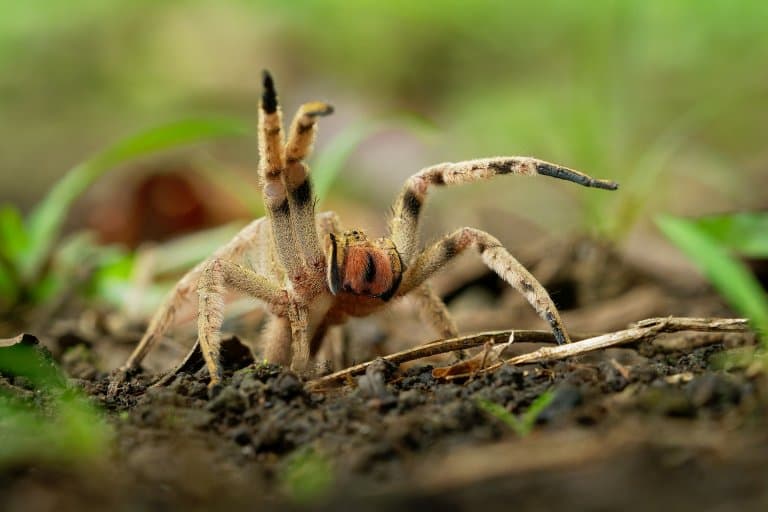
Brazilian Wandering Spider Facts Overview
These spiders are called wandering spiders because of instead of spinning a web to wait for food, or occupying a lair, they spend their night wandering in the leaf litter of the jungle floor for prey.
The sensitive hairs on its body help detect vibrations of passing prey, and it will feed on insects, lizards, frogs and any animals as large as itself.
During the day they will hide under logs, rocks, or inside termite mounds and banana plants. They will also sometimes wander into urban areas and homes, where they can come into contact with humans.
Brazilian wandering spiders are aggressive , dangerous and frightening. For once, this is an animal you should be wary of.
The females are larger, around 50% heavier than males, and produce more venom, and this might be a clue as to why their Greek name translates to “ Mudress” . These spiders will often stand and fight and have an intimidating threat display.
The potency of their venom is one of the reasons they’re so dangerous, and their ability to hide away in fruit and shoes explains why most bites are on extremities.
Interesting Brazilian Wandering Spider Facts
1. armed spiders.
In Brazilian, these are sometimes known as armed spiders, on account of their elongated front legs.
They can convey quite a bit of information with these legs, and as wandering spiders, use them to get about the forest, looking for food.
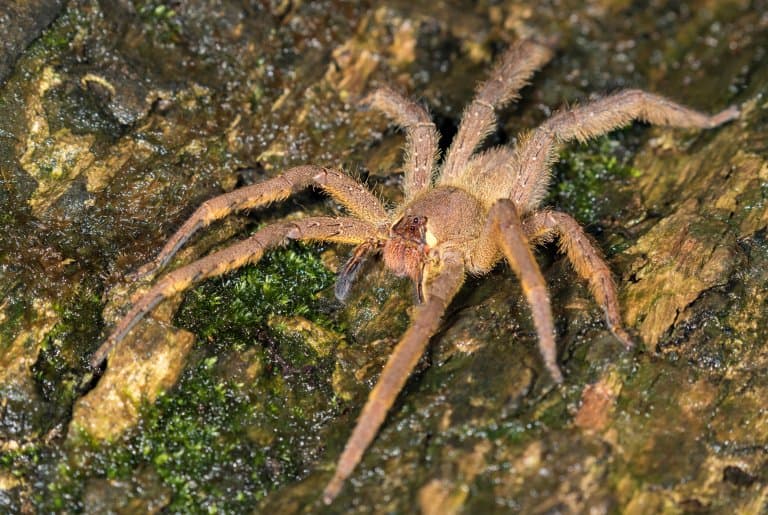
2. Banana Spiders
They’re also sometimes called ‘banana spiders’ on account of their status as a stowaway on popular fruit imported from the tropics.
This is becoming less common as stricter regulations ensure there’s less contamination of fruits, but there’s always a chance your next bunch of bananas will have a family of these spiders living inside it.
3. They have the largest venom glands of any spider
Females produce more venom than males, but both sexes have enormous venom glands. These glands are even more impressive when you consider the size of the spider is significantly less than the largest around.
The venom glands of the Brazilian Wandering Spider are over a centimetre long, and this is all housed inside the bright red chelicerae (mouth parts) which they are quick to display whenever they get upset. 1
4. They’re aggressive
These spiders can grow quite large and have long, brightly-coloured legs. Unlike most spiders, they’re known to stand their ground when threatened and are far quicker to bite than many other species.
They’ll still try to scurry away where possible, and they’re not out to get anybody.
But where most other species will flee, the wandering spiders’ aggression does make it more likely to be involved in incidents.
Most bites are on fingers and toes, a sign that they’re being stepped on or grabbed inadvertently. When the spider feels cornered, it’ll rear up on its back legs and waves its colourful arms around as a warning.
Then it’ll sway side to side, beckoning you to have a go. Anything foolhardy enough to call this bluff gets a wealth of envenomation effects. 2 3
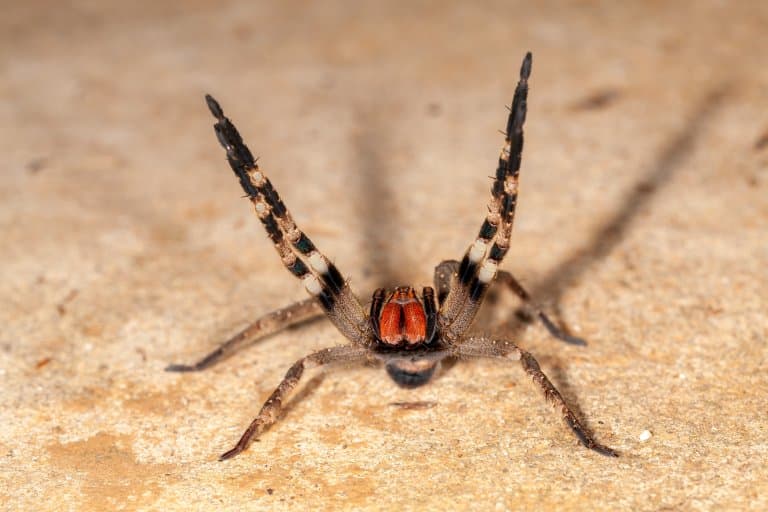
5. They give some men erections
There are ways to accomplish this with fewer side effects, but a bit from a Brazilian wandering spider does come with a certain Viagral quality.
This isn’t as fun as it might sound. Prolonged erections in this manner are likely to harm and destroy muscles and blood vessels in the penis and could cause irreparable damage.
Besides this, the assault on the central nervous system that comes with envenomation by this spider doesn’t sound worth it. 4
6. And some people die
This assault brings with it a whole host of unpleasant symptoms. Seizures, foaming at the mouth, inability to speak, collapse, and a host of other miserable experiences.
Paralysis is possible, as is cardiac shock. Blood vessels can burst in the brain, or anywhere else, and in many cases, this can be enough to kill a person.
This spider has one of the most potent venoms of all, and there are multiple legitimate records of death as a result of bites.
7. But they’re rarely fatal
While the Brazilian wandering spider is potentially one of the most dangerous spiders in the world, there is some evidence to suggest it gives a dry bite, defensively.
This means that despite exceptionally toxic venom, the amount actually injected is less than some of the other contenders, and this is what makes it typically less lethal than the Australian funnel webs.
These spiders are classified as Dangerous Wild Animals and would therefore require a special permit to keep. Bites from wandering spiders are common in South America, but antivenom is often readily available, and they rarely result in death.
In most cases, lethal bites are cases of a very young or very old victim, and few people of healthy age are killed. 5
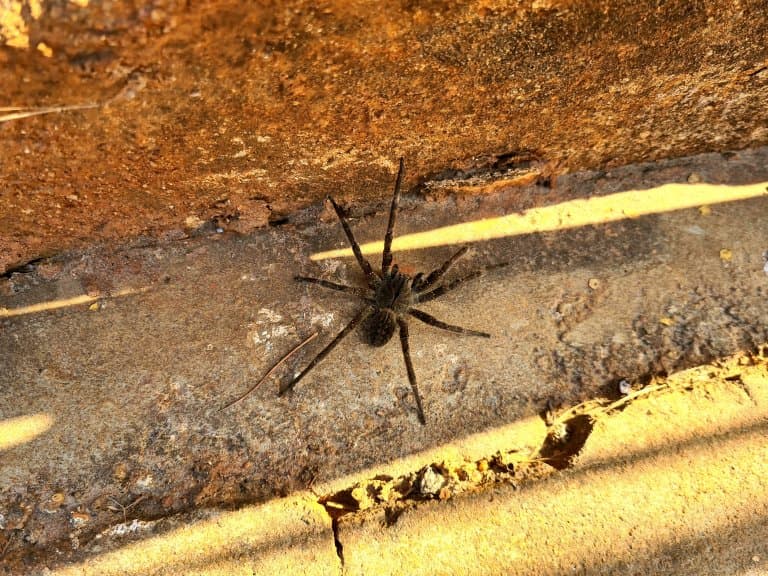
8. They do invade the UK sometimes
These unquestionably scary spiders show up in supermarkets in the UK on occasion, having hitched a ride on banana shipments.
On more than one occasion they’ve made their way into shoppers’ homes, but it doesn’t appear that there are any cases of them biting people as a result.
These spiders aren’t suited for temperate climates and don’t survive Winter, so there’s no risk of them multiplying.
Brazilian Wandering Spider Fact-File Summary
Scientific classification, fact sources & references.
- PeerJ. (2017), “ Dimensions of venom gland of largest venom glands in all spiders ”, Bio Numbers.
- Dave Clarke (2010), “ Venomous spider found in Waitrose shopping ‘beautiful but aggressive’” , The Guardian.
- “ Phoneutria Perty (Arachnida: Araneae: Ctenidae) ”, UF-IFAS University of Florida
- Kátia R.M. Leite (2012), “ Phoneutria nigriventer spider toxin Tx2-6 causes priapism and death: A histopathological investigation in mice ”, Science Direct.
- “ Brazilian wandering spiders: Bites & other facts ”, Live Science.
Medical Information

First Aid for Brazilian Wandering Spider Bite
What is a brazilian wandering spider bite.
Brazilian wandering spiders, also known as banana spiders, are one of the most venomous spiders in the world. They are found primarily in South and Central America and are known for their aggressive behavior and wandering tendencies.
Identification:
- Brazilian wandering spiders have a brown body with distinctive yellow markings on their legs
- They have long and slender legs that are covered in spines
- They have a small body, but their legs can span up to 6 inches (15 centimeters)
- They have two large fangs that are often visible when they open their mouth
What are the Causes of Brazilian Wandering Spider Bite?
Brazilian wandering spiders are venomous and are capable of causing serious envenomation when they bite.
- The venom of the spider contains a neurotoxin that attacks the nervous system, causing muscle spasms, breathing difficulties, and other severe symptoms
- The venom can also cause an excessive release of serotonin, leading to increased heart rate, sweating, and elevated blood pressure
What are the Signs and Symptoms of Brazilian Wandering Spider Bite?
The following signs and symptoms of Brazilian Wandering Spider Bite may be noted:
- Severe pain at the site of the bite that may radiate to other parts of the body
- Sweating and tingling sensations in the mouth and tongue
- Muscular twitching, spasms, and cramps
- Difficulty breathing or shortness of breath
- Nausea, vomiting, and abdominal pain
- Increased heart rate and high blood pressure
- Unconsciousness and convulsions
How is First Aid administered for Brazilian Wandering Spider Bite ?
Immediate actions:
- Clean the bite site with soap and water
- Put a wet, cold cloth, or an ice pack on the bite site
- Seek urgent medical attention, and bring the spider with you to help with identification, when possible
First aid administration:
- The First Aid for Brazilian Wandering Spider Bites includes cleaning the bite area and seeking medical attention
Who Should Administer First Aid for Brazilian Wandering Spider Bite?
- First aid for Brazilian Wandering Spider Bites should be administered by someone who is trained in providing first aid, such as a medical professional, a paramedic, or a trained first-aider
- If there is no one available with appropriate training, attempt to apply the pressure immobilization bandage and seek urgent medical attention
What is the Prognosis of Brazilian Wandering Spider Bite?
The prognosis for Brazilian Wandering Spider Bites depends on the severity of the symptoms and the timing of the treatment.
- If prompt medical attention is given, most patients can recover fully without any long-term effects
- However, delayed or inadequate treatment can lead to serious complications and even death
Long-term effects:
- There are generally no long-term effects of Brazilian Wandering Spider Bites if prompt medical attention is given
- However, in rare cases, patients may develop allergic reactions or experience chronic pain, muscle weakness, or other symptoms that persist long after the bite
How can Brazilian Wandering Spider Bite be Prevented?
A few helpful tips to prevent Brazilian Wandering Spider Bites include:
- Wear shoes and gloves when working in the garden or bush
- Check bedding and clothing before use, especially when stored in dark and cool areas
- Keep the house and garden free from clutter, including piles of rocks, leaves, and wood
- Install screens on doors and windows to prevent spiders from entering the house
- Use insecticides and spider repellents
What are certain Crucial Steps to be followed?
- If you live in areas where Brazilian wandering spiders are prevalent, it is essential to take necessary precautions to prevent being bitten.
- Learn how to identify Brazilian wandering spiders and their habitats to avoid them.
- If you suspect that you have been bitten by a Brazilian wandering spider, follow the immediate actions and first aid administration guidelines outlined above.
- Seek urgent medical attention, and bring the spider with you to help with identification.
- Do not attempt to catch or handle the spider, as this can increase the risk of being bitten.
In conclusion, Brazilian wandering spiders are a potentially deadly species of spider found in South and Central America. If you suspect that you have been bitten by a Brazilian wandering spider, it is crucial to seek urgent medical attention as soon as possible. Prevention is key to avoid being bitten, so take necessary precautions to keep yourself and your family safe from these dangerous spiders.
Hashtags: #BananaSpider #FirstAid #SouthAmericanWildlife #SpiderBites #SafetyTips
On the Article

Krish Tangella MD, MBA

Robert Ben Johnston, MD
Please log in to post a comment.
Related Articles
Test your knowledge, asked by users, related centers, related specialties, related physicians, related procedures, related resources, join dovehubs.
and connect with fellow professionals
Related Directories
At DoveMed, our utmost priority is your well-being. We are an online medical resource dedicated to providing you with accurate and up-to-date information on a wide range of medical topics. But we're more than just an information hub - we genuinely care about your health journey. That's why we offer a variety of products tailored for both healthcare consumers and professionals, because we believe in empowering everyone involved in the care process. Our mission is to create a user-friendly healthcare technology portal that helps you make better decisions about your overall health and well-being. We understand that navigating the complexities of healthcare can be overwhelming, so we strive to be a reliable and compassionate companion on your path to wellness. As an impartial and trusted online resource, we connect healthcare seekers, physicians, and hospitals in a marketplace that promotes a higher quality, easy-to-use healthcare experience. You can trust that our content is unbiased and impartial, as it is trusted by physicians, researchers, and university professors around the globe. Importantly, we are not influenced or owned by any pharmaceutical, medical, or media companies. At DoveMed, we are a group of passionate individuals who deeply care about improving health and wellness for people everywhere. Your well-being is at the heart of everything we do.
For Patients
For professionals, for partners.

- Planet Earth
- Strange News
Brazilian wandering spiders: Bites & other details
Acidente por aranha armadeira com sequela do fenômeno Raynaud – 17 Lopes-Martins RAB, Antunes E, Oliva MLV,Sampaio CAM, Burton J, Nucci G. Pharmacological characterization of rabbit corpus cavernosum relaxation mediated by the tissue kallikrein-kinin system. Br J Pharmacol. 1994 Sep;113(1): 81-6. Doi: 10. 1111/j. 1476-5381. 1994. tb16177. x (Link)
Video advice: Brazilian Wandering Spider facts: one of the banana spiders
Brazilian wandering spiders are known as banana spiders because there’s the idea that these spiders travel around the world in banana shipments. While not entirely impossible, it’s extremely rare for a Brazilian wandering spider to be seen outside of their native range due to travels on bananas – though it has happened! Brazilian wandering spiders have a toxic bite which has caused some human deaths, however this is generally an atypical occurrence. Still, to be fair, these spiders are considered to be some of the deadliest spiders in the world! Their bite can also cause some… awkward circumstances when male humans have been bitten. These spiders were discovered in Brazil but can be found throughout parts of Central and South America. There are eight classified species of Brazilian wandering spiders and not all of them have a bite toxic enough to harm a human.

What happens if a Brazilian wandering spider bites you?
Are brazilian spiders dangerous.
It has been reported that the spiders are Brazilian wandering spiders, a deadly breed that can kill people in a matter of hours , though these spiders are known to nest on the ground and not in trees. The types of spiders known to nest in bananas are understood to be harmless to humans.
How fast can a wandering spider kill you?
The signs of envenomation usually include increased heart rate, priapism, muscle tremors. Phoneutria fera and Phoneutria nigriventer are more dangerous than the rest of the species of this genus. Symptoms appear within 10-20 minutes, and death occurs in two to six hours after the bite .
How painful is a Brazilian wandering spider bite?
The bite of a Brazilian wandering spider is extremely painful . It can quickly result in heavy sweating and drooling. The skin around the bite will usually swell, turn red, and get hot. In severe cases, the bite can result in dead tissue or death.
Is Daddy Long Legs the most poisonous spider?
You've probably heard this playground legend: Daddy longlegs are the most venomous spiders in the world , but their fangs are too short to bite you. Is this really true? The short answer: no. ... Unlike spiders, these animals have a single body segment and only two eyes, and they don't have fangs or venom glands.
Video advice: Spider bite . Brazilian Wandering Spider bit me . AND I AM ALIVE. Worlds Deadliest Spider
Spider bite. Brazilian Wandering Spider bit me . AND I AM ALIVE. Worlds deadliest spider.

Related Articles:
- Funnel-Web Spiders: Families, Bites & Other Details
- Copperhead Snakes: Details, bites & babies
- Barrier Snakes: Colors, Bites, Farts & Details
- Camel Spiders: Details & Myths
- Black widow spiders: Details relating to this infamous number of arachnids
- Ogre-Faced Spiders: These Spiders Can Hear – While They Don’t Have Any Ears
Science Journalist
Science atlas, our goal is to spark the curiosity that exists in all of us. We invite readers to visit us daily, explore topics of interest, and gain new perspectives along the way.
You may also like

Birdwatch: Technicolor Poultry Sports Iridescent Down

Youthful killer whale saved after stranding on Scottish beach

The Earliest DNA from Giant Pandas Only Agreed To Be Discovered inside a Collapse China
Add comment, cancel reply.
Your email address will not be published. Required fields are marked *
Save my name, email, and website in this browser for the next time I comment.
Recent discoveries


A Physics Student On Planet Exidor Throws

What Is A Field Investigation In Science

How Is Nanotechnology Used For Diabetes

How To Succeed As An Engineering Student
- Animals 3041
- Astronomy 8
- Biology 2281
- Chemistry 482
- Culture 1333
- Health 8466
- History 2152
- Physics 913
- Planet Earth 3239
- Science 2158
- Strange News 1230
- Technology 3625
Random fact

Feathered Dinosaur Lost Its Tail in Sticky Trap 99 Million Years Back

A home for Tarantula, Spider, Scorpion and Arachnid Enthusiasts.
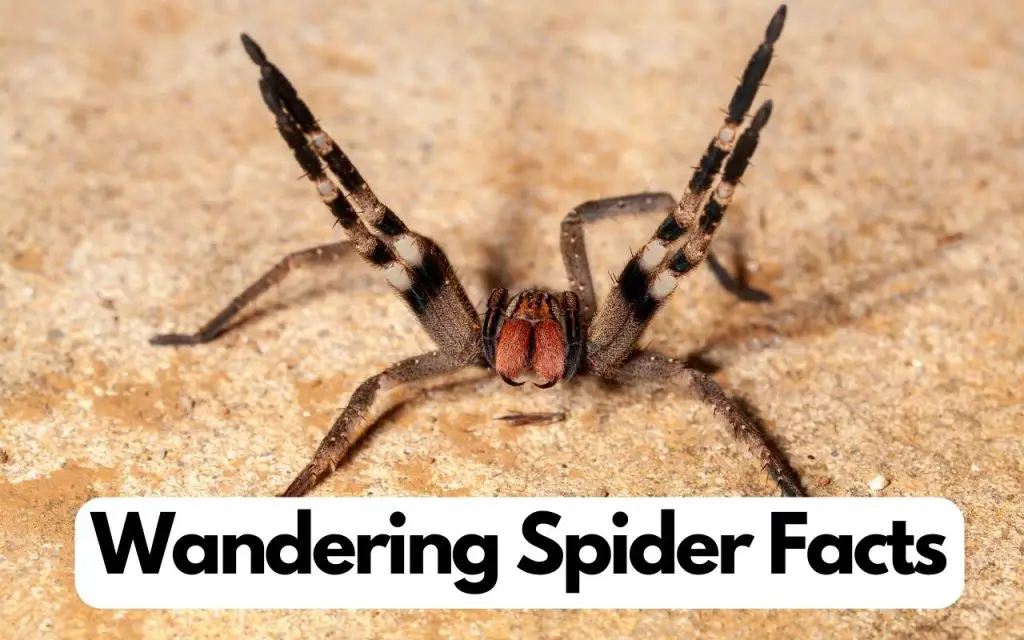
Brazilian Wandering Spider facts
Last updated on July 12th, 2023 at 01:48 pm
When you think of deadly spiders, there are a few names that spring to mind – but none more infamous than the Brazilian Wandering Spider. This species is reputed to have the most toxic venom of any spider, having a bite which causes horrendous side-effects like priapism and convulsions.
What you may not know, however, is that the Brazilian Wandering Spider name is actually used for a few species. The most common, and perhaps the most medically significant in the group are Phoneutria nigriventer and Phoneutria fera .
In this post, I’ll tell you more about these two species, from where they live, to what they eat. To keep things simple, I’ll just refer to them both as the “Brazilian Wandering Spider”, given how similar they are. Let’s dive in…
Quick Facts
To kick things off, here are some fascinating factoids about the Brazilian Wandering Spider:
- They belong to the genus ‘Phoneutria’, which translates to ‘murderess’ in Greek.
- They are known for their highly potent venom.
- Wandering Spiders are nocturnal creatures.
- They are also known as ‘banana spiders’ due to their tendency to hide in banana plants.
- They are not web-weavers but active hunters. This is called ‘cursorial’ hunting.
- It’s considered one of the most dangerous spiders in the world.
Other Common Names
The Brazilian Wandering Spider goes by several other names. The most common is the ‘banana spider’, thanks to their notorious habit of stowing away in banana shipments. In their native Portuguese, they’re known as ‘aranhas-armadeiras’ , translating to ‘armed spiders’ – a reference to their aggressive defense posture.
Brazilian Wandering Spider Venom
Possessing one of the most potent venoms among spiders, the Brazilian Wandering Spider’s bite is a cause for concern. Its venom is a complex cocktail of toxins, proteins, and peptides.
The main component that gets everyone’s attention is the neurotoxin, called PhTx3 , which can interfere with the functioning of our nervous system, leading to a variety of symptoms.
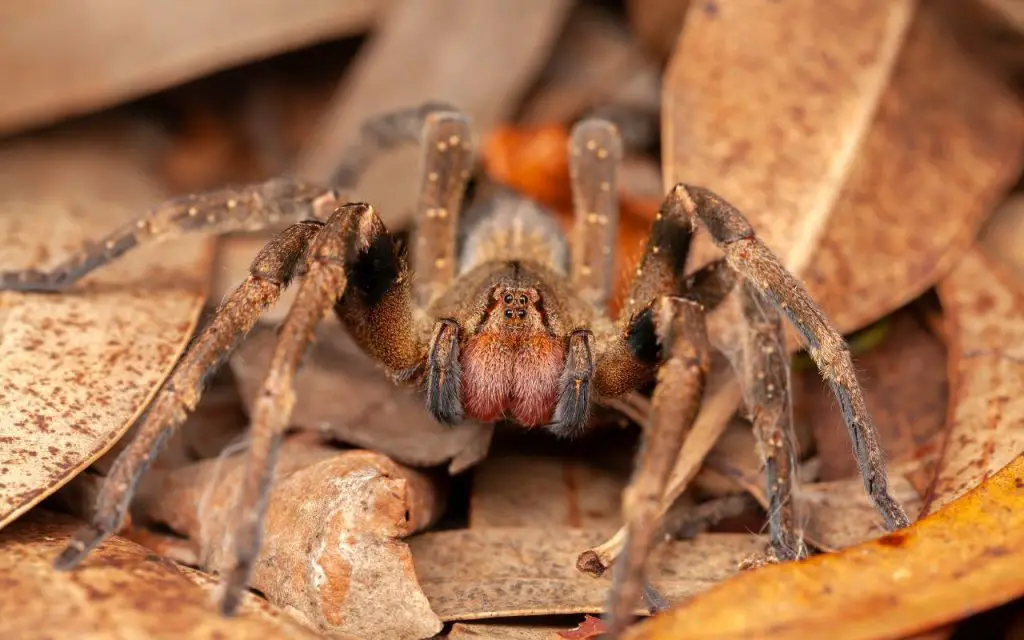
What’s the Benefit of Having Such Strong Venom?
With venom potent enough to kill a human, one might wonder why this spider needs such a powerful weapon. The answer lies in its lifestyle.
Brazilian Wandering Spiders are active hunters and their venom is primarily used to incapacitate prey quickly. The venom’s potency also serves as an effective deterrent against potential predators.
Brazilian Wandering Spider Deaths
Despite the notorious reputation, actual deaths from Brazilian Wandering Spider bites are rare. This is largely due to the rapid medical attention available in areas where these spiders are common. Plus, these spiders don’t always inject venom when they bite – a dry bite can occur.
This actually common in venomous animals, including spiders and reptiles. Occasionally they bite and decide to not inject any venom. The point of this is to conserve it, given that it is energetically costly to produce.
Brazilian Wandering Spider Size
Being quite large and impressive compared to most arachnids, adult Brazilian Wandering Spiders can reach a leg span of up to 7 inches (18 cm) . The body size excluding the legs can be up to 2 inches (5 cm). Their size contributes to their intimidating presence.
If you’d to learn more about why they get so big, check out my article on Brazilian Wandering Spider size for more info!
Brazilian Wandering Spider Location and Habitat
Brazilian Wandering Spiders are native to South America. Here’s a quick rundown of their range and preferred habitats:
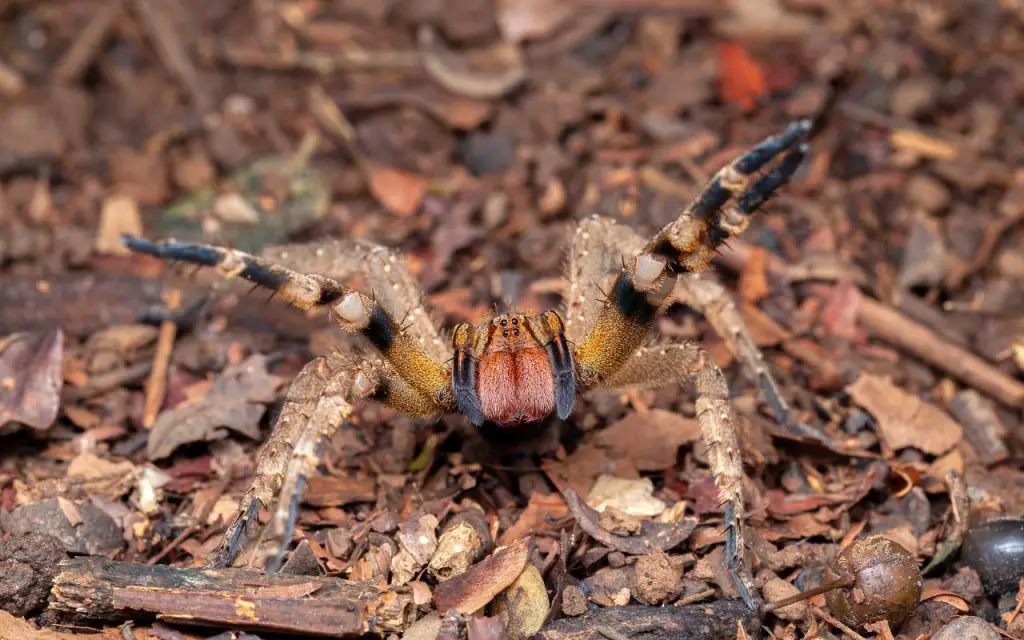
Brazilian Wandering Spider Speed
An adept hunter, the Brazilian Wandering Spider can move quickly when chasing prey or evading threats. While exact speed measurements can vary, some sources report that these spiders can achieve speeds up to 1 meter per second.
What Does the Brazilian Wandering Spider Eat?
The Brazilian Wandering Spider’s diet consists mainly of insects, other spiders, and occasionally small amphibians and reptiles. Their potent venom allows them to tackle prey larger than themselves, making them one of the apex micro-predators in their habitat.
Final Thoughts…
While the Brazilian Wandering Spider might seem terrifying to many, as an arachnid enthusiast, I find them to be incredibly fascinating. Their potent venom, hunting prowess, and adaptation to diverse habitats reveal the intricate beauty of the evolutionary process.
Just remember, these spiders, like all creatures, play a vital role in our ecosystem. Respect, not fear, should be our response to these remarkable arachnids.
The truth is that most bites are accidental, but they do occur. The fact that so few deaths occur each year is a testament to the effectiveness of the antivenom that has now become widely available.
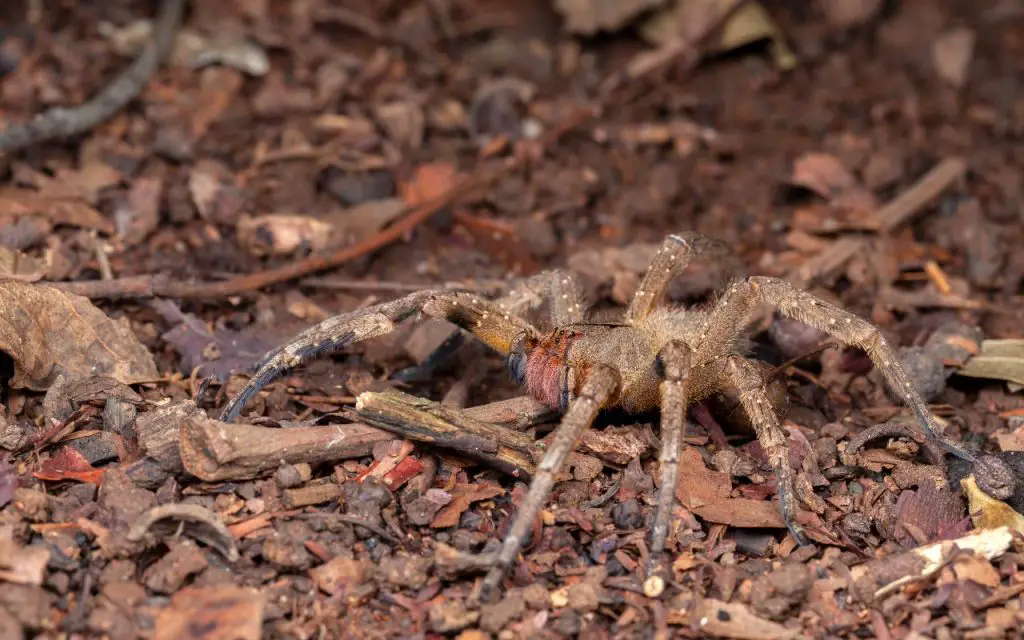
FAQ related to the Brazilian Wandering Spider
What happens if you are bitten by a brazilian wandering spider.
Immediately after a bite from a Brazilian Wandering Spider, you will experience localized pain. Then, within 5 to 15 minutes the area around the bite will swell. The swelling can spread to most of a limb, for example. Finally, neurological symptoms like coldness, sweating, and convulsions will set in.
Do wandering spiders jump?
Wandering Spiders are excellent at jumping. They can jump several feet when surprised, and may occasionally use this as a tactic to evade predators. Jumping at you isn’t part of how bites happen though. When faced with humans, Wandering Spiders usually stand their ground and use their threat display of raised legs to warn us away.
Is Brazilian wandering spider friendly?
Wandering Spiders are not friendly. As a general rule, they are relatively calm, but can also be defensive. They tend to see humans as a threat, and will not take to being handled easily. That said, they are not aggressive, and most bites happen when someone accidentally touches one or tries to kill it.
Are Brazilian wandering spiders in Australia?
Brazilian Wandering Spiders are not found in Australia. The only species in Australia that get as large as Wandering Spiders are the Huntsman Spiders. At a distance they may appear relatively similar, but Huntsman Spiders are completely harmless to humans.
Related Posts:
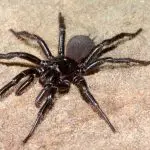
Leave a Comment Cancel Reply
Your email address will not be published. Required fields are marked *
Save my name, email, and website in this browser for the next time I comment.
Brazilian Wandering Spider
The Brazilian Wandering Spider (Phoneutria fera) is a teardrop-shaped arachnid with a brown coloration. Known for its potent venom, it thrives in both the lush rainforests and human dwellings of Brazil. Its notorious wandering behavior makes it a significant presence in its habitats.
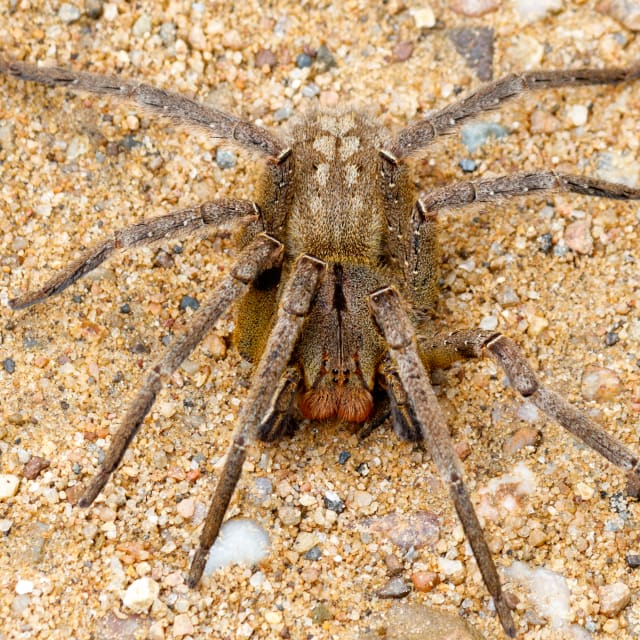
Fascinating Facts about Brazilian Wandering Spider
Here are 3 interesting facts about Brazilian Wandering Spider:
- The Brazilian Wandering Spider is considered the world's most venomous spider by the Guinness World Records.
- They are known as 'wandering' spiders because they roam the jungle floor at night instead of residing in a lair or web.
- Despite their notorious reputation, their bites rarely cause death in humans due to the small amount of venom they inject.
Taxonomy and Classification
Here is the scientific categorization of Brazilian Wandering Spider, providing a glimpse of their position in the biological hierarchy:
Lifecycle and Growth
Brazilian Wandering Spider's life is a journey of transformation - an adventure marked by the following captivating stages:
Egg → Spiderling → Adult
The Brazilian Wandering Spider, primarily found in the rainforest, exhibits a lifecycle that spans both wilderness and human habitats. From egg to adult, it navigates a complex path through dense foliage and human dwellings, adapting to these contrasting environments.
Brazilian Wandering Spider Behaviour and Adaptations
Brazilian Wandering Spiders are known for their nomadic behavior. Instead of building webs to catch prey, they actively hunt at night, using their highly developed senses, particularly vision, to locate and stalk their prey.
These arachnids have adapted to a wide range of habitats, from forests to urban areas. Their potent neurotoxic venom, one of the most powerful among spiders, allows them to incapacitate and consume a variety of prey.
Brazilian Wandering Spider Interaction with the Ecosystem
Now, let's look at how they help maintain the balance in the ecosystem:
- Brazilian Wandering Spiders play a crucial role in controlling the population of their prey, which includes insects and small mammals.
- They serve as a food source for larger animals, contributing to the food chain in their ecosystem.
- Their venom, although dangerous to humans, is studied for medicinal purposes including treatments for erectile dysfunction and pain relief.
Threats to Brazilian Wandering Spider
Despite their popularity and predator status, Brazilian Wandering Spider encounter several threats as well:
- Destruction of natural habitat due to deforestation
- Increased usage of pesticides affecting their food chain
- Climate change potentially disrupting their breeding patterns
Also Check:
If you're interested in learning about at some more interesting insects, here are two suggestions for you, below 👇
Do Brazilian Wandering Spider Bite?
Learn if Brazilian Wandering Spider bite, what you should do if you get bitten by them, and other interesting information.
Other Bug Profiles
Check other interesting bugs:
- Lone Star Tick
- Brown Dog Tick
What do Brazilian Wandering Spider Eat?
Learn what food Brazilian Wandering Spider eat, and also information about how they eat and drink.
Search Collections Databases
Myth: deadly australian/brazilian spiders, myth: but there are really deadly spiders in australia and brazil..
Fact: The previous myth page, where I said that no spider species anywhere can properly be called "deadly," generated more comments than any other on the site. Most were from Australians who were certain their country at least had truly deadly spiders, including the Sydney Funnelweb Spider, Atrax robustus, and the Redback Spider, Latrodectus hasselti . Some also mentioned White-tailed Spiders, genus Lampona . Some comments were from Brazilians who put forward their Phoneutria wandering spiders as the world's deadliest.
To start with, these people had misunderstood what I said. I never claimed that no human ever died from spider venom. What I said was, there is no species whose bite kills much more than 5% of its victims, nor any spider that kills within minutes, like in the movies. This applies just as strongly to Australia and Brazil as to the USA.
According to the Australian Museum, the number of human deaths from authentic spider bites of any kind in Australia since 1979 has been zero. A recent published medical study followed 750 genuine Australian spider bite cases with identified spiders over 27 months (1999-2001). Only 44 bites (6%, mostly redback spider bites) had significant effects. Only 6 redback bites and 1 Atrax bite were serious enough to need antivenom. In no case was there any sign of allergic response to spider venom, and I have only seen one such case in North America in 44 years.
Atrax robustus , the Sydney Funnelweb Spider, is often publicized as the "world's deadliest." Authentic medical information suggests otherwise. There have been no deaths (out of 30-40 bites per year) since antivenom was introduced in 1980. During the 53 year period 1927-1979 there were 13 or 14 known deaths, which would be a death rate of under one percent! Although one child died in 15 minutes, adult fatalities typically took 2-3 days. 90% of Atrax bites are judged not serious enough to need antivenom.
Most serious spider bites in Australia are from the Redback, Latrodectus hasselti , a close relative of American black widows with very similar venom and effects. The recent study mentioned above tallied 56 genuine redback bites. Only 37 (66%) had any serious effects, and only 6 (11%) were serious enough to need antivenom. There have been no redback-caused human deaths in several decades.
White-tailed spiders, Lampona cylindrata and relatives, have recently been blamed for Australian cases of severe necrotic lesions, but this connection was not based on enough evidence. The same authors who did the 750-bite study mentioned above, gathered a further 130 cases (aged 3-76 years) bitten by identified Lampona spiders. Local pain and itching were the only effects. No one developed any lesion or ulcer. White-tailed spiders are not guilty of doing any serious harm to humans; this page has more details.
Brazilian Wandering Spiders ( aranhas armadeiras ), Phoneutria nigriventer , P. keyserlingi and P. fera , are sometimes said to have the world's most toxic spider venom – probably based on a well publicized study where mice were killed by intravenous injection of as little as 0.006 mg of venom. Since I'm a man, not a mouse, that doesn't worry me much. Authoritative sources state that over 7,000 authentic cases of human bites from these spiders have been recorded, with only around 10 known deaths, and about 2% of cases serious enough to need antivenom. So despite the surprisingly large number of bites, this spider is not exactly public enemy number one either.
Most medical conditions blamed on spiders by physicians lack confirmation that any actual spider was involved in the case. Spider bites of all kinds are rare events (as opposed to other bites and medical conditions that get wrongly blamed on spiders). Although it is possible for a spider bite to cause death, that is a very unlikely outcome and does not happen in enough cases to justify calling any spider "deadly."
Spider Myths
"Everything that 'everybody knows' about spiders is wrong!" — Rod Crawford sets the record straight with Spider Myths .
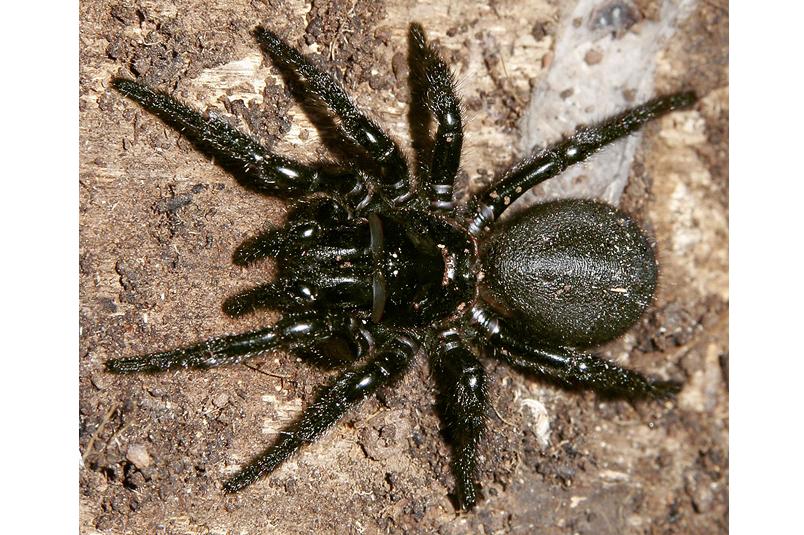
Female Sydney Funnelweb Spider, Atrax robustus . Human deaths from bite are rare. Photo: Fir0002 from Wikimedia Commons, under GNU Free Documentation License
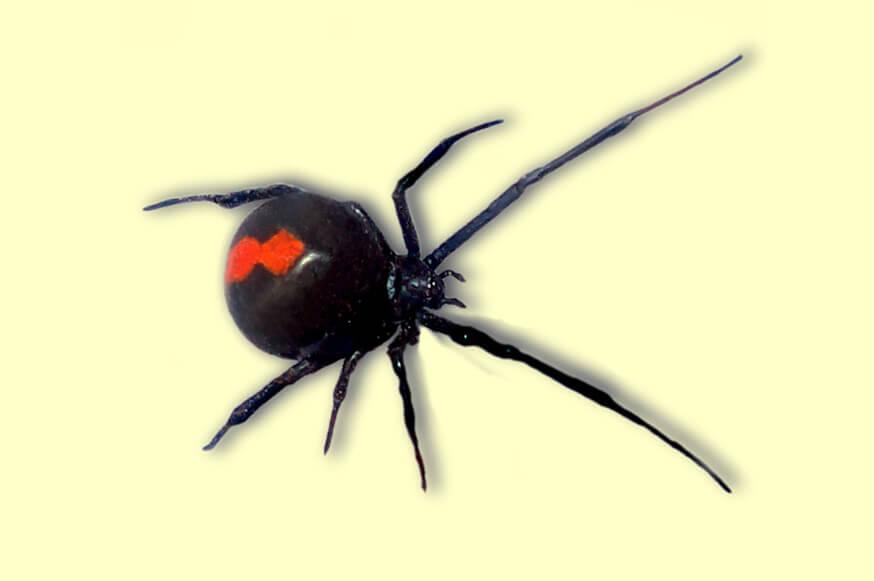
Female White-Tailed Spider, Lampona sp . Now proven 100% harmless! Photo: David McClenaghan, CSIRO from Wikimedia Commons
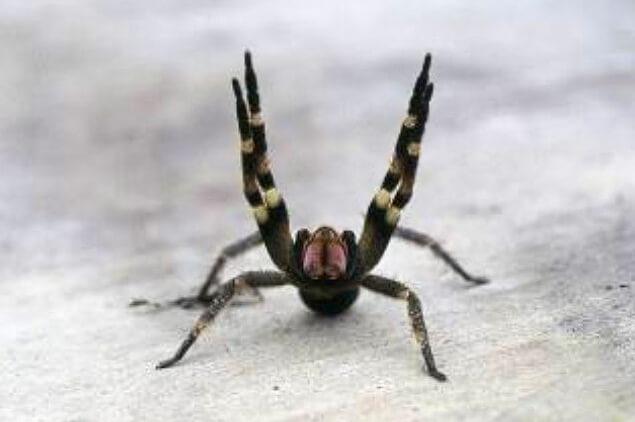
Female Brazilian Wandering Spider, Phoneutria nigriventer . Human deaths from bite are rare. Photo: Paraná State Govt., Brazil
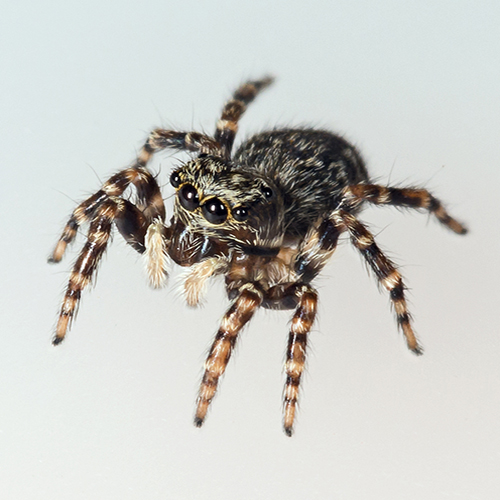
Spider Myth Resources
Explore even more! Additional spider resources and more myths (poor spiders can't catch a break!).

Become a member
Experience even more. A membership pays for itself in 3 visits!
Just want tickets?
Continue to general admission tickets page.
Buy tickets
Looking for a special event?
View calendar
This article is free to read if you register or sign in.
Simply register at no cost.
Questions or problems? Email [email protected] or call 0711 046 000 .
FACT CHECKER
Misleading: bite from brazilian spider causes four-hour erection, high or low blood pressure, fast or a slow heartbeat, nausea, abdominal cramping among signs..
• But Urologist Dr. Peter Mungai said penile erection involves neuron stimulation and production of hormones which has nothing to do with a spider bite.
• In addition to intense pain and possible medical complications, the bite of a Brazilian wandering spider can deliver a long, painful erection to human males because the venom boosts nitric oxide, a chemical that increases blood flow.
A viral photo claiming that a bite from a Brazilian spider causes an erection lasting up to four hours is misleading.
The photo, widely shared in WhatsApp groups, encouraged those with an erection disorder to try the spider to up their performance.
This came up following an online publication claiming that the species contains a possible breakthrough for erectile dysfunction.
“Most people who find a spider in their bedroom quickly try to get rid of it. But new research shows that one arachnid might actually be best kept by your bedside. A single bite from the Brazilian wandering spider has been shown to have side effects including a four-hour-long erection,” read part of the article.
But Urologist Dr. Peter Mungai said an erection occurs when a man becomes sexually aroused allowing hormones, muscles, nerves, and blood vessels to work together.
Mungai said penile erection involves neuron stimulation and production of hormones which has nothing to do with a spider bite.
“This is just a good joke because a spider cannot produce the hormones or neurons needed to stimulate a penile erection,” he said.
“If it is true that such information is doing rounds then it could be by some sadists who do not understand the mechanism of erection,” he added.
The neurons in these hypothalamic nuclei contain peptidergic neurotransmitters, including oxytocin and vasopressin, which may be involved in penile erection.
Several brain stem and medullary centres are also involved in sexual function.
For an erection to occur, nerve signals sent from the brain to the penis stimulate muscles to relax in turn, allowing blood to flow to the tissue in the penis.
Once the blood fills the penis and an erection is achieved, the blood vessels to the penis close off so that the erection is maintained.
Following sexual arousal, the blood vessels to the penis open up again, allowing the blood to leave.
However several studies here indicate that the Brazilian wandering spiders' venom is a complex cocktail of toxins, proteins and peptides which affects ion channels and chemical receptors in victims' neuromuscular systems.
The wandering spiders, also called armed spiders or banana spiders, belong to the genus Phoneutria, which means "murderess" in Greek. And it's no wonder why — it's one of the most venomous spiders on Earth.
After a human is bitten by one of these spiders, he or she may experience initial symptoms such as severe burning pain at the site of the bite, sweating and goosebumps.
Within 30 minutes, symptoms become systemic and include high or low blood pressure, fast or a slow heartbeat, nausea, abdominal cramping, hypothermia, vertigo, blurred vision, convulsions and excessive sweating associated with shock.
In addition to intense pain and possible medical complications, the bite of a Brazilian wandering spider can deliver a long, painful erection to human males because the venom boosts nitric oxide, a chemical that increases blood flow.
People who are bitten by a Brazilian wandering spider should seek medical attention immediately.
Several studies are looking at incorporating the venom into drugs for erectile dysfunction.
However, these bites are rare, and envenomations are usually mild.
The Star’s fact check concludes that while it is true a bite from this spider may cause an erection, it is a painful erection which is a disorder due to the venom.
The information is thus misleading.
Most Popular
It experts urged to build digital trust as services go ..., national cement recieves sh4.3bn to clear foreign debt, in courts: ex-ruiru mca to be sentenced in wife's murder, how to clear piling pending bills, biden urged to ban china-made cars from the us, latest videos, why farmers association want sugar importation suspended, the news brief: anc now wants ford-k and uda to fold in merger, sign up for the free star email newsletter and receive the latest kenya news daily..

Brazilian Wandering Spider: Care, Food, Habitat & Preventions
Mike Wallace
Have you ever heard of or do you know what a Brazilian wandering spider is ? It is a big venomous spider from places like Central and South America, and people sometimes call it the banana spider . Why? Well, we are about to find out!
Table of Contents
These wandering spiders are aggressive hunters who go out on the hunt at night. Their meals include both invertebrates (like insects) and vertebrates (creatures with a backbone, like small animals).
These spiders are super dangerous because their venom is like a powerful potion that can make people really sick or even worse. They usually hang out in tropical rainforests and even in cities, hiding in banana plants.
So, let’s get more information about the world of this sneaky spider to learn the details about its looks, eating habits, where it lives, the venom it carries, and find out if it is genuinely risky. Ready to explore? Keep reading!
Brazilian Wandering Spider Description:
Scientific name and family:.
In Brazil, they are sometimes known as “ armed spiders ” (armadeiras), and they share the name “ banana spiders ” with a few other spiders. They have different names, but they are all talking about the same interesting spider!
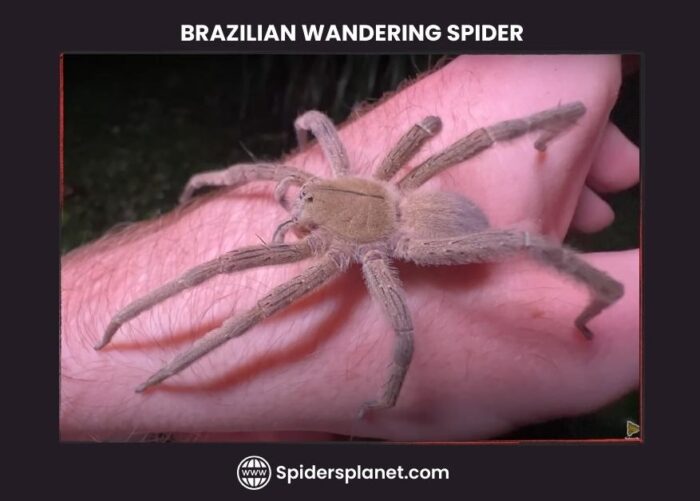
The Brazilian wandering spider, scientifically known as Phoneutria , Maximilian Perty kickstarted the Phoneutria genus in 1833. The name comes from the Greek word φονεύτρια , which means “murderess” and falls under the Animalia kingdom, Arthropoda phylum, and Arachnida class.
Within Arachnida, it is classified in the order Araneae, infraorder Araneomorphae, and Ctenidae family. The genus Phoneutria, described by Perty in 1833, includes the type species Phoneutria fera .
This classification helps us understand where these spiders fit into the larger picture of living organisms.
The following 9 species are accepted by The World Spider Catalog :
- Phoneutria bahiensis
- Phoneutria boliviensis
- Phoneutria eickstedtae
- Phoneutria fera
- Phoneutria keyserlingi
- Phoneutria nigriventer
- Phoneutria pertyi
- Phoneutria reidyi
- Phoneutria depilata
What do Brazilian Wandering Spider look like?
Size range:.
The spiders in the Phoneutria group can get pretty big in size. Their legs can stretch out to be 13 to 18 centimeters (5 to 7 inches) wide, and their bodies can have a range between 17 to 48 millimeters (a little more than half an inch to almost 2 inches) long.
The female Brazilian spiders can get pretty big, reaching up to 15 centimeters (5.9 inches) in length. On the other hand, the males are smaller, usually measuring around 7 centimeters (2.8 inches). They usually weigh up to 0.21 ounces.
They have long, slender legs, and even though some other spiders with different names might have longer legs, the Phoneutria spiders are champions when it comes to having the longest bodies and being the heaviest in their spider gang.
The spider’s body has two main parts. The first is the prosoma, kind of like its “head,” where you will find all eight legs, eyes, fangs (chelicera), and little multitasking arms (pedipalps).
The second part is the opisthosoma, holding the spinnerets for making silk, the back end opening (anal opening), “the lungs,” the heart, and the important bits for making baby spiders (reproductive organs).
So, the prosoma is like the front control center, and the opisthosoma is like the back office, handling things like silk-making and baby-making.
Brazilian spiders come in different colors, with most being hairy and shades of brown and gray. Some species may have lightly colored spots on their abdomen.
A distinctive feature of many species is the presence of bands of black and yellow or white on the underside of their two front legs.
Identification:
To identify a spider from the Phoneutria group, look for a dense brush of fine hairs on their leg parts. They might seem like other spiders, especially Cupiennius , but here is how you can differentiate:
- Phoneutria often have a dark line on the front of their palps and a thin black line on top of their head.
- Check underneath, too; their legs usually have dark parts and light joints. Sometimes, the belly has black dots or is reddish.
- Usually it has been observed that when they are upset, they do a cool defensive move like lifting their front legs high with a distinctive pattern. So, if you see a spider doing that dance, it is probably a Phoneutria!
Brazilian Wandering Spiders live all over the Americas, from Costa Rica to northern Argentina. They are like the residents of the jungle, chilling in forests east of the Andes in countries like Colombia, Venezuela, Ecuador, Peru, Bolivia, Brazil, Paraguay, and the Guianas.
Some, like P. reidyi, P. boliviensis, and P. fera, love the Amazon rainforest, while others prefer the Atlantic Forest in Argentina, Paraguay, and Brazil.
They have also made themselves at home in the Cerrado savanna. But if you head to northeastern Brazil, they are not around. These spiders have even taken trips to Chile and Uruguay.
Why are they called Banana Spiders?
These spiders are linked with bananas. Richard S. Vetter, a researcher at the University of California, found that these powerful spiders sometimes end up in North America and Europe by accident, hitching a ride in banana shipments.
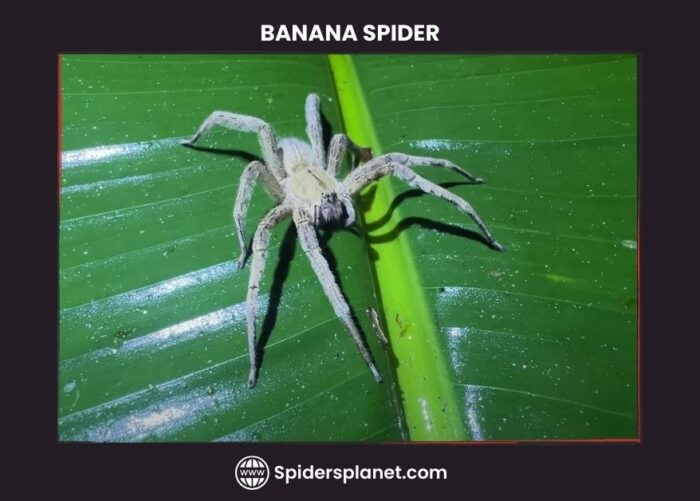
But it is often a case of mistaken identity. Only a few Phoneutria species have been found in banana shipments, and sometimes, other spiders get the blame due to misidentification.
What They Like to Eat or Hunt?
Their food includes flies, beetles, butterflies, moths, grasshoppers, locusts, and crickets. Occasionally, they might even feast on small creatures like amphibians, reptiles, or mice. All these diet or food findings tell us about how diversified eating habits these fascinating spiders have.
Mating and Lifecycle:
Like most spiders, the female spiders are bigger than the males. When the male spider wants to be friends, they do a little dance (vibrating his pedipalps and specialized sensory appendages) to signal his intentions to impress the female, but it is a cautious approach.
The behavior of the female can be choosy, and she might say no to a few before picking the right one.
After the dance, sometimes, the females decide to attack them, or if she is interested, she can store the male’s baby-making material in a special place until she is ready to use it.
Then, she lays a bunch of eggs, up to 1,000 at a time, and keeps them safe in a silk egg sac. Sadly, after laying her eggs, the mom spider says goodbye. It is her way of making sure the new spiders are ready to explore the world on their own.
The lifespan of the banana spider (Phoneutria nigriventer) differs for males and females. Females usually live for 6 to 8 weeks after reaching maturity, while males have a shorter lifespan of 2 to 3 weeks after their last molt.
Certain mammals, like coatis (Procyonidae, which includes raccoons) and other small insectivores, birds are potential predators of large wandering spiders.
These spiders got their name as wandering spiders because of the fact that they are not into web building. Instead, they stroll around the forest floor at night(nocturnal), searching for dinner.
Brazilian Wandering Spiders are active hunters and use both ambush tactics and direct attacks to catch their prey. During the day, they prefer cozy spots like under logs or in crevices, only emerging at night for their hunting adventures. These spiders do not build nests like other spider species.
While wandering spiders are not naturally aggressive towards humans, they won’t hesitate to bite if they feel cornered or threatened. Most bites happen when a spider accidentally gets trapped in clothing or bedding.
Bite and Venom:
The bite of the armed spider is the most dangerous in the world as the venom it carries can be harmful to humans.
The danger is not just about how strong the venom is; it is also about factors like the spider’s likelihood to bite and how close it is to where people live.
These spiders often hide in houses, clothes, and other dark places during the day, making accidental bites more likely.
While their fangs are adapted for small prey, some experts think they might give a “dry” bite in defense to save venom. Studies suggest that not all bites inject venom, and serious cases requiring antivenom are rare.
However, there have been confirmed cases of death, with symptoms appearing quickly, including:
- Severe pain
- Breathing difficulties
- Increased heart rate and blood pressure
- In severe cases, paralysis and death
The severity can depend on the spider’s sex, with females generally more dangerous. The spiders produce less venom in colder months, and a small amount can be potent enough to harm.
Fortunately, bites from Brazilian spiders are rare, and when they do occur, the exposure to the toxins is generally mild, as explained by Vetter.
Also Read: What is a Huntsman Spider? (Heteropodidae) – The Ultimate Guide
Banana Spider’s Facts:
Below are essential details about Brazilian wandering spiders:
- They hold the title for the world’s largest spiders , boasting leg spans reaching up to 15 centimeters (6 inches).
- Their venom packs a powerful punch, capable of inducing severe pain, paralysis, and, in extreme cases, fatal outcomes for humans.
- Despite their intimidating reputation, they are generally non-aggressive and resort to biting only when provoked.
- These spiders inhabit tropical rainforests and urban areas across Central and South America.
- In case someone has been bitten by this spider, he/she needs quick medical treatment to control the effects timely.
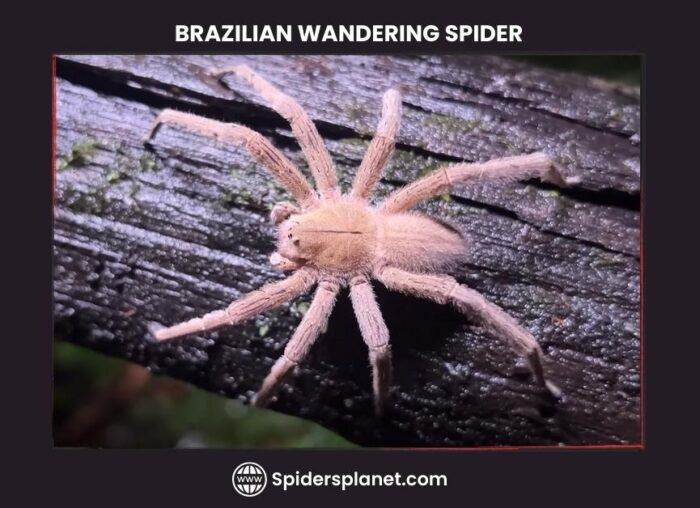
Treatment and Preventive Measures:
If bitten by a wandering spider or armed spiders, prompt medical attention is crucial. There is an antivenom for the spider’s venom, but its effectiveness is highest when administered within a few hours of the bite.
To prevent a bite:
- Wear protective clothing, use shoes and long pants when in areas where these spiders are found.
- Before wearing your clothes and shoes, make sure to check them to ensure no spiders are hiding.
- Maintain cleanliness and avoid leaving food or garbage exposed, as this can attract spiders.
These preventive measures are essential for minimizing the risk of encountering and getting bitten by Banana spiders.
Can Brazilian spiders kill humans?
Brazilian wandering spiders (Phoneutria nigriventer) are venomous and can potentially kill a human with a single bite. Their venom contains a potent neurotoxin that can cause severe pain, paralysis, and even death.
Are Brazilian spiders poisonous?
Yes the venom of this spider is poisonous, that can cause death. While Brazilian wandering spiders are potentially dangerous, actual bites are relatively rare.
By adopting preventive measures and promptly seeking medical attention if bitten, the risk of serious complications can be significantly reduced.
Can you keep Brazilian spiders as pets?
It is strongly advised against keeping wandering spiders as pets due to their venomous nature and the potential risk to human safety.
Managing these spiders in captivity demands specialized knowledge and handling procedures to minimize the risk of bites.
Final Thoughts:
The Brazilian wandering spider, banana spider, or armed spider is a large and venomous arachnid found in Central and South America. While their potent venom can be harmful to humans, encounters are rare.
These nocturnal hunters have adopted various habitats, from rainforests to urban areas, and are associated with banana shipments. Understanding their appearance, behavior, and habitat is crucial for minimizing risks.
Seeking immediate medical attention after a bite is essential, as antivenom is available but most effective when administered promptly. Despite their fearsome reputation, the Brazilian spider remains a captivating and potentially dangerous species.
About the author
Spiders Planet is the ultimate source of information about spiders! All the articles on this site will provide you with the most accurate and up-to-date information written by me and a group of writers, that is well-researched and fact-checked before it’s published.
Leave a Reply Cancel reply
Your email address will not be published. Required fields are marked *
Save my name, email, and website in this browser for the next time I comment.
Latest posts

Do Spiders Eat Fruit? Unveiling the Secrets
The connection between animals and fruits showcases a captivating example of mutualism, a win-win relationship where both parties benefit. Animals gain access to…

Are Woodlouse Spiders Venomous?
The Woodlouse spider (Dysdera crocata) is a spider species that mainly hunts and feeds on woodlice and is mostly found in Africa, Asia,…

What Does Wolf Spiders Eat?
Wolf spiders are excellent hunters of small insects. Unlike spiders that weave intricate webs, these predators rely on sharp vision and stealthy moves…

Wandering Spider: All You Need to Know in a Nutshell
Wandering spiders are a group of venomous arachnids found primarily in South America.
Among these, the Brazilian wandering spider is particularly known for its potent venom and unique behavior. They are often referred to as “banana spiders” due to their frequent encounters with humans in banana plantations.
As a reader, you might be interested in learning more about these fascinating creatures, including their habitat, hunting techniques, and the effects of their venom.
In this article, we will delve into the world of wandering spiders and provide you with all the essential information to satisfy your curiosity.

Scientific Classification and Naming
The wandering spider belongs to the genus Phoneutria , which is a part of the Ctenidae family.
These spiders are known for their potent venom and aggressive behavior. Here is the scientific classification of the wandering spider:
- Kingdom: Animalia
- Phylum: Arthropoda
- Subphylum: Chelicerata
- Class: Arachnida
- Order: Araneae
- Family: Ctenidae
- Genus: Phoneutria
Within the genus Phoneutria, two species are particularly noteworthy: Phoneutria fera and Phoneutria nigriventer, also known as P. nigriventer . These spiders are primarily found in South America and other tropical regions.
Phoneutria fera and P. nigriventer differ in some aspects. Let’s compare their features using a table:
Some key characteristics of the wandering spiders in the genus Phoneutria include:
- Potent venom that can be dangerous to humans
- Nocturnal hunters and are active at night
- Equipped with long, spiny legs for capturing prey
- Aggressive defenders of their territory
By understanding the scientific classification and differences between Phoneutria species, you can better appreciate the diversity and fascinating biology of these wandering spiders.
Identification and Appearance
Color and size.
The wandering spider, also known as the banana spider, has a distinctive appearance that can help you easily identify it in the wild.
They usually have a combination of hairy brown and black colors on their body. Their size can vary, but they are generally considered large spiders. Their size can range from 1 to 2 inches in body length.

When it comes to wandering spider’s leg span, these creatures can have an impressive reach. Their leg span can extend up to 5-6 inches.
Some key characteristics of a wandering spider’s legs include:
Habitat and Distribution
Wandering Spiders are known to inhabit various environments, including rainforests and tropical forests.
These spiders can adapt to different habitats based on their needs and availability of food sources. They prefer warm and humid places, as these conditions suit their growth and reproduction.
Geographical Coverage
Wandering spiders are found in Central and South America .
They live in forests from Costa Rica to Argentina, including Colombia, Venezuela, The Guianas, Ecuador, Peru, Bolivia, Brazil, Paraguay, and Northern Argentina.
They may also be present in some parts of the United States, particularly in the northern part of southern America.
However, they don’t inhabit countries like Australia. In summary, the Wandering Spider is mostly prevalent in the following areas:
- South America
- Central America
- Southern parts of the United States
Types of Wandering Spiders
Here’s a brief description of the major types of wandering spiders.
Brazilian wandering spiders
Also known as armed or banana spiders, these spiders are nocturnal and don’t make webs.
They are known to have been transported outside of South America in banana shipments.
Phoneutria nigriventer
These spiders contain neurotoxins that can cause cerebral changes and breakdown of the blood-brain barrier .
Their venom is medically significant and has been used in manufacturing drugs. Their bites may be fatal to children.
Ctenus captiosus
Also known as the Florida false wolf spider or tropical wolf spider, this species is found in the United States.
Some species of these spiders are large and scary-looking, but they’re only mildly venomous. Their venom is comparable to a bee sting.
Other types of wandering spiders include: Acantheis, Acanthoctenus, Africactenus, and Afroneutria.

Behavior and Diet
Aggression level.
Wandering spiders, as their name suggests, are known for their aggressive behavior .
While they won’t attack without provocation, if they feel threatened, they will not hesitate to defend themselves.
This is especially true during mating season.
Prey and Predators
In their natural habitat, wandering spiders primarily feed on insects and small vertebrates, such as:
- Insects like ants and moths
- Small amphibians
This diverse diet allows them to thrive in various ecosystems.
However, they are not top predators, as their natural predators include larger birds, mammals, and other spiders.
Nocturnal Activities
Wandering spiders are nocturnal creatures , which means they are active during the night.
During the day, they remain hidden in their retreats, often made from rolled-up leaves or small crevices.
At night, they leave their hiding spots to search for prey using their strong hunting skills.

Venom and Its Effects
Composition of venom.
The venom of the wandering spider is a complex mixture containing several toxic components.
Its main component is a potent neurotoxin, which can have severe effects on your nervous system 1 . Here’s a brief overview of its composition:
- Neurotoxins
Symptoms and Severity
A wandering spider’s venomous bite can cause a wide range of symptoms, depending on the severity of envenomation. These symptoms may include 2 :
- Mild to moderate pain
- Redness and swelling at the bite site
- Irregular heartbeat
- Difficulty breathing
- Blurred vision
- High blood pressure
Some severe cases may result in life-threatening complications, such as respiratory failure or even death 2 .
Medical Treatment and Antivenom
If bitten by a wandering spider, it’s crucial to seek immediate medical attention. Treatment often involves the following steps:
- Cleaning and immobilizing the affected area
- Monitoring and managing the symptoms
- Administering antivenom if it’s available and appropriate, depending on the severity of envenomation 3
Antivenom is specific to the venom of the wandering spider and can help neutralize its effects.
However, the availability of antivenom may be limited in some regions 3 .
Always remember that prevention is better than cure: learning how to identify and avoid wandering spiders is the best way to stay safe.

Reproduction and Mating
Mating ritual.
When it’s time for reproduction, the wandering spider undergoes an intriguing mating ritual.
The male spider performs a dance to attract the female by displaying his brightly colored legs and vibrating his body.
During the process, the male also produces a sperm web and transfers his sperm to the female’s reproductive organs using his pedipalps.
Egg Sacs and Offspring
After the mating process, the female wandering spider will create an egg sac to protect her eggs.
The sac consists of silk and can hold hundreds of eggs. She then attaches it to a safe hiding place, usually against a protective surface or within a secure web.
The female often guards the egg sac to ensure the protection of her offspring until they hatch.
Once the spiderlings hatch, they are known to be highly independent.
They disperse quickly and start their own journey, fending for themselves soon after emerging from the egg sac.
As they grow, they’ll go through a series of molts before reaching adulthood and beginning their own reproductive cycle.
Danger and Defense Mechanisms
The Wandering Spider is known to be one of the most dangerous spiders in the world.
Although they can potentially kill humans, fatalities are rare due to their reluctance to bite.
Oddly enough, their venom can cause an involuntary erection in men, alongside other painful symptoms.
Here are some ways the Wandering Spider protects itself and displays its dangerous nature:
- Fangs : These spiders are equipped with strong, sharp fangs that can easily pierce human skin, allowing them to inject their venom with ease.
- Venom : Their venom is potent and can cause severe pain, inflammation, and other adverse effects. In rare cases, it can even lead to death.
While interacting with Wandering Spiders, be cautious and observe them from a safe distance.
Knowing their defense mechanisms will help you respect their space and avoid any unpleasant encounters.
Remember, it’s essential to be informed and aware when dealing with these fascinating, yet dangerous creatures.

Comparison with Other Dangerous Spiders
Comparison to black widow.
The black widow spider is notorious for its potent venom, but the wandering spider has a stronger venom overall.
Both spiders are capable of causing severe symptoms, but the black widow’s venom is primarily neurotoxic, affecting your nervous system.
In contrast, the wandering spider’s venom can cause both neurotoxic and cytotoxic effects, potentially damaging your nerves and cells.
- Potent neurotoxic venom
- Red hourglass marking
- Stronger venom (neurotoxic and cytotoxic)
- No distinct marking
Comparison to Brown Recluse
The brown recluse spider is known for its necrotic venom that can lead to tissue damage and sometimes requires medical intervention.
While both the brown recluse and wandering spider can produce venomous bites, wandering spiders are considered more dangerous due to the potency of their venom and the severity of their bite symptoms.
- Necrotic venom
- Dark violin-shaped marking
Comparison to Wolf Spider
Wolf spiders are frequently mistaken for more dangerous spiders due to their size and appearance.
Although they can bite, their venom is not particularly potent and generally only causes mild itching, redness, and swelling.
In comparison, the wandering spider’s venom is far more dangerous, and its bite can result in serious symptoms, requiring immediate medical attention.
- Large and hairy
- Smoother appearance
Comparison to Sydney Funnel-Web Spider
The Sydney funnel-web spider is another highly venomous spider known for its potentially lethal bites.
While both spiders possess powerful venom, the wandering spider has a broader range of symptoms due to the combination of neurotoxic and cytotoxic effects.
In conclusion, wandering spiders are more dangerous than wolf spiders but their venom’s effects are more varied compared to black widows, brown recluses, and Sydney funnel-web spiders.
Be cautious around these spiders and seek medical help if bitten.
Interesting Facts and Guinness World Records
The Wandering Spider, also known as the Brazilian Wandering Spider, is a fascinating creature that has caught the attention of many.
They belong to the genus Phoneutria , which means “murderess” in Greek, giving you an idea of their potency. Let’s explore some interesting facts about this spider and its place in the Guinness World Records.

First, you might be curious about their venom. The Wandering Spider is known for having one of the most potent venoms among spiders.
In fact, it holds the Guinness World Record for the most venomous spider. Their venom contains a potent neurotoxin that can cause severe symptoms, including difficulty breathing, high blood pressure, and intense pain.
Apart from their venom, their behavior is also quite intriguing. These spiders are called “wandering” because they are known for actively hunting their prey rather than spinning webs to catch them.
They are mostly nocturnal creatures and, during the day, can be found hiding in logs or dark crevices.
Here are a few more notable characteristics of the Wandering Spider:
- Females are larger than males, with a body length of up to 1.6 inches (4 cm).
- They have eight eyes, arranged in two rows, which help them in hunting.
- The Wandering Spider is primarily found in Central and South America, particularly in Brazil.
- They are known to show aggression when threatened.
While the Wandering Spider is a marvel of the arachnid world, it’s essential to keep a safe distance from them due to their venomous nature.
However, their unique characteristics and record-breaking venom potency make them a fascinating subject for those interested in the natural world.
Prevention and Safety Measures
To protect yourself from wandering spiders, there are some simple safety measures you can take.
Firstly, be cautious in areas where these spiders may live, such as dark and warm spaces. For example, avoid reaching into crevices or lifting piles of wood without inspecting them first.
Always wear appropriate shoes when outdoors, particularly in wooded or grassy areas. This can help prevent bites on your feet or ankles.
Reduce the risk of wandering spiders entering your home by sealing gaps and cracks. This minimizes the chance of the spiders finding a way inside.
Regularly clean your living spaces, paying special attention to dark and hidden areas. By maintaining a clean environment, you’ll discourage wandering spiders from making themselves at home.
When out in nature, avoid disturbing spider habitats like webs or egg sacs. This can prevent agitating wandering spiders, reducing your chance of accidental encounters.
Remember, wandering spiders can be dangerous, but by taking these precautions, you can significantly reduce your risk of encountering them or being bitten. Stay safe and always be aware of your surroundings.
In summary, wandering spiders, particularly those in the genus Phoneutria, are a group of venomous arachnids predominantly found in Central, South America and parts of Southern United States.
These spiders, including the Brazilian wandering spider, are known for their potent venom, nocturnal hunting habits, and aggressive defense mechanisms.
Their venom, containing neurotoxins and other components, can cause severe symptoms in humans, making them one of the most dangerous spider species.
Despite their fearsome reputation, fatalities are rare, and they play a vital role in their ecosystems.
It’s important to respect their space and take preventive measures to avoid encounters. Understanding these spiders’ behavior, habitat, and characteristics can help in appreciating their role in nature while ensuring safety.
https://www.ncbi.nlm.nih.gov/pmc/articles/PMC2857337/ ↩
https://www.ncbi.nlm.nih.gov/pmc/articles/PMC3851068/ ↩ ↩ 2
https://www.ncbi.nlm.nih.gov/pmc/articles/PMC6560916/ ↩ ↩ 2
Reader Emails
Over the years, our website, whatsthatbug.com has received hundreds of letters and some interesting images asking us about wandering spiders. Scroll down to have a look at some of them.
Letter 1 – Wandering Spider from Ecuador

Hi Michele, There is a resemblance to the Dolomedes Fishing Spiders, and finding it near a river lends credence to that possibility. Eric Eaton noticed this posting and has this to say: ” Ok, the spiders from Ecuador and Costa Rica: They are most likely NOT wolf spiders, but wandering spiders, either in the family Ctenidae or Sparassidae. They tend to be more common, and even larger than, wolf spiders in the tropics. At least one species, Phoneutria fera, is extremely aggressive, with potentially deadly venom. Do not mess with large spiders in Central and South America! The venomous types are very difficult to distinguish from harmless species, and in any event, a bite is going to be really painful. These spiders sometimes stow away in bananas, houseplants, and other exported goods, so they can show up in odd places. Be careful where you put your hands.”
Update: May 14, 2013 We now have a confirmation that this is a Wandering Spider, Phoneutria fera , and it is a dangerous species. See Encyclopedia Britannica and Animal Corner .
Letter 2 – Brazilian Wandering Spider: Most Venomous Animal

Hi Martin, We are happy you were able to write to us after your encounter with this Brazilian Wandering Spider and are thrilled to be able to post your story and photos to our site. We started to research, and our first hit has a different species name. Phoneutria fera is described as: “The Brazilian Wandering Spider is not for the ‘pet keeper’. Brazilian Wandering Spiders are extremely fast, extremely venomous, and extremely aggressive. These large and dangerous true spiders are ranked among the most venomous spiders known to man. In fact, the Brazilian Wandering Spider is the most venomous spider in the New World! In South America, these true spiders are commonly encountered in peoples’ homes, supposedly hiding in peoples’ shoes, hats, and other clothes. The Brazilian Wandering Spider does not remain on a web, rather, it wanders the forest floor, hence the name.” Our favorite information on Wikipedia is that Phoneutria is Greek for “murderess”. Here is one final tidbit about the effect of the bite of the Brazilian Wandering Spider on the human male .
Letter 3 – Possibly Wandering Spider from Ecuador

Dear Mike, This is really an interesting Spider, but other than to say it appears to be a hunting spider that does not build a web to entrap prey, we aren’t sure about its identity. Many hunting spiders can jump quite well. It looks very much like the spider in a posting in our archives, also from Ecuador, that we identified as possibly a Wandering Spider in the genus Phoneutria, a venomous and potentially dangerous genus . The spotted legs on your individual look like the spotted legs on an individual in an image on Wikipedia of a Wandering Spider in the genus Phoneutria . There are many images of Brazilian Wandering Spiders on Primal Shutter and we believe that might be a correct identification for your individual.
Thank you for the information. After reading more about the spider, I’m glad it didn’t jump! Mike
Letter 4 – Possibly Wandering Spider from Ecuador

Dear Carl, We believe, though we are not certain, that this might be a Wandering Spider in the genus Phoneutria, and you may read more about Wandering Spiders on the Museum für Naturkunde Karlsruhe website where it states: “There is no doubt that the venom of some of the species is quite potent for mammals, including humans.” We eagerly welcome additional opinions on this identification. Perhaps Cesar Crash of Insetologia can provide something. In the future, please submit a single species per submission form as it makes it extremely difficult for us to categorize postings with multiple species.
Letter 5 – Wandering Spider from Belize

Hi Karl, Thanks for allowing us to post your excellent image of a Wandering Spider, Cupiennius salei . The species is pictured on iNaturalist .
Bugman aka Daniel Marlos has been identifying bugs since 1999. whatsthatbug.com is his passion project and it has helped millions of readers identify the bug that has been bugging them for over two decades. You can reach out to him through our Contact Page .
View all posts

Piyushi is a nature lover, blogger and traveler at heart. She lives in beautiful Canada with her family. Piyushi is an animal lover and loves to write about all creatures.
8 thoughts on “Wandering Spider: All You Need to Know in a Nutshell”
Hi Michele, I am an Ecuadorian scientist and specialized on spiders, I would like to find one like yours, I can say that, almost without doubt, you found the Phoneutria itself, it is the Phoneutria fera, look at this picture: http://www.google.com/imgres?imgurl=http://4.bp.blogspot.com/-bFH9qzT0F7U/T_2sZuk6xAI/AAAAAAAAAGY/8jnMVcPOcNI/s1600/phoneutria_fera2.jpg&imgrefurl=http://rangerbaiano.blogspot.com/2012/07/animais-peconhentos-e-venenosos.html&usg=__iCWEz7S86xub6RAyvXTER6HBaco=&h=864&w=834&sz=215&hl=es-419&start=6&zoom=1&tbnid=jjOROVO9h-vKXM:&tbnh=145&tbnw=140&ei=99eRUY6xKo2K9QTLvYCoDQ&prev=/search%3Fq%3Dphoneutria%2Bfera%26sa%3DN%26hl%3Des-US%26sout%3D1%26tbm%3Disch%26prmd%3Divns&itbs=1&sa=X&ved=0CDYQrQMwBQ Can you see the similarities?, unfortunately the spider might be in a better life today 🙂 Another thing, when you want identifications you should take a picture in front, the under part, and the upper part, as well as some characteristics about behaviour like how they react when you approach. The Phoneutria is a very agressive one.. best wishes, bye.
Hi Miguel, Thanks so much for the comment. This is a seven year old posting and we did not have the ability to post comments when it was originally posted online. We have made an update on What’s That Bug? and your comment is greatly appreciated.
Ah, there is also needed the size and the picture of its face so we can see the eye arrangement, depending on that it could also be pisauridae, but I stay in Ctenidae..
This is a female Cupiennius sp. wandering spider.
Perhaps surprisingly, this ubiquitous large spider of the Mindo area appears to be undescribed to species level.
Although one is indeed best advised to exercise caution in the presence of large ctenids, members of the genus Cupiennius are not known to be dangerously venomous (Barth, 2002). By way of confirmation, my girlfriend, Shannon Bowley, managed to be bitten by a mature female of this Mindo species in 2013 – she felt only mild effects, equivalent to a bee sting.
Thanks for this valuable information.
I’m planning a trip to Ecuador and I’m fearing these spiders. Do they get in houses? Any tips to keep them out, so I can sleep at night?
Leave a Comment Cancel reply
Save my name, email, and website in this browser for the next time I comment.
Notify me of followup comments via e-mail. You can also subscribe without commenting.

AnimalBehaviorCorner

Brazilian Wandering Spider
Brazilian Wandering Spider , scientifically known as Phoneutria, emerges as a captivating enigma in the realm of arachnids.
Renowned for its formidable reputation as one of the world’s most venomous spiders , Phoneutria embodies a plethora of intriguing traits that have captured the curiosity of enthusiasts and researchers alike.
From its distinctive appearance and neurotoxic venom to its nomadic hunting strategies and unique mating behaviors , this remarkable spider species holds a wealth of fascinating secrets waiting to be unraveled.
Join us as we embark on a journey to explore the captivating world of the Brazilian Wandering Spider, shedding light on its captivating characteristics and dispelling myths that have shrouded its true nature.
1. Taxonomy and Distribution of the Brazilian Wandering Spider
A. scientific classification of phoneutria.
The Brazilian Wandering Spider, scientifically referred to as Phoneutria, occupies a distinct place within the arachnid taxonomy.

Belonging to the family Ctenidae, this spider genus is further categorized into several species, each boasting unique traits and behaviors .
Phoneutria’s taxonomic position not only distinguishes it from its arachnid counterparts but also underscores its intriguing evolutionary journey.
B. Native Habitat in South and Central America
Endemic to the lush landscapes of South and Central America, the Brazilian Wandering Spider finds its natural haven within these diverse regions.
From the rainforests of the Amazon to the tropical stretches of the Caribbean, Phoneutria has adapted to a range of environments over the course of its evolution.
The spider’s ancestral ties to these regions are tightly woven into their behaviors , anatomy, and survival strategies.
C. Preference for Tropical Rainforests and Urban Areas
Within its native territories, the Brazilian Wandering Spider exhibits remarkable versatility in its chosen habitats.
While it thrives amidst the vibrant biodiversity of tropical rainforests, it has also displayed a propensity for urban locales.

Phoneutria’s adaptability has led it to establish a presence in urban areas, where it often finds shelter in crevices, gardens, and even human dwellings.
This adaptability to both wild and urban spaces further showcases the spider’s resilience and capacity to thrive in varying conditions.
2. Physical Characteristics of the Brazilian Wandering Spider
A. size, coloration, and distinctive markings.
The Brazilian Wandering Spider , a creature of remarkable visual intrigue, boasts an array of captivating physical attributes.
Ranging in size from a few centimeters to several inches, Phoneutria showcases a size diversity that reflects the breadth of its genus.
Its coloration varies across species, encompassing shades of brown, black, and gray, often accompanied by intricate patterns and markings that adorn its exoskeleton.
These unique markings serve not only as a visual spectacle but also as essential components of its survival toolkit.
B. Camouflage and Defense Mechanisms
The Brazilian Wandering Spider’s appearance is a masterpiece of evolution, meticulously crafted to ensure both survival and predation .

Its coloration and markings are tailor-made for blending seamlessly into its surroundings, granting it a potent advantage in ambushing prey and evading predators . Moreover, these markings also play a role in its defense mechanisms.
When threatened, Phoneutria adopts a defensive posture, raising its front legs and revealing its striking markings, a visual warning to potential threats. This dual-purpose camouflage and defense strategy exemplify nature’s ingenuity at its finest.
C. Sexual Dimorphism: Unveiling Gender Differences
A fascinating facet of the Brazilian Wandering Spider lies in the realm of sexual dimorphism , where gender-based variations manifest in pronounced ways.
Females tend to be larger and more robust than their male counterparts, showcasing a size disparity that has evolved in tandem with their roles in reproduction and hunting .
Beyond size, other characteristics, such as leg structure and coloration, also exhibit subtle differences between male and female Phoneutria specimens.
This divergence in physical traits adds depth to our understanding of the species’ intricate biology and behavior .
In exploring the physical characteristics of the Brazilian Wandering Spider , we uncover a canvas painted with size diversity, intricate coloration, and unique markings.
These features, finely tuned by evolution, contribute to its prowess in camouflage and defense, while the fascinating interplay of sexual dimorphism further enriches our perception of this captivating arachnid species .
3. Venomous Nature of the Brazilian Wandering Spider
A. potent neurotoxic venom: a silent lethal weapon.
The Brazilian Wandering Spider, known scientifically as Phoneutria, harbors a venomous arsenal that stands as a testament to nature’s intricate design.

This spider’s venom contains a potent concoction of neurotoxic compounds, tailored by evolution to incapacitate its prey swiftly and efficiently.
The neurotoxins interfere with nerve cell communication, leading to paralysis and ensuring that Phoneutria’s quarry is rendered immobile and defenseless, setting the stage for a successful meal.
B. Effects on Prey and Human Hazard
When a victim succumbs to the Brazilian Wandering Spider’s venom , the effects are a symphony of paralysis and predation .
The venom’s impact on the prey’s nervous system results in swift immobilization, offering the spider a decisive advantage in subduing its catch.
While this venomous efficiency is well-adapted for predation, it also underscores the potential danger to humans.
A bite from Phoneutria can lead to a series of neurotoxic reactions, with varying degrees of severity depending on factors such as the individual’s age and overall health.
While human envenomations are relatively rare, they can result in a range of symptoms, from localized pain and swelling to more severe neurological effects.
C. Recorded Cases of Envenomations: Unraveling the Symptoms
Throughout history, documented cases of Phoneutria envenomations have offered insights into the spider’s potential threat to humans .

Symptoms typically include intense pain at the bite site, accompanied by swelling and redness . In some instances, victims have reported systemic reactions, such as muscle cramps, elevated heart rate, and even breathing difficulties.
Swift medical attention and the administration of antivenom have proven effective in mitigating the severity of these symptoms.
These cases serve as a reminder of the delicate balance between the Brazilian Wandering Spider’s potent venom and the potential risks it poses to those who unwittingly encounter it.
4. Hunting and Diet of the Brazilian Wandering Spider
A. hunting techniques and wandering behavior.
The Brazilian Wandering Spider, scientifically known as Phoneutria, unveils a mesmerizing repertoire of hunting techniques that set it apart as a master predator .
Displaying an agile and nomadic behavior , Phoneutria does not confine itself to the confines of a web. Instead, it actively prowls its surroundings, tirelessly searching for potential prey.
This dynamic wandering behavior ensures that its chances of encountering a variety of food sources are maximized, showcasing a strategic approach to sustenance.
B. Active Hunting Triumphs Over Web-Building
Unlike its web-weaving counterparts, the Brazilian Wandering Spider relies on a more hands-on approach to securing its next meal.
While weaving webs might seem an efficient method, Phoneutria’s active hunting strategy offers a distinct advantage in versatility.
By forgoing the constraints of a stationary web, it can tailor its approach to suit different environments and prey types, adapting its tactics on the fly.
This adaptability demonstrates the spider’s remarkable ability to adjust its methods for optimal results.
C. Diverse Prey Spectrum: Insects to Small Vertebrates
Phoneutria’s diet is a testament to its prowess as an opportunistic predator . Its menu spans a diverse range of creatures, from insects like crickets and cockroaches to small vertebrates such as lizards and frogs , and even small rodents.

This wide-ranging palate highlights its ecological significance in controlling various populations within its habitat.
By consuming creatures both large and small, Phoneutria ensures a balanced ecosystem, playing a crucial role in maintaining biodiversity and ecological equilibrium.
5. Mating and Reproduction of the Brazilian Wandering Spider
A. courtship rituals and behaviors: a complex affair.
The Brazilian Wandering Spider, scientifically referred to as Phoneutria, reveals a captivating array of courtship rituals and behaviors that form the cornerstone of its reproductive cycle.
Courtship among these arachnids is a complex affair, involving intricate dances and displays that serve as both communication and assessment.
Male Phoneutria employs a combination of visual cues, vibrations, and tactile interactions to court potential mates.
This elaborate courtship process highlights the significance of precise communication in the delicate dance of reproduction .
B. Cannibalistic Tendencies: A Post-Mating Phenomenon
An aspect that sets Phoneutria’s mating process apart is the notorious cannibalistic tendency exhibited by females after mating.
Following successful mating, females may exhibit an inclination to consume their partners. This seemingly counterintuitive behavior has evolutionary underpinnings.
It is believed that this cannibalistic act not only provides the female with a much-needed nutritional boost but also eliminates potential competitors and safeguards the male’s investment in the next generation.
This intriguing behavior sheds light on the complexities of reproductive strategies within the species.
C. The Unique Mating Plug Phenomenon: A Puzzling Enigma
A distinctive feature in Phoneutria’s reproductive saga is the enigmatic mating plug phenomenon. After mating, male Phoneutria deposit a specialized substance that forms a plug within the female’s reproductive tract.
This plug is believed to serve multiple purposes. It may prevent other males from mating with the female, thus ensuring the successful transmission of the mating male’s genetic material.
Additionally, it might aid in sealing off the female’s reproductive tract, potentially protecting her from external pathogens.
This phenomenon underscores the intricate interplay of biological strategies that contribute to the species’ reproductive success.
6. Human Interaction and Urban Legends of the Brazilian Wandering Spider
A. occasional presence in urban areas: nature in our midst.
The Brazilian Wandering Spider, scientifically known as Phoneutria, has carved a niche for itself not only in the wild but also in the fabric of urban environments.

While its primary habitats are the lush landscapes of South and Central America, Phoneutria occasionally ventures into human -inhabited spaces. Its adaptability allows it to find shelter in gardens, crevices, and even within homes.
This coexistence with humans adds an intriguing dimension to our encounters with this enigmatic arachnid .
B. Debunking Misconceptions: Separating Fact from Fiction
The presence of the Brazilian Wandering Spider has sparked a plethora of misconceptions and exaggerated tales, contributing to the creation of urban legends.
Stories of spiders leaping from banana bunches or hiding under toilet seats have become part of modern folklore, often fueled by sensationalism.
It’s crucial to sift through these tales and recognize that while Phoneutria’s venom is potent, the likelihood of encountering a dangerous encounter is relatively low.
Separating fact from fiction empowers individuals to approach these creatures with accurate knowledge.
C. Importance of Proper Education: Identifying Friend from Foe
Education plays a pivotal role in fostering a harmonious coexistence between humans and the Brazilian Wandering Spider .
Learning to identify and understand the behaviors of Phoneutria species enhances safety for both humans and the spiders themselves.
Instead of succumbing to unwarranted fear, individuals can take steps to reduce the chances of accidental encounters and, if necessary, engage in responsible removal methods.
By arming themselves with knowledge, individuals can navigate encounters with urban-dwelling Phoneutria specimens with confidence and respect.
7. Brazilian Wandering Spider Conservation and Misunderstanding
A. significance of phoneutria in ecosystem dynamics.
The Brazilian Wandering Spider , scientifically termed Phoneutria, assumes a pivotal role within its ecosystem, contributing to a delicate balance of populations and interactions.

As a top-tier predator , it plays a crucial part in controlling insect and small vertebrate populations, preventing unchecked growth that could disrupt the ecosystem’s equilibrium.
By maintaining these population dynamics, Phoneutria ensures the health and stability of its habitat, highlighting its significance beyond its ominous reputation.
B. Impact of Fear and Misunderstanding: Hindrances to Conservation
Despite its ecological contributions, the Brazilian Wandering Spider often falls victim to fear-driven misconceptions that negatively impact conservation efforts.
Misunderstandings surrounding its behavior and potential danger can lead to unwarranted extermination campaigns and habitat destruction.
Fear-driven reactions not only disrupt the natural balance but also hinder opportunities to study and appreciate the species for its ecological significance.
Addressing these misconceptions is crucial to ensuring the spider’s survival and maintaining the health of its ecosystems.
C. Efforts to Dispel Myths and Promote Coexistence
Efforts to conserve the Brazilian Wandering Spider are interwoven with endeavors to educate and dispel myths.
By providing accurate information and dispelling exaggerated tales, conservationists aim to reshape public perception.
Collaborative initiatives emphasize coexistence, highlighting the importance of responsible behavior when encountering Phoneutria.
Educating communities about the spider’s role, behavior, and conservation status fosters an environment where fear gives way to appreciation, and where balanced cohabitation becomes a reality.
8. Research and Medical Significance of the Brazilian Wandering Spider
A. ongoing scientific research on phoneutria venom.
The Brazilian Wandering Spider , Phoneutria, has garnered significant attention from the scientific community due to the unique properties of its venom.
Ongoing research delves into the intricate composition of the venom, aiming to unlock its mysteries and potential applications in various fields.
The diverse array of compounds within the venom, particularly its neurotoxic components, has attracted interest for their potential medical and therapeutic implications.
B. Antivenom Development and Therapeutic Prospects
One of the most promising areas of research surrounding Phoneutria lies in the development of antivenoms and therapeutic agents.

The venom’s potent neurotoxic effects on the nervous system have spurred efforts to create targeted treatments for conditions such as chronic pain and neurological disorders .
Additionally, the potential for antivenoms holds promise in mitigating the effects of envenomations, offering a lifeline for individuals who encounter these spiders .
This focus on harnessing the venom’s properties for positive medical outcomes highlights the transformative potential within this enigmatic arachnid .
C. Balanced Perspectives: Navigating Ethical and Scientific Endeavors
While research on the Brazilian Wandering Spider’s venom offers tremendous potential, it necessitates a balanced perspective.
As researchers probe the venom’s properties, ethical considerations arise, including the well-being of the spiders and their ecosystems.
A holistic approach acknowledges the value of understanding Phoneutria’s natural behaviors and conserving its habitats.
This balanced perspective extends to utilizing the venom’s potential responsibly, ensuring that breakthroughs are achieved while respecting the complex interplay of science and nature.
9. Frequently Asked Questions about the Brazilian Wandering Spider
What is the brazilian wandering spider.
The Brazilian Wandering Spider , scientifically known as Phoneutria, is a venomous arachnid found in South and Central America. It’s notorious for its potent venom and is considered one of the most venomous spiders in the world.
Is the Brazilian Wandering Spider dangerous to humans?
Yes, the Brazilian Wandering Spider’s venom contains potent neurotoxins that can cause a range of symptoms in humans , from localized pain and swelling to more severe reactions. While bites are relatively rare, it’s advisable to exercise caution when encountering these spiders.
What is the spider’s habitat?
The Brazilian Wandering Spider is native to tropical rainforests of South and Central America. However, it’s adaptable and can also be found in urban areas, such as gardens and houses.
How does the Brazilian Wandering Spider hunt?
Unlike many spiders that build webs, Phoneutria is an active hunter. It roams its environment in search of prey, relying on its keen senses to detect vibrations and movements.
Are Brazilian Wandering Spiders aggressive toward humans?
Brazilian Wandering Spiders are not naturally aggressive towards humans and will typically only bite in self-defense. However, caution is advised, especially in areas where these spiders are known to inhabit.
Can the Brazilian Wandering Spider’s venom be used for medical purposes?
Yes, research is ongoing into the potential medical applications of Phoneutria’s venom. Its neurotoxic properties have sparked interest in pain management and neurological treatments.
Is the spider’s reputation for crawling into banana shipments true?
While there have been stories of Brazilian Wandering Spiders being found in shipments of bananas, these occurrences are extremely rare. Spiders are unlikely to survive the conditions of shipping and storage.
How can I stay safe around Brazilian Wandering Spiders?
To stay safe, it’s important to be cautious when encountering spiders in their natural habitat. Avoid provoking or handling them, especially if you’re unsure of their identity. If you suspect you’ve been bitten, seek medical attention promptly.
Are there any efforts to conserve the Brazilian Wandering Spider?
Conservation efforts for the Brazilian Wandering Spider are intertwined with public education and dispelling myths. Recognizing its role in ecosystems and promoting coexistence are essential steps in preserving this unique species.
What can I do if I find a Brazilian Wandering Spider in my home?
If you encounter a Brazilian Wandering Spider in your home, it’s advisable to contact local pest control professionals who can safely remove the spider without causing harm.
In the intricate tapestry of nature, the Brazilian Wandering Spider , Phoneutria, emerges as a creature of both fascination and caution.
Its venomous nature and captivating behaviors have earned it a place among the most enigmatic arachnids .
As we continue to explore its world, debunk myths, and understand its vital role in ecosystems, we find a delicate balance between awe and respect.
Armed with knowledge, we navigate the realm of Phoneutria, appreciating its complexity while fostering coexistence, a testament to the intricate dance between humans and the natural world.
Share this:
Similar posts.

Bat Behavior
Bat Behavior, a captivating subject that delves into the secrets of these fascinating creatures, holds the key to understanding the intricacies of nature’s nocturnal aviators. As creatures of the night, bats exhibit a wide array of behaviors that are not only essential for their survival but also play crucial roles in maintaining ecological balance. From…

White Squirrels
Enter the captivating realm of white squirrels, where nature’s whimsy intertwines with centuries-old tales and local legends. White squirrels are captivating creatures that have captured the hearts and imaginations of people around the world with their unique appearance and endearing charm. In this article, we delve into the intriguing world of white squirrels, exploring their…

Giant Oceanic Manta Ray
Giant Oceanic Manta Ray is a magnificent creature that gracefully navigates the depths of our vast oceans. In this article, we delve into the extraordinary features and behaviors of these awe-inspiring beings, shedding light on the importance of studying and understanding them. Join us as we embark on a journey to uncover the secrets of…

Aardvarks vs Anteaters: Similarities and Differences
Are you curious about the similarities and differences between aardvarks vs anteaters? These enigmatic animals share certain characteristics while exhibiting distinct features that set them apart. In this article, we will embark on a fascinating journey to explore the intriguing world of aardvarks and anteaters. From their physical appearances to their unique adaptations and survival…

Armadillo Behavior
Armadillo behavior is a fascinating aspect of these unique creatures that inhabit various regions across the globe. Known for their distinctive armor-like shells and burrowing tendencies, armadillos display intriguing behavioral patterns that contribute to their survival in diverse ecosystems. Understanding armadillo behavior is essential not only for wildlife enthusiasts but also for those seeking effective…

Mourning Dove Behavior
Mourning doves are one of the most widespread and familiar birds in North America. They are also one of the most hunted species. Although mourning doves are not an endangered species, their populations have declined in recent years. Mourning doves are relatively small birds, with pale gray plumage and black spots on their wings. They…
We have emailed you a PDF version of the article you requested.
Can't find the email?
Please check your spam or junk folder
You can also add [email protected] to your safe senders list to ensure you never miss a message from us.
Brazilian Wandering Spider: One Of The World's Most Venomous Spiders May Be Lurking In Your Bananas
Complete the form below and we will email you a PDF version
Cancel and go back
IFLScience needs the contact information you provide to us to contact you about our products and services. You may unsubscribe from these communications at any time.
For information on how to unsubscribe, as well as our privacy practices and commitment to protecting your privacy, check out our Privacy Policy
Complete the form below to listen to the audio version of this article
Advertisement
Sign up today to get weekly science coverage direct to your inbox
© 2024 IFLScience. All Rights Reserved
Newsletters in your inbox!
Subscribe today for our Weekly Newsletter in your inbox!
These species are notoriously aggressive.
Eleanor Higgs
Digital Content Creator
Eleanor is a content creator and social media assistant with an undergraduate degree in zoology and a master’s degree in wildlife documentary production.
Book View full profile
Book Read IFLScience Editorial Policy
Francesca Benson
Copy Editor and Staff Writer
Francesca Benson is a Copy Editor and Staff Writer with a MSci in Biochemistry from the University of Birmingham.
DOWNLOAD PDF VERSION

This is one of the most dangerous spider species in the world.
Image Credit: Dr Morley Read/Shutterstock
Meet the Brazilian wandering spiders in the genus Phoneutria , also referred to as the armed spiders or the banana spiders. The members of this group have one of the most dangerous bites of any spider species on Earth and they have been classified as the world’s most venomous spider many times.
Where Do Brazilian Wandering Spiders Live?
Though currently the Guinness World Record is shared with another species – the Sydney funnel-web, ( Atrax robustus ) – the Brazilian wandering spiders are a force to be reckoned with.
As the name suggests all the Brazilian wandering spiders can be found in northern South America, with at least one species having distributions across more than just Brazil, writes the University of Florida . However, Phoneutria fera and Phoneutria nigriventer are the main species that feature in news articles as they often travel overseas in shipments of bananas, causing panic and confusion – and even the closure of supermarkets .
What Is The Size Of A Brazilian Wandering Spider?
The size of the Brazilian wandering spiders varies between species. Some can be very large with a leg span of 18 centimeters (7.1 inches). The spiders are famously quite aggressive, and instead of running from threats will rear up onto their back legs and stand their ground.

What Are The Effects Of A Brazilian Wandering Spider Bite?
Brazilian wandering spiders often make the news because of the unusual symptoms caused to humans after being bitten by one.
A 2023 study in Frontiers In Molecular Biosciences suggested there were around 4,000 cases of people being bitten by Phoneutria nigriventer in Brazil each year. Their venom affects the nervous system, causing double vision, salvation, irregular heartbeat – and even prolonged painful erections, known as priapism . In fact, because of this, their venom is being explored as a possible treatment for erectile dysfunction conditions.
Can A Brazilian Wandering Spider Bite Kill You?
The neurotoxin PhTx3 is to blame for these symptoms, and according to the Independent , a wandering spider bite can reportedly be fatal in as little as 60 minutes. However, an effective anti-venom is usually enough to save those affected. A study into Phoneutria boliviensis in 2019 suggested that the species had adapted its venom to catch vertebrates as opposed to lizards and amphibians, which might explain why the venom is so toxic to humans.
It comes as no surprise then that their scientific name Phoneutria means “murderess” in Greek.
ARTICLE POSTED IN
South America,
brazilian wandering spider,
creepy crawlies
More Nature Stories

Cicadapocaplypse: Map Shows Where In The US Up To A Trillion Bugs Could Soon Emerge

7 Animals With Some Of The Silliest Scientific Names

The World's Southernmost Active Volcano In Antarctica Spews Gold Dust

Is Orange Cat Behavior A Real Thing?

Ligers V Tigons: What's The Difference?

The Pentagon Has Released Several Videos Of Unexplained Anomalous Phenomena

15 Types Of Spiders, Ranked By Danger Level
I n the intricate web of the natural world, spiders are often painted as creatures of fear and danger. Yet, beneath the surface lies a reality often overlooked: spiders are typically shy and reserved beings, opting to avoid human interaction whenever possible. According to Kids Health , they only resort to biting when provoked or inadvertently trapped, contrary to the common misconception of them as aggressive predators.
When they do bite, spider bites, despite their notorious reputation, are generally harmless. While all spiders carry poison, not all spiders contain the glands necessary to deliver this poison to humans via bite. Technically, their poison would only cause harm to you if you ingested the spider. However, it's a different story when it comes to venomous spiders. These spiders do have the ability to inject humans with their venom via bites, and some venomous spiders possess toxins that can cause serious harm, leading to potentially severe consequences if not treated promptly.
While we might all freak out if we see bite marks on our bodies after recently encountering a spider, not all bites warrant a trip to the hospital. But some might. In this ranking, we'll explore 15 species of spiders, each with its unique level of danger if a bite were to occur.
Read more: 13 Creatures To Beware Of When Adventuring In California's Deserts
Cellar Spider
Pholcus phalangioides, also known as "daddy longlegs" or cellar spiders, belongs to the Pholcidae family. Recognized by their elongated legs and delicate appearance, they commonly inhabit dark, humid environments like basements, caves, and cellars, where they construct irregular webs to catch prey.
Cellar spiders are generally considered harmless to humans and typically display non-aggressive behavior. Preferring to avoid human contact, they are shy and reclusive creatures. Interestingly, they are beneficial as they contribute to controlling populations of other pests, such as flies and mosquitoes.
Despite their reputation, there are no documented cases of any pholcid spider biting humans and causing harm. However, a prevalent myth erroneously labels them as one of the most lethal spider species. This myth lacks scientific support, as the venom composition and potency of these spiders have never been formally studied. Studies indicate that if a person were to be bitten, the effects are usually mild and inconsequential. For instance, a 2019 study in Frontiers in Ecology and Evolution found minimal adverse reactions to bites from cellar spiders.
Common House Spider
The common house spider, scientifically known as Parasteatoda tepidariorum, is one of the most widespread and well-known spider species found in human habitats worldwide. Like daddy longlegs, these spiders are often encountered indoors, where they build irregular webs in corners, crevices, and other sheltered areas. However, they are distinguished by their darker ring-like pigmentation on their legs.
The threat level posed by common house spiders is minimal. They are not aggressive toward humans and are more likely to flee than bite when encountered. Additionally, their fangs are not well-suited for penetrating human skin, further reducing the likelihood of bites occurring. If one were to aggravate the common house spider so intensely that it does retaliate with a bite, their venom is relatively mild, rendering their bites typically harmless to humans (via Western Exterminator ). There has only been one case of a serious reaction to a bite by a common house spider, but this was because the victim was allergic (via the University of Florida IFAS ).
Yellow Sac Spider
The yellow sac spider, scientifically known as Cheiracanthium inclusum, is a globally distributed species found across various regions, including North America. These spiders are easily recognizable by their pale yellow to light green coloration. Despite their relatively lower profile compared to other spiders, yellow sac spiders have garnered interest due to their unique web-spinning behavior. Instead of the intricate webs commonly associated with spiders, they construct sacs using their silk, a behavior noted by Truly Nolen .
Regarding their potential danger to humans, yellow sac spiders are considered medically significant, although the extent of their threat remains a subject of debate. A study published in the American Journal of Tropical Medicine and Hygiene has shed light on this issue. The study discovered that in many cases where people thought yellow sac spiders caused severe reactions, subsequent searches didn't find any of these spiders nearby. The researchers suggested that in these cases, other bugs were probably the real culprits. However, because yellow sac spiders are common, they often get blamed for the bites.
In a comprehensive multi-year study covering the United States and Australia, these researchers confirmed that yellow sac spiders were involved in only about 20 reported spider bite cases. Usually, these bites caused intense pain around the bite spot, but symptoms didn't last long, and most people didn't need medical help, suggesting that yellow sac spiders do not serve the dangerous reputation they have garnered.
Jumping Spider
Jumping spiders, members of the Salticidae family, are renowned for their agility, acute vision, and unique hunting techniques. With a staggering diversity of over 5,000 described species inhabiting various ecosystems worldwide, these spiders stand out as some of the most charismatic and easily identifiable arachnids.
Despite their prevalence, jumping spiders are generally harmless to humans. Research cited in a Toxicon study suggests that although they account for around 5% of spider bites in Australia, their bites are typically mild and pose minimal risk. Affected individuals may experience minor discomfort, redness, and swelling akin to a mosquito bite at the site of the incident (via PestWorld ). Severe reactions or systemic effects are exceptionally rare and usually occur in individuals with heightened sensitivity or allergies to spider venom, according to PestWorld. It's important to note that jumping spiders are more inclined to leap away from humans than to engage in aggressive behavior, further minimizing the likelihood of encounters resulting in bites.
Huntsman Spider
Ah, the huntsman spider -- every Aussie's unofficial roommate, lurking in the corners of homes, sheds, and garages, always ready to surprise you with its impressive size and lightning-fast movements. Belonging to the family Sparassidae, these giants of the spider world are known for their agility and distinctive appearance that can send shivers down your spine faster than a kangaroo hopping by. But fear not! Despite their formidable size and fearsome reputation, huntsman spiders are actually quite beneficial. They happily feast on insects, playing a crucial role in keeping pest populations in check.
While huntsman spiders aren't shy about defending themselves if provoked, their bites are usually more of a nuisance than a cause for alarm. Think of it as similar to the annoyance of a bee or wasp sting: pain, redness, and swelling at the site of the bite (via Miche Pest Control ). Severe reactions or systemic effects are about as rare as finding a drop bear in your backyard. Only those with extreme sensitivity or allergies to spider venom need to worry, and even then, encounters are few and far between. So, rest easy knowing that your eight-legged roommates are more likely to skedaddle than show any aggression toward you.
Wolf Spider
Embodying the true essence of "lone wolves," these spiders have earned their name. Solitary by nature, the wolf spider, belonging to the family Lycosidae, lives and hunts independently, only coming together during mating season in the fall. With over 200 described species scattered across North America alone (via Terminix ), wolf spiders stand as one of the most prevalent and diverse spider families.
In terms of threat to humans, wolf spiders pose minimal danger. Preferring solitude, they typically steer clear of human interaction whenever possible. However, they may venture into human habitats in pursuit of prey or refuge, especially where their natural environments intersect with urban areas.
Despite their imposing size and appearance, wolf spiders are far from aggressive toward humans. When encountered, they're more inclined to flee than to bite. While their bite can be painful if provoked or threatened, their venom is relatively weak and rarely poses any serious risk to humans. Symptoms typically resemble those of a bee or wasp sting, including pain, redness, and swelling at the bite site. Severe reactions or systemic effects are exceedingly uncommon and usually occur in individuals with specific sensitivities or allergies to spider venom.
Hobo Spider
The hobo spider, scientifically known as Tegenaria agrestis, has earned notoriety for its perceived danger to humans, particularly in the Pacific Northwest region of North America. Despite the fact that they are mostly confined to this area, hobo spiders are often erroneously assumed to be present throughout the United States. This misconception has led to misdiagnoses of bites, even in areas where hobo spiders have never been documented, suggesting an overestimation of their danger based on reputation rather than actual evidence (via Catseye Pest ).
The idea that hobo spiders can cause skin damage in North America is based on only a little bit of evidence. Some research says hobo spider venom might cause serious skin wounds in people, but other studies say there isn't enough proof for this. Actually, there's only one confirmed case of a serious skin wound from a hobo spider bite in medical records, according to a study in the Annals of Emergency Medicine.
This lack of clear evidence makes it uncertain how dangerous hobo spiders really are to people. It's important to be careful when considering how much harm they might cause. Despite their reputation, there isn't strong evidence linking hobo spiders to serious skin wounds. So, it's vital to carefully assess claims about their danger and not just rely on stories or what people commonly believe. Overall, hobo spiders are considered to pose a relatively low risk to humans.
Tarantulas, belonging to the family Theraphosidae, are large and hairy spiders commonly found in various habitats such as burrows, tree hollows, and rock crevices. While they are often encountered outdoors, they may also venture into homes in search of prey or shelter.
Despite their fearsome reputation, tarantulas are typically not aggressive towards humans and are even kept as pets due to their docile nature. While they may exhibit defensive behaviors if threatened, they are more likely to retreat than to bite. In instances where tarantulas do bite, they often deliver dry bites that may cause pain but do not inject venom. In the rare cases where venom is injected, their venom is actually relatively weak and not usually harmful to humans (via Western Exterminator). Thus, the average, healthy adult human does not need to worry about tarantulas. They actually play crucial roles in ecosystems as predators of insects and other small animals and don't necessitate the fear that they usually evoke.
Brown Recluse Spider
The brown recluse spider, scientifically known as Loxosceles reclusa, is a venomous spider species primarily found in the central and southern United States. Notorious for its venom, which can cause tissue-destroying wounds, brown recluse spiders tend to inhabit dark, secluded areas like basements, attics, closets, and woodpiles.
The threat level posed by brown recluse spiders is higher compared to many other spider species due to the potential severity of their bites. Their venom can induce various symptoms, ranging from mild irritation to severe tissue damage and systemic effects. Nonetheless, it's crucial to highlight that bites from these spiders are relatively uncommon, and not all bites lead to severe symptoms. Most bites result in mild reactions like redness, pain, and swelling at the bite site, akin to a bee or wasp sting.
Individuals bitten by a brown recluse spider may notice redness, pain, and swelling in the affected area. My Health Alberta recommends seeking medical attention promptly, especially if symptoms progress to blistering, ulceration, or tissue death. In severe cases, systemic symptoms like fever, nausea, vomiting, and muscle pain may also manifest. Timely medical intervention is vital to prevent complications and aid in healing.
Brown Widow Spider
The brown widow spider, closely related to the black widow, is found in warm climates worldwide, including North America, Africa, Asia, and Australia. While brown widow spiders primarily inhabit outdoor areas such as gardens and yards, they may enter homes seeking shelter.
Despite being less aggressive than black widows, brown widows may bite if threatened. Still, the brown widow's bites are less common due to their more timid behavior and lower abundance.
Although its venom is similar to the black widow's and still considered medically significant, brown widow bites are typically less potent and cause milder reactions. Symptoms of a brown widow bite include pain, redness, swelling, and occasionally muscle cramps. In rare cases, more severe symptoms such as nausea, vomiting, headache, and fever may occur, and there has even been one report of a victim requiring hospitalization. Although brown widow venom is as toxic as other widow species, it's typically viewed as having a weaker effect on humans, likely due to the smaller amount of venom injected during a bite (via UC Riverside ).
Red Widow Spider
The red widow spider, named for its vibrant red coloration, is a native species found exclusively in Florida. Similar to other widow spiders, it possesses potent venom capable of causing various symptoms in humans, similar to those of other spider bites.
One distinctive aspect of the female red widow's bite is the presence of a neurotoxin that induces sustained muscle spasms. This characteristic underscores the importance of seeking medical attention if bitten by a red widow spider. Despite this potential danger, documented cases of injuries or fatalities attributed to red widow spiders are rare. This rarity is likely due to the limited spaces in which humans commonly encounter these spiders, given their range is typically limited to Florida. Still, to prevent any chance of a bite, Imagine Our Florida recommends wearing gloves when picking up wood and other items where red widows may have nested, given that they have been known to make homes in sheds and garages.
Black Widow Spider
Renowned not only as a popular comic book character, the female black widow spider is oft-labeled as one of the most notorious and venomous spider species in North America. Its habitat extends to parts of Europe, Asia, and Australia. Distinguished by its shiny black appearance and the iconic red hourglass-shaped marking on its abdomen's underside, the black widow spider is instantly recognizable. Known for their defensive behavior when disturbed, black widow spiders may bite humans, albeit infrequently due to their secretive nature.
Armed with potent neurotoxic venom, the black widow's bite can induce a spectrum of symptoms like severe pain, muscle cramps, nausea, vomiting, or breathing difficulties (via Nature Conservancy Canada ). Although permanent disability or death is uncommon, black widow bites can cause severe pain and painful muscle contractions, emphasizing the importance of seeking medical care promptly, particularly for vulnerable individuals. Compared to other widow spiders, the black widow's venom is particularly potent, which is why its threat level is elevated compared to other widow spiders.
Australian Redback Spider
The Australian redback spider, Latrodectus hasselti, native to Australia, is akin to the black widow spider in characteristics, including the red marking on its abdomen (via Australian Museum ). Found across Australia, particularly in urban areas, it's a medically significant species due to its potent neurotoxic venom. Though only the female's bite poses a threat, individuals should seek medical attention promptly since it's hard for the average person to be certain of whether they were bitten by a male or female.
Though less likely to bite unless disturbed, when provoked, redback spiders may bite in defense or when trapped. Symptoms of a bite include severe pain, sweating, weakness, nausea, and vomiting. Antivenom is available, and deaths post-antivenom introduction are unheard of, though they have occurred in rare cases in the past.
While fatalities are uncommon, severe reactions are possible, particularly in vulnerable populations. Practicing caution to avoid encounters and seeking immediate medical help if bitten are crucial steps to manage risks associated with Australian redback spiders.
Brazilian Wandering Spider
The Brazilian wandering spider, Phoneutria spp., found in South and Central America, is known for its highly venomous bite and aggressive hunting behavior. Unlike web-building spiders, these arachnids actively roam forest floors at night to hunt prey. Notably, their venom is infamous for causing painful and prolonged erections, as seen in a 2008 study by BJU International.
Symptoms of a bite include burning pain, sweating, and systemic effects such as blood pressure fluctuations, nausea, abdominal cramping, vertigo, and convulsions. Despite their potency, spiders typically do not inject all their venom during a bite, as it's also needed for hunting. Envenomations are generally mild, with only a small percentage requiring antivenom. Roughly 4,000 bites occur annually in Brazil, with few cases being severe and only 15 deaths reported since 1903, according to Live Science . Prompt treatment with antivenom and supportive care can mitigate venom effects and prevent complications.
Sydney Funnel-Web Spider
The Sydney funnel-web spider, Atrax robustus, native to Australia, is infamous for its potent venom and aggressive behavior, especially among males during mating season. Considered one of the world's most dangerous spiders, its bites pose significant risks to humans. Their venom contains a potent neurotoxin, inducing severe symptoms like intense pain, muscle spasms, respiratory distress, and even death in severe cases. Prompt medical attention is crucial to administer antivenom and manage symptoms effectively.
With their aggressive nature and tendency to enter human habitats, encounters with Sydney funnel-web spiders carry an extremely high threat level. Male spiders, more active at night, often enter homes during mating season, increasing human encounters, as reported in a study in the National Library of Medicine . Fatalities are usually associated with male spiders, known for their wandering behavior. The onset of severe symptoms is rapid, with death possible within 15 minutes to three days, especially in children or those with underlying health conditions. Thus, immediate medical attention is imperative for anyone bitten.
Applying a pressure immobilization bandage can help slow venom spread while cleaning the bite site with soap and water and applying a cold compress can reduce pain and swelling. While fatalities are rare due to antivenom availability and prompt treatment, severe reactions can be life-threatening, especially in untreated cases or individuals allergic to spider venom. Encounters with Sydney funnel-web spiders should be treated seriously.
Read the original article on Outdoor Guide .


IMAGES
VIDEO
COMMENTS
Bites and venom. Brazilian wandering spiders' venom is a complex cocktail of toxins, proteins and peptides, ... After a human is bitten by one of these spiders, he or she may experience initial ...
A bite from a Brazilian wandering spider (Phoneutria nigriventer) can cause an erection that lasts up to four hours. On Aug. 14, 2023, the account First Doctor posted what it asserted to be an ...
Brazilian wandering spiders are known for being aggressive, thanks to the alarming toxicity of their bite. However, interestingly, that behavior is actually a defense mechanism. When threatened or under attack, they raise their first two pairs of legs, indicating to their predators that the they are ready to attack.
Brazilian Wandering Spider bites can have a range of effects on the human body, including intense pain, muscle cramps, fever, nausea, and in severe cases, paralysis. The severity of the symptoms depends on factors such as the amount of venom injected and the individual's sensitivity to the venom. There are several types of spider bites.
Human settlements; Physical Characteristics. Brazilian wandering spiders have the following features: Size: Up to 2 inches (5 cm) in body length ... Brazilian wandering spider bite symptoms can escalate and result in more severe complications like envenomation. Long-term symptoms can range from: Muscle pain or cramping;
Like the Brazilian wandering spider, the venom of A. robustus can be neutralized by anti-venoms but some cases still lead to deaths when these arachnids bite a human, who did not receive any ...
Spider bites is a common problem among people, however few of them are harmful but delay in treatment can cause death. ... commonly known as Brazilian wandering spider or armed spider. Image source:wikipedia.org ... The human being has always been frightened of spiders but few of them are venomous and thus real threat to human health. However ...
Phoneutria nigriventer is a species of medically significant spider in the family Ctenidae, found in the Southern Cone of South America (Brazil, Uruguay, Paraguay, and Argentina). Along with other members of the genus, they are often referred to as Brazilian wandering spiders.. Its bite can cause severe symptoms, including increased pulse, blood pressure, and respiratory rate; extraordinary ...
The Brazilian Wandering spiders life cycle is 1 - 2 years. Brazilian Wandering Spider Venom. Bites from the Brazilian Wandering spider may result in only a couple of painful pinpricks to full-blown envenomed. In either case, people bitten by this spider or any Ctenid should seek immediate emergency treatment as the venom is possibly life ...
Discover the threats of the Brazilian Wandering Spider, a venomous creature causing excruciating pain and prolonged erections. Explore its habitat, physical characteristics, hunting techniques, and diet. Learn about the potency of its venom, signs of bites, health risks, and potential complications. Find out the treatments available, including antivenom administration and management of pain ...
Phoneutria is a genus of spiders in the family Ctenidae.They are mainly found in northern South America, with one species in Central America. Members of the genus are commonly referred to as Brazilian wandering spiders. Other English names include armed spiders (armadeiras in Brazilian Portuguese) and banana spiders (a name shared with several others).
The venom glands of the Brazilian Wandering Spider are over a centimetre long, and this is all housed inside the bright red chelicerae (mouth parts) which they are quick to display whenever they get upset. 1. 4. They're aggressive. These spiders can grow quite large and have long, brightly-coloured legs.
Clean the bite site with soap and water. Put a wet, cold cloth, or an ice pack on the bite site. Seek urgent medical attention, and bring the spider with you to help with identification, when possible. First aid administration: The First Aid for Brazilian Wandering Spider Bites includes cleaning the bite area and seeking medical attention.
Brazilian wandering spiders have a toxic bite which has caused some human deaths, however this is generally an atypical occurrence. Still, to be fair, these spiders are considered to be some of the deadliest spiders in the world! Their bite can also cause some… awkward circumstances when male humans have been bitten.
Possessing one of the most potent venoms among spiders, the Brazilian Wandering Spider's bite is a cause for concern. Its venom is a complex cocktail of toxins, proteins, and peptides. The main component that gets everyone's attention is the neurotoxin, called PhTx3 , which can interfere with the functioning of our nervous system, leading ...
The Brazilian Wandering Spider (Phoneutria fera) is a teardrop-shaped arachnid with a brown coloration. Known for its potent venom, it thrives in both the lush rainforests and human dwellings of Brazil. Its notorious wandering behavior makes it a significant presence in its habitats. Characteristic. Details.
Brazilian Wandering Spiders (aranhas armadeiras), ... Authoritative sources state that over 7,000 authentic cases of human bites from these spiders have been recorded, with only around 10 known deaths, and about 2% of cases serious enough to need antivenom. So despite the surprisingly large number of bites, this spider is not exactly public ...
In addition to intense pain and possible medical complications, the bite of a Brazilian wandering spider can deliver a long, painful erection to human males because the venom boosts nitric oxide ...
The Brazilian Wandering Spider is a hunter of incredible power and once it targets its victim, the outcome is certain. Subscribe: http://bit.ly/NatGeoSubs...
Fortunately, bites from Brazilian spiders are rare, and when they do occur, the exposure to the toxins is generally mild, as explained by Vetter. ... Brazilian wandering spiders (Phoneutria nigriventer) are venomous and can potentially kill a human with a single bite. Their venom contains a potent neurotoxin that can cause severe pain ...
The Brazilian Wandering Spider does not remain on a web, rather, it wanders the forest floor, hence the name." Our favorite information on Wikipedia is that Phoneutria is Greek for "murderess". Here is one final tidbit about the effect of the bite of the Brazilian Wandering Spider on the human male.
The Brazilian Wandering Spider, known scientifically as Phoneutria, harbors a venomous arsenal that stands as a testament to nature's intricate design. This spider's venom contains a potent concoction of neurotoxic compounds, tailored by evolution to incapacitate its prey swiftly and efficiently. The neurotoxins interfere with nerve cell ...
The neurotoxin PhTx3 is to blame for these symptoms, and according to the Independent, a wandering spider bite can reportedly be fatal in as little as 60 minutes. However, an effective anti-venom ...
Brazilian Wandering Spider The Brazilian wandering spider, Phoneutria spp., found in South and Central America, is known for its highly venomous bite and aggressive hunting behavior.